The island of Pico is perhaps the most curious of the nine islands of the Azores archipelago and for this reason, it has stolen our hearts. It is the youngest of all the Azores and the black lava that covers 80% of the island contrasts with the blue of the sea where whales and dolphins live (whom you can greet from a boat) and the green of the vineyards, whose landscape is a Unesco heritage site, where you can taste a glass of delicious white wine. It hides the highest point of Portugal in its homonymous mountain and climbing the Piquinho attracts many travelers to contemplate the views (and the blanket of stars). The magnetism of the mountain is such that, whether or not you venture up and down it, while on the island your gaze will always be drawn that way. Pico Island also boasts the largest lava tube in Portugal, Gruta das Torres, which we can enter and thanks to which it is possible to understand everything we see on the surface throughout the Azores, with lava fields and mysteries of recent volcanic eruptions. And, of course, Pico has a sea where you can dive (with or without a bottle) and refresh yourself in wonderful natural pools.
In this guide, we try to reflect all that Pico has to offer with practical proposals, itineraries from 2 to 7 days, where to sleep, and even where to eat so that your trip around the island is as incredible as ours has been.

Contents
- Basic facts for traveling to Pico
- When to visit Pico
- How to get to Pico
- How many days to spend in Pico
- Things to do in Pico
- Map of Pico
- Climbing Piquinho, the highest point in Portugal
- EN-3 Longitudinal Road and the Pico Lagoons
- Lajido
- Cachorro
- Madalena, the capital of the island
- Museu do Vinho do Pico
- Criação Velha: wine culture and Moinho do Frade
- Gruta das Torres
- Mirateca has an art surname: MiratecArts
- Sao Mateus
- São Caetano
- Lajes do Pico: whale and dolphin watching
- Calheta de Nesquim
- Ponta da Ilha
- Terra Alta
- Santo Amaro
- Prainha
- São Roque
- The best hiking trails in Pico
- Where to dive in Pico
- Where to stay on the island of Pico: best areas
- Best restaurants in Pico Island
- Pico island itineraries
- Transportation: rent a car in Pico
- How much does it cost to travel to Pico?
- Useful Apps for traveling to Pico Island
- Recommendations to enjoy Pico
- Checklist: what to pack in your backpack/suitcase for Pico
Basic facts for traveling to Pico
Pico is the second largest island of the Azores archipelago (just behind São Miguel) but the fourth most populated (remember that 80% of its territory is…solidified lava). It hides the highest point in Portugal, the Piquinho, at 2351 meters of altitude, and the third highest point of the Atlantic, after the Teide, in the Canary Islands, and the Fogo volcano, in Cape Verde, neighboring islands of the Macaronesia of which the Azores are part. It is the youngest island of all the Azores geologically, a child of about 250,000 years compared to the others (grandmother Santa Maria is 6 million years old). It is also an island full of mysteries (the four zones of recent volcanic eruptions).
Currency: Euro
Language: Portuguese
Population: 14,000 (in 2021)
Daily budget: From 70€/day per person (approx.) for a one-week trip. More budget information here
Weather: the best time is usually summer trying to avoid July and August. Find out more about when to go here.
Accommodation: The ideal is to stay in Madalena or its surroundings (we stayed a few nights in Vinhas do Calhau). We also recommend the Lajido area, where we stayed at Baco’s Vineyard. More info on where to stay here.
Duration: We recommend 5 days. Ideally 1 week. More info here.
Flights/boats: There are only direct flights from Lisbon (with Sata). Otherwise, you can fly to another island and from there to Pico with Sata (we recommend you use flight comparators like Skyscanner and Kiwi and be flexible with dates). The other alternative is to fly to one of the nearby islands (the easiest is Faial) and from there go by boat (30min, all year round and with several frequencies per day) to Pico. More info here
Transportation: The best option is to rent a car. We did it with Autatlantis and we loved it: new cars and the best franchise policy. Find your car at the best price at DiscoverCars. More info here.
Time zone: UTC +0. The time in the Azores archipelago (Portugal) is one hour less than in the Portuguese mainland
The people of the island of Pico can be called picaroto/a or picoense (we also read piquense somewhere) and, apparently, all these names are correct. In this guide we have decided to use the first one, picarota/o, because it was the one we heard the most in the weeks we were on the island and, honestly, because it is the one we like the most.

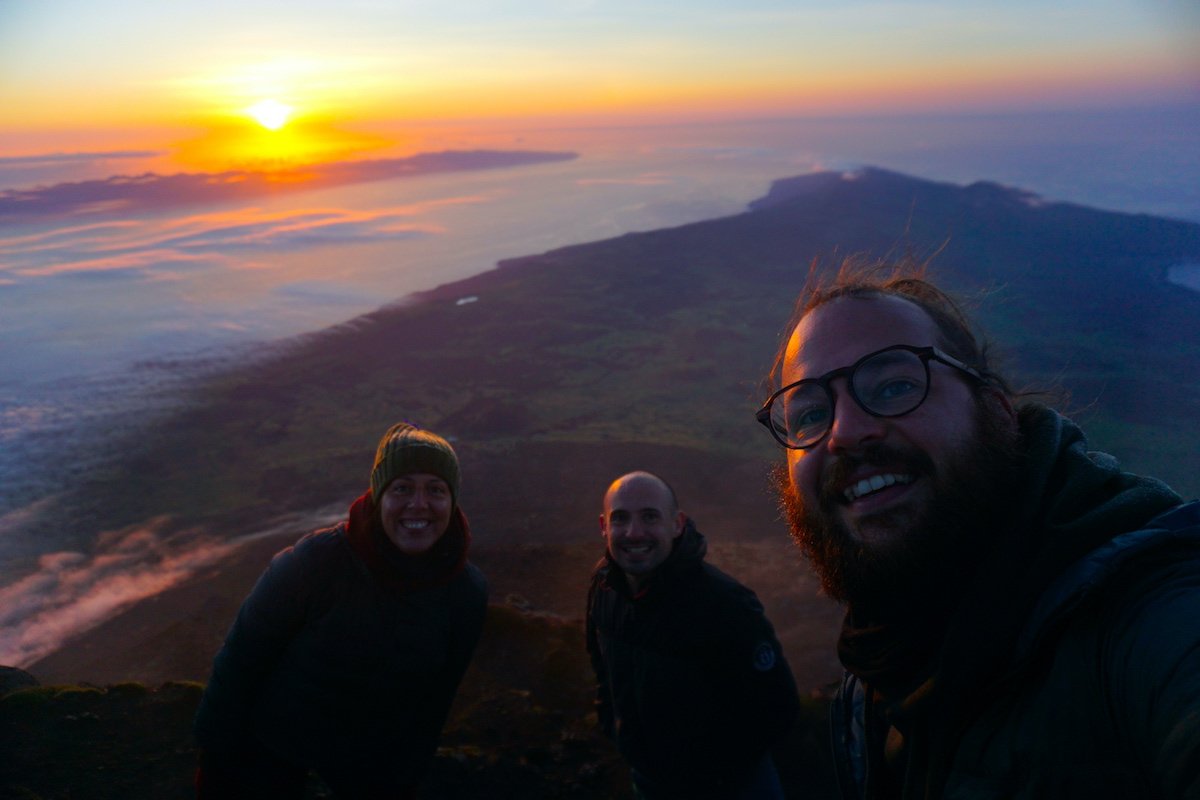
When to visit Pico
The best months to go to Pico are from May to October, trying to avoid July and August which are the months with more tourism. June and September tend to be the best months, with good weather, still appetizing waters, and less overcrowded tourism. For the ascent to the mountain it is also usually better in spring and summer but be careful with July and August! as the permits to climb Piquinho are sold out and it is necessary to book in advance.
April and May are usually the best months for whale watching (with the possibility of seeing the great blue whale).
In terms of climate, summer is undoubtedly the best time, with higher temperatures, less chance of rain, and the possibility to enjoy more of its natural pools. In any case, the weather in Pico (and in the Azores in general) is very unstable so there are no guarantees at any time of the year (it is often said that you can have the 4 seasons in one day).

Pico weather chart with temperatures and rainy days by month:
| Month | Average temperature | Average temperature (water) | Rainy days |
|---|---|---|---|
| January | 15º | 16º | 10 |
| February | 14º | 16º | 9 |
| March | 15º | 16º | 9 |
| April | 15º | 16º | 8 |
| May | 17º | 17º | 6 |
| June | 19º | 19º | 5 |
| July | 21º | 22º | 3 |
| August | 23º | 23º | 5 |
| September | 22º | 22º | 7 |
| October | 19º | 21º | 10 |
| November | 17º | 19º | 10 |
| December | 16º | 17º | 12 |
| Month | Average temperature | Average temperature (water) | Rainy days |

In addition, if you like music festivals and other types of art, in June there is the Azores Fringe Festival (organized by Terry Costa’s MiratecArts, which in addition to the island of Pico also includes events in the rest of the islands of the Azores archipelago) and in August the Cais Agosto.
During our visit to Pico, we were lucky enough to coincide with the opening of the Azores Fringe Festival 2021, at the Miratec Arts venue, where we were able to see different works of art on display, attend mini-concerts, taste local wines and cheeses, and even enjoy a queimada galega!

How to get to Pico
There are only direct flights to Pico from mainland Portugal, so if you are coming from another country you would have to fly to Ponta Delgada in São Miguel (or to another island if there is a direct connection with your country of origin) and from there fly with Sata, the regional airline of the Azores, to Pico.
The alternative and what is usually cheaper is to fly from within Portugal, which has low-cost flights to Terceira/São Miguel (and once there with Sata to Pico) or even a direct connection between Lisbon and Pico with Sata, which if you match the dates (there are only flights a couple of days a week) is usually the fastest and cheapest option.We recommend you be flexible with dates and use price comparators like Skyscanner and Kiwi.com (which include Sata flights).
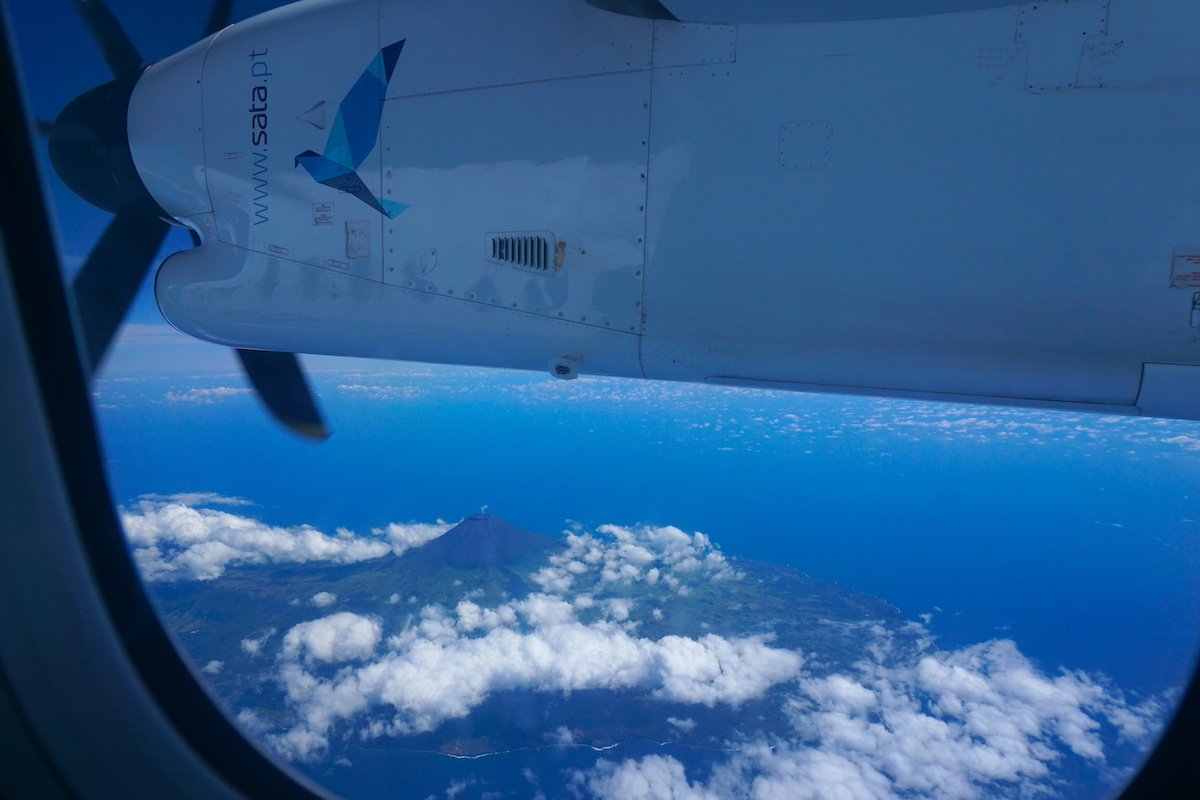
Another option to reach Pico is from one of the neighboring Azorean islands by boat, there are 4 lines that pass through Pico:
- From Faial, the nearest island, it takes only 30min (3.6€), and there is a connection every day all year round (several boats per day, more frequencies in summer). All lines do this route
- From São Jorge, it takes 1h30 (10.50€), also every day all year round. 3 lines make this route
- From Graciosa and Terceira there is a connection but much more limited and only in summer (with a stopover in São Jorge), two days a week. Two lines make this route

You can check boat schedules and purchase tickets at https://www.atlanticoline.pt/ (although schedules and routes are usually much better explained here).
Here is a map with the 4 lines (blue, green, purple, and white) that connect the 5 islands of the central group of the Azores:)

If, like us, you arrive by boat, there is a special magic in having to cross a kind of maritime gateway formed by the islets Madalena, Ilhéus Deitado (lying islet), and Ilhéu em Pé (standing islet).
How many days to spend in Pico
We recommend a minimum of 3 days, although the ideal for Pico is between 5 days and a week to enjoy everything it has to offer, take the opportunity to relax in its natural pools if you travel in summer and have a margin in case any of the plans are canceled due to the weather. For this reason, we propose different types of itineraries, of more or fewer days.
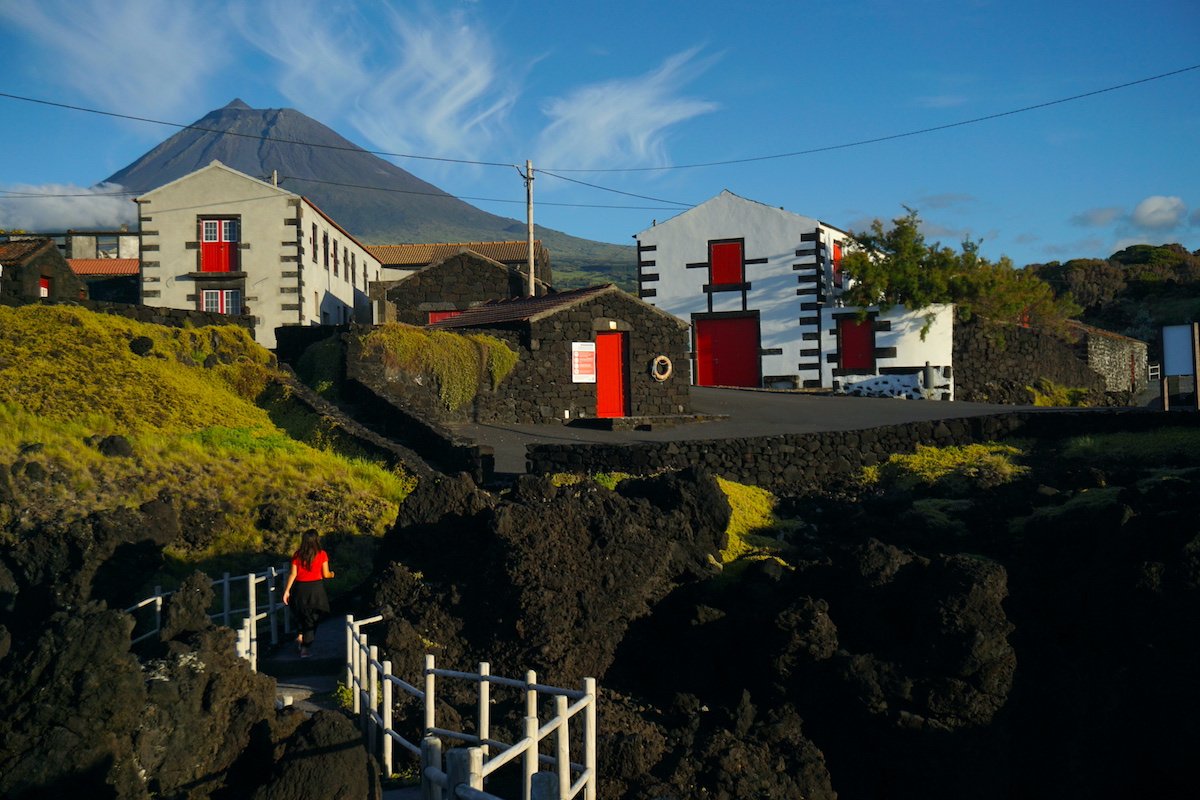
Things to do in Pico
Here we leave you a summary of the places of interest to visit in Pico, and below you have the map and specific information about each place.
Things to see and do in Pico
- Climbing Piquinho, the highest point in Portugal
- Contemplate the vineyard landscape among volcanic rocks, sea, and windmills (Unesco heritage) and taste delicious white wine.
- Enter Portugal’s largest lava tube and understand how the Azores were formed
- Greet dolphins and whales in the wild from a boat
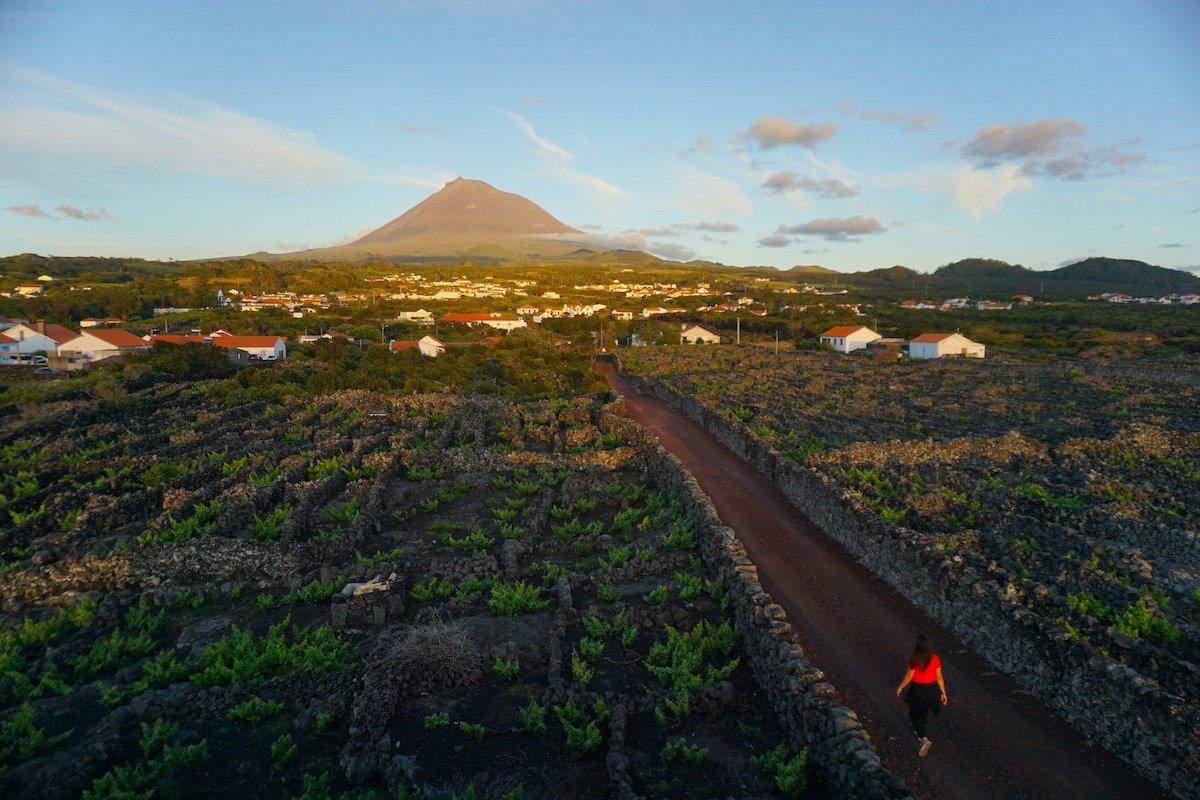

Map of Pico
Here we leave you all the places of interest in Pico that we talk about in this guide on a Google Maps map that you can carry on your smartphone to check at any time.
Here is also a tourist map with the roads of Pico (click on the image to download it in larger size and resolution).
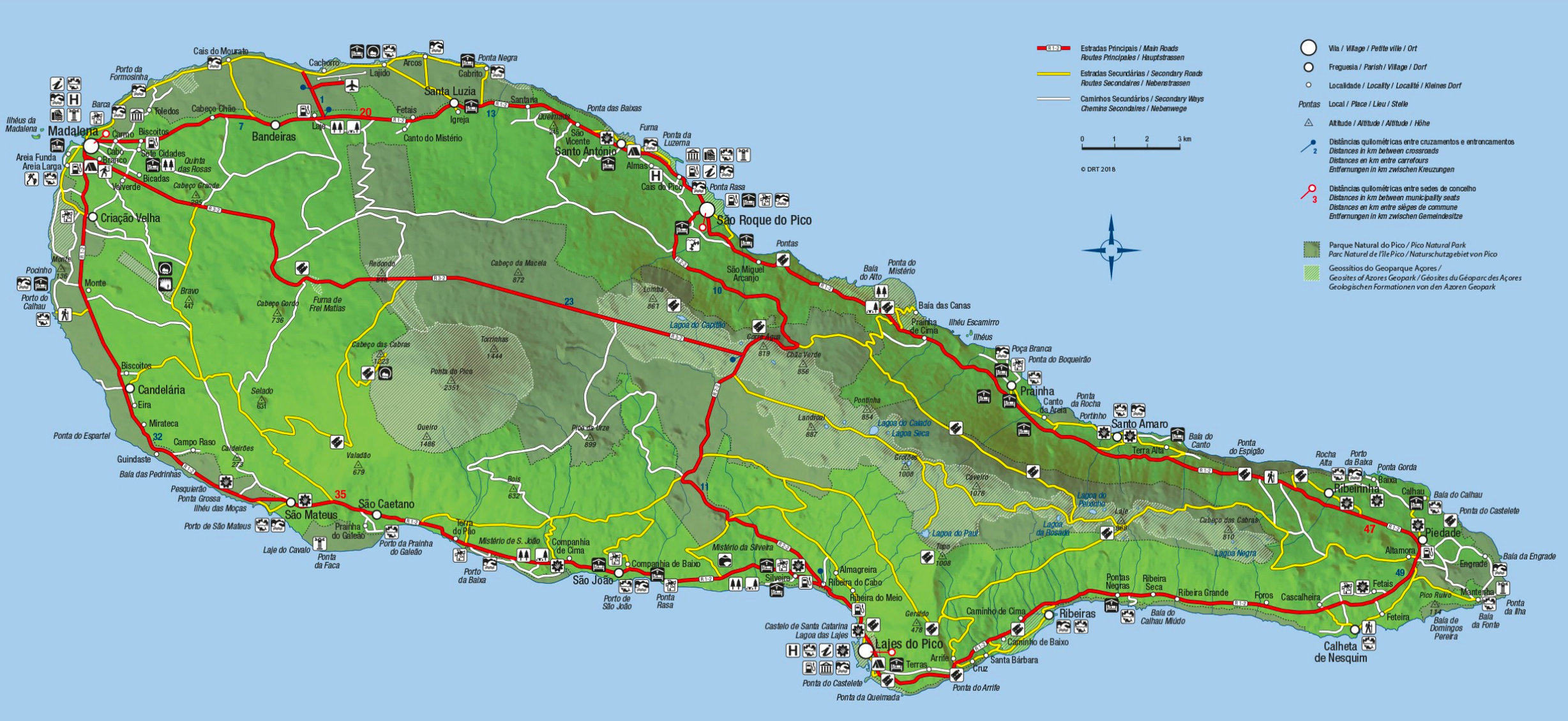
Climbing Piquinho, the highest point in Portugal
Surely one of the reasons that attract more people to the island of Pico is the ascent to the 2351 meters of the highest mountain in Portugal. Let’s start by clarifying the nomenclature we learned on the island: Pico is the island; the mountain of Pico, is the mountain; and the peak of the mountain, the Piquinho (in Portugal we love diminutives). As we were told in our days out there, these are the correct terms so you won’t be surprised if someone local corrects you with a mischievous smile when you say you want to “climb Pico” when what you really want is “climb the Mountain” or “climb the Piquinho”.
Important! Especially in summer, due to limited capacity on the mountain and increased demand, we recommend that you book your climb to Piquinho as far in advance as possible.
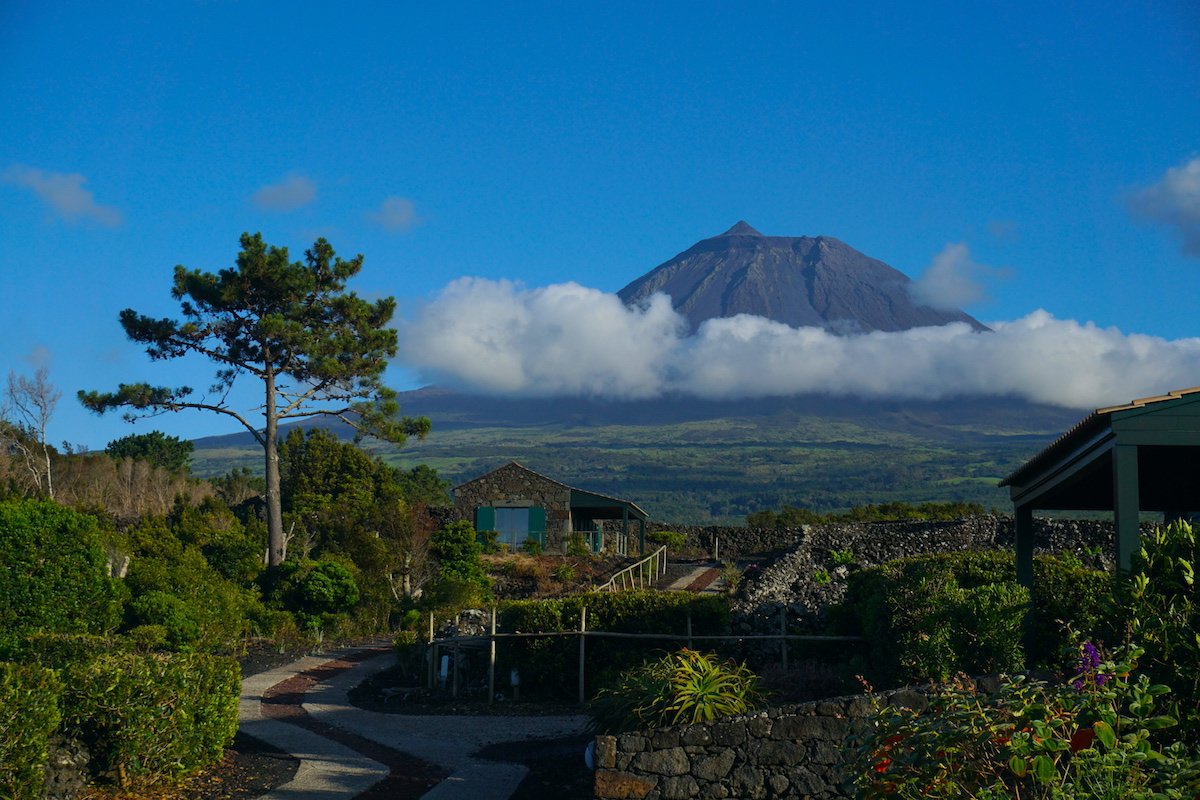
The “Piquinho” – the highest point of the Pico mountain – is thus, with its 2351 meters, the highest point in Portugal. To reach the Piquinho you have to pass through 47 poles (wooden stakes), some more difficult than others due to the orography of the terrain or how steep it is. It is actually a climb of 1121 meters from the Casa da Montanha (which is 1230 meters above sea level and from where you will start) to the Piquinho at 2351 meters, a total of 8 km (4 km uphill and 4 km downhill) difficult by a volcanic stone terrain, in some parts slippery and steep, between rocks and loose volcanic stones, for which a good physical condition is important.
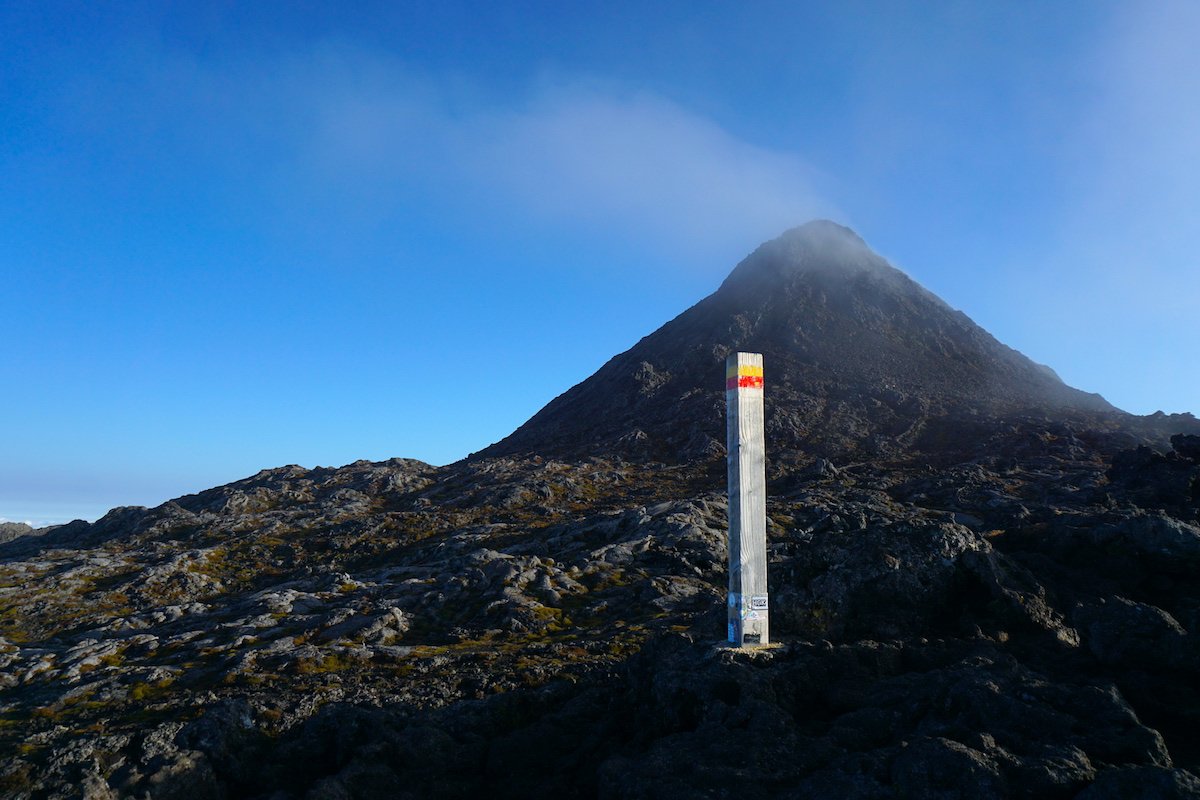
To climb the mountain of Pico there is a maximum capacity of ascent and descent of 320 people per day, 160 people simultaneously, so you have to book your ascent in advance (as soon as possible, especially if you go in high season) at the Casa da Montanha. This mandatory point of passage before starting the ascent aims to give you information, recommendations, and rules, register and control who makes the ascent and descent of the mountain and give you a GPS, essential for a possible rescue. You can do the ascent with a certified guide or do it on your own, although we recommend doing it with a guide (see below for more information on why).

How to get to Piquinho: How to climb the Pico mountain
There are 3 ways to climb the mountain of Pico:
- Daytime: You go up and down during the day. Normally you start between 7:00h and 8:30h in the morning, depending on the season and weather conditions. Approximate duration: 8 to 9 hours.
- Nocturnal: You go up at night, see the sunrise at Piquinho and come down in the morning. You usually start the climb between 1:00 and 3:00h (depending on the time the sun rises), enjoy the sunrise, and arrive down around 12:00h. Approximate duration: 9 to 10 hours. This was the one we chose, we tell you below why we recommend it.
- Overnight: You go up in the afternoon, around 16:00h, watch the sunset at the top, go down to the crater of the volcano to camp and spend the night, go up and watch the sunrise on the Piquinho and go down for the day arriving at the bottom around 12:00h. In this mode, keep in mind that apart from the difficulty of the climb, you will have to carry the weight of all the camping equipment (tent, mattress, food, etc.) and the cold at night. Approximate duration: 20 hours.

Climbing Pico mountain: with a guide or on your own?
Regardless of the modality you choose (day, night, or overnight), we recommend the ascent with a certified guide for several reasons:
- The path, always on volcanic rock, can be quite slippery and is the same for going up and down except for a small stretch that has two variants (the descent seemed to us to be very hard, worse than the ascent): there are times when the hands have to help the feet and others when the trekking poles are our best friends. To know when to use the hands and when to use the poles, the guide’s inputs are essential.
- The weather conditions in the mountains are harsher than at sea level: it is colder (about 10º less) and if there is sun, there is no shade. In addition, weather conditions can change drastically during the ascent or descent (wind, rain, fog) making the route more difficult. The guide has already done the ascent and descent in various weather conditions and will know how to help you do it in the best possible way, mentally and physically.
- Even someone with mountaineering experience does not know the particularities of this mountain and the tricks of the guide who knows the mountain like the back of his hand, which are priceless.
- If you do it with a guide there will be a lot of other information about the endemic flora and fauna and about the history of the island that you would not learn on your own.
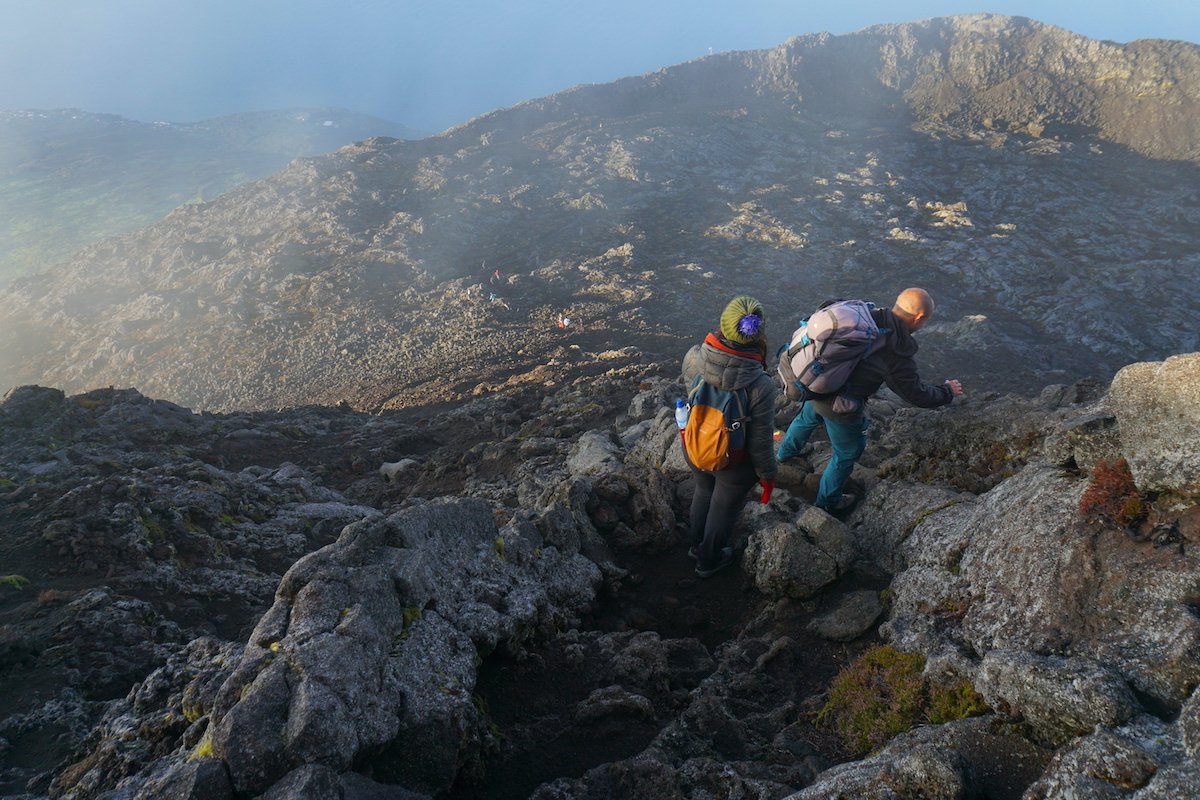
That said, if you feel that you could perfectly well do both the ascent and descent on your own, when you inform Casa da Montanha that you intend to do it this way they will tell you how the weather conditions are forecast above and for the next few hours and whether or not they recommend doing it.

If you go up with a guide, the mandatory reservation and payment at Casa da Montanha prior to the ascent are included in the price and will be managed by that person/agency. If you climb on your own, you will have to make your own reservation and payment at Casa da Montanha: here are the contacts, and here are the rules of conduct. For example, it is completely forbidden to step outside the marked route or to camp (you are only allowed to spend the night in the crater if you have communicated and paid for it). Here are the other rules of conduct.

Prices: how much does it cost to climb Pico Mountain?
- Climbing Pico Mountain with a guide (includes the climbing fee and its management, insurance, and Certified Guide):
- Day climb costs between 50€ and 75€/person;
- Night climb costs between 75€ and 89€/person;
- Overnight climb costs between 120€ and 140€, depending on the agency and the season.
- Climbing Pico mountain on your own: at Casa da Montanha you will have to pay the ascent fee:
- ascent to the crater: 15 € ;
- ascent to the 2351 meters of altitude of Piquinho: 25 € ;
- ascent with overnight stay in the crater: 35 €;
You can see the prices on the Casa da Montanha website here. If you are a resident of the Azores you will not have to pay the fee but it is still mandatory that you register and bring your GPS.

Recommendations and rules of conduct
- Someone at Casa da Montanha (in case you go on your own) or your guide (in case you do the route with a certified guide) will give you a briefing and a GPS that you will carry in your backpack. The GPS is very important (never take it out of your backpack) because in case something goes wrong and you can’t finish the route on your own, with the GPS you can communicate and ask to be rescued. Be careful! The rescues are not done by helicopter as you might imagine, they are a group of volunteer firefighters who go up with the equipment and bring you down on foot. Besides, it is not cheap and if you have broken any of the rules, you will have to pay for the rescue out of your pocket… Also, keep in mind that inside the crater there is no coverage or communication so if you stay overnight and want to communicate, you will have to leave the crater to get coverage.
- If you have knee and/or heart problems, if you have never done anything of this type, and/or are not physically fit, do not force this ascent and descent on your body. Do not force a rescue!
- It is expressly forbidden to collect or destroy plant species or geological formations; leave any type of waste on the mountain; travel off the marked route; interrupt the tranquility of the place; make bonfires; use bicycles or any motorized vehicle; practice sports that may disturb the ecology and geology of the Mountain or any act that disturbs the ecological balance of the place; and camping, except for overnight stays in the crater with prior payment and permission from the Casa da Montanha.

Essentials: What to pack for climbing Piquinho?
- Trekking shoes, we have these from Columbia.
- Waterproof raincoat
- Light warm jacket (if it can be waterproof, the better)*.
- Comfortable / mountain pants
- Sweatshirt
- Thermal T-shirt and leggings*.
- Neck Brace
- Hat and gloves*.
- Socks (a spare pair)
- Cap, the sun is very strong
- Trekking poles: if you do it with a certified guide, ask beforehand if they have poles available that you can use since, sometimes, due to inexperience, the poles we have are not the most suitable.
- A water bottle like one of these to carry water with you at all times. Plus, you’ll avoid using single-use plastic.
- Reef friendly sunscreen, i.e. free of coral-damaging chemicals, oxybenzone-free, and not tested on animals, such as this one or this one.
- Never remove the GPS that you get at Casa da Montanha from your backpack.

*This is a list based on the night climb. Some of the items in this list will not be necessary for the day climb (as it will not be as cold), but keep in mind that regardless of the time you go, at 2351 meters altitude it is always a little colder. If you also choose to spend the night in the crater, you will have to add to this list everything you need for the overnight stay: tent, mattress, food, more water, etc. If you do it with a certified guide, the overnight equipment is usually included in the price so you will not have to bring everything you need for the overnight stay on the plane on your trip to the island (except if you do the climb on your own).
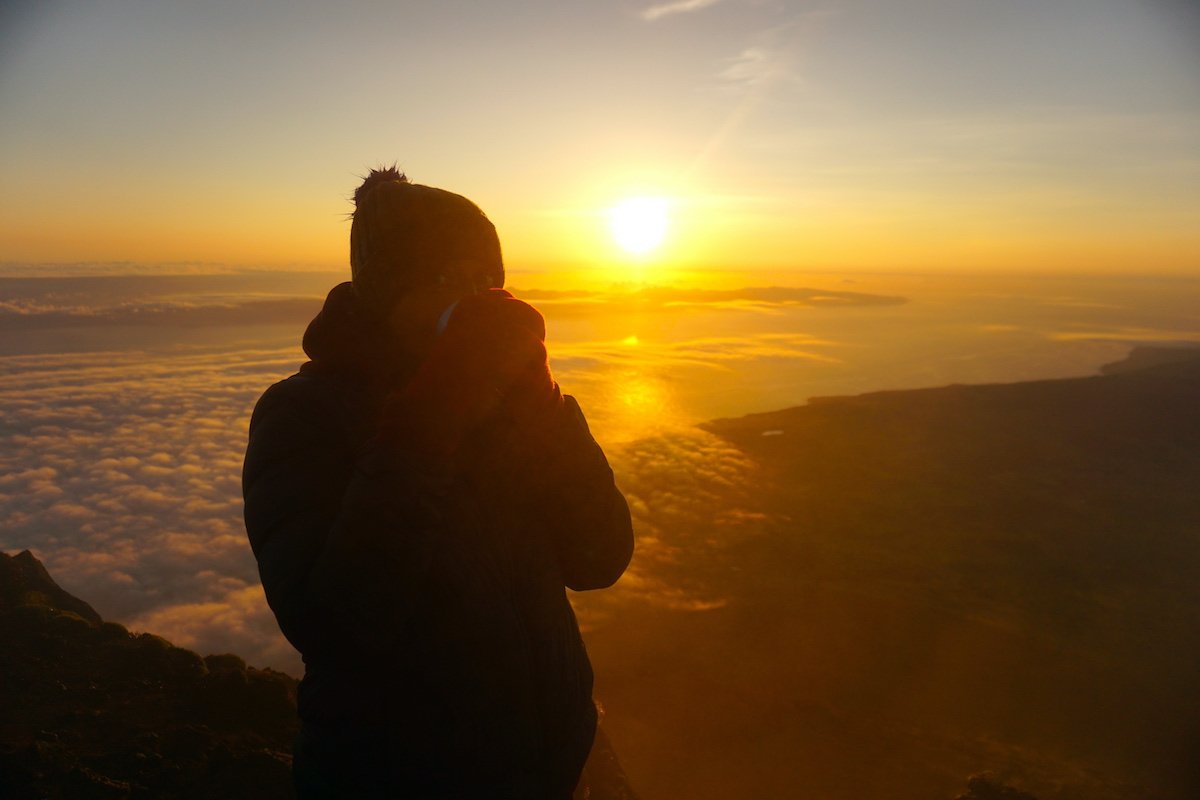
Our experience: the night climb with Atipico
We did the adventure of climbing (and descending) to the highest point of Portugal with a certified guide, in this case with Nuno from Atipico and we loved it. Monica and Nuno (the founding couple of Atipico) are amazing so if you have already decided to do the climb with a guide, don’t hesitate! You can check their website here, email them directly at atipicoazores@gmail.com or phone/whatsapp them at +351 919 991 776.
Important! Especially in summer, due to limited capacity on the mountain and increased demand, we recommend that you book your climb to Piquinho as far in advance as possible.
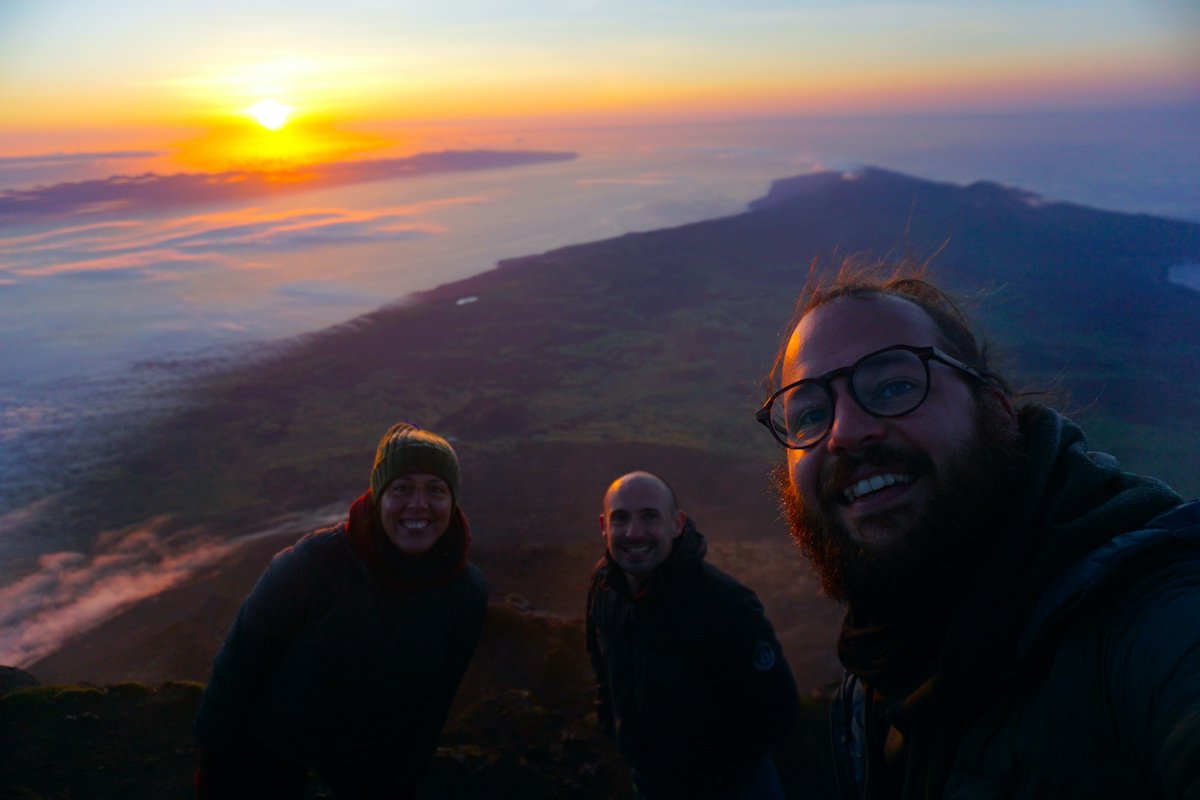
Finally we chose to do the night climb because we wanted to see the sunrise on the Piquinho and the overnight stay did not convince us for several reasons. After doing it, we recommend the night climb because:
- We did not carry the extra weight of the overnight equipment or spend several hours cold at night.
- Going up at night seemed “mentally” more appropriate: we did not know “how much” we had left to go.
- We enjoyed the incredible sunrise
- We went down a couple of hours after going up, so our legs had not “cooled down” too much and when the normal “discomfort” appeared we were already down.

This decision, like everything we publish, is an opinion based solely on our personal experience. We are not saying that sleeping in the crater of the volcano that hides the highest point of Portugal is not magical, but we think it is important to point out the extra weight and the cold at night: we did not want to count on the guide having to carry our backpack because we could not carry it anymore (as we were told it happened in other cases) or to be too cold at night to see the sunset when we could see the sunrise without extra weight or hours of cold.
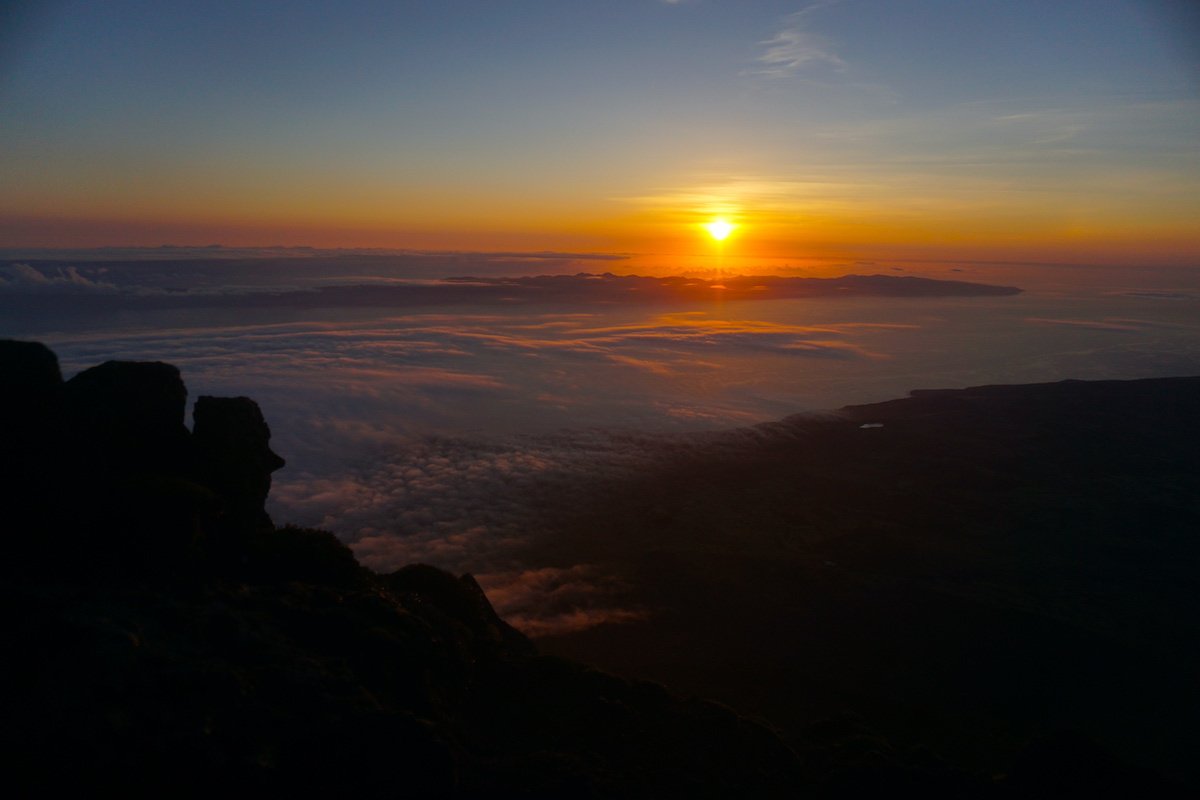
We met Nuno at 1:30 in the morning at Casa da Montanha and our intention was to have slept a little more that night to go with strength… Although we went to bed at 21h00, the excitement of what we were about to live was too much for us. We climbed for 3h30 with a few stops but the fact that we were constantly talking about travel with Nuno, with whom we discovered we had many affinities, made the ascent of the 47 poles lighter. The starry sky looked amazing and the moon was almost full so that sometimes we didn’t even need the flashlight on our heads (with a new moon the sky will be even more amazing).
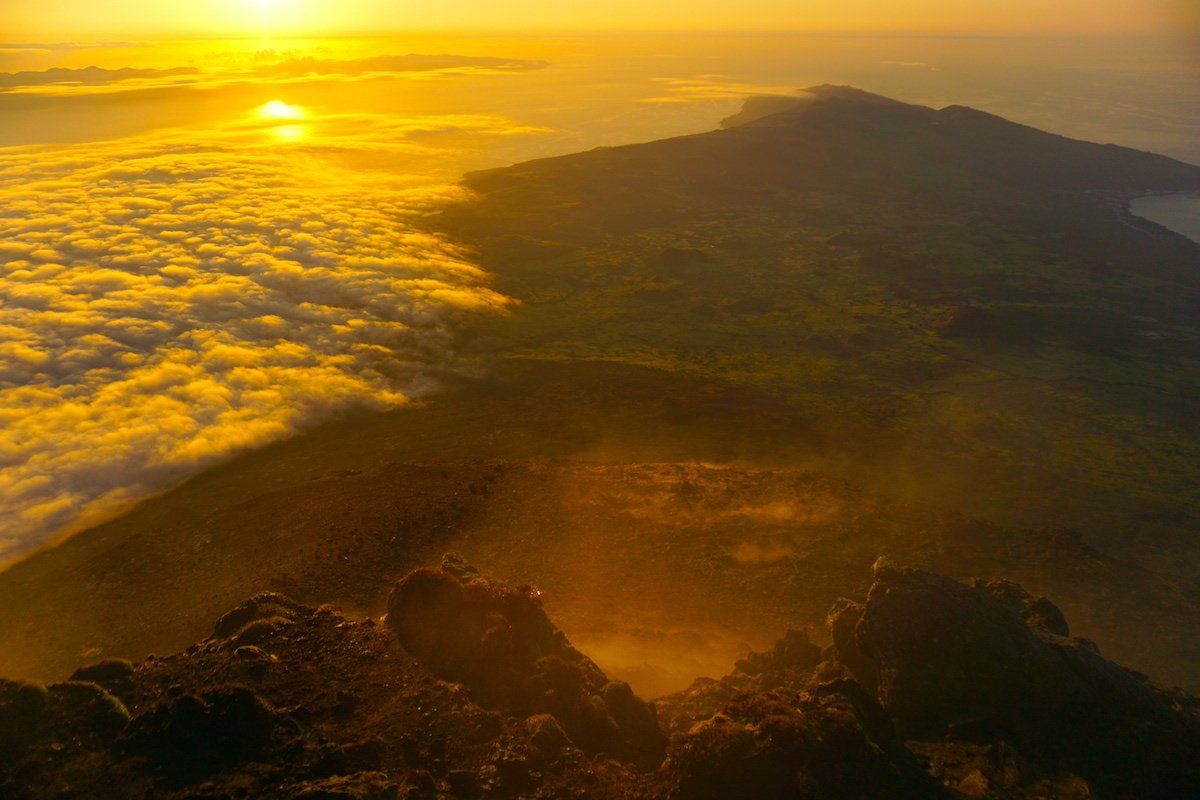
To reach the Piquinho we have to overcome a climb with 40º of inclination, the only thing that explains that there are people who, when they reach the crater, get tired and stay there without reaching the Piquinho. Already at 2351 meters, at the highest point of Portugal, we waited in the warmth that came out of the sulfur-rich fumaroles of the mountain of Pico. Although the last eruption took place more than 300 years ago, in 1718, the mountain is still active.

Finally, the sun began to rise timidly and we enjoyed what is, to this day, one of the most special sunrises we have ever enjoyed in our lives. Slowly the clouds gave way to a beautiful landscape in which an orange light was tinting the neighboring islands that we were lucky enough to greet from above: Faial, São Jorge, Terceira (which is not usually so common to see) and even the flickering of the lighthouse of Graciosa! We were able to glimpse the five islands of the central group of the Azores.

Nuno offered us a hot tea to toast to such a spectacle (and even some Néveda, a typical local liquor, brought by another of the guides we met at the top) and, when our minds and hearts were full of beauty and the feeling of the challenge achieved, we started the descent before our legs got too cold.

Despite the incredible landscapes, we found the descent harder and more difficult. For this reason, it took us longer to go down than to go up: 4 hours. The terrain is slippery and steep and you have to be very concentrated at all times to avoid slipping and falling. We are aware that Nuno’s tricks (and talks) were essential to arrive safely and happily at the bottom.


Randomtrip scale of difficulty: Difficult. Although it is “only” 8 km in total, 4 km uphill and 4 km downhill (harder than the uphill, in our opinion), it is a difficult route both because of the volcanic stone terrain, sometimes slippery, the slope (especially the 40º slope before reaching the Piquinho when you already feel tired) and the weight on your knees when descending. It is essential to use good trekking boots (better boots than sneakers to protect the ankles), a warm jacket for Piquinho and, in our opinion, to do it with a certified guide.

The experience of touching the sky from the highest point of Portugal is one of the most special experiences we have had in our travels. The days that followed after having greeted “the mountain” from its highest point were of absolute attraction. Every time we looked at it from below, it seemed almost unreal that we had been up there. It wasn’t just the feeling of self-improvement, the reflection of repositioning our smallness before the immensity, or the incredible experience of starting a new day from the highest point in Portugal. There is something about the mountain of Pico. Something magnetic which makes that wherever you are on the island (or even on neighboring islands where it is possible to greet him), whatever time it is, you want to know how it is. Sometimes it wears a hat, sometimes a scarf, sometimes it is completely covered with a blanket of clouds, and sometimes it strips naked and shows himself in all his splendor.
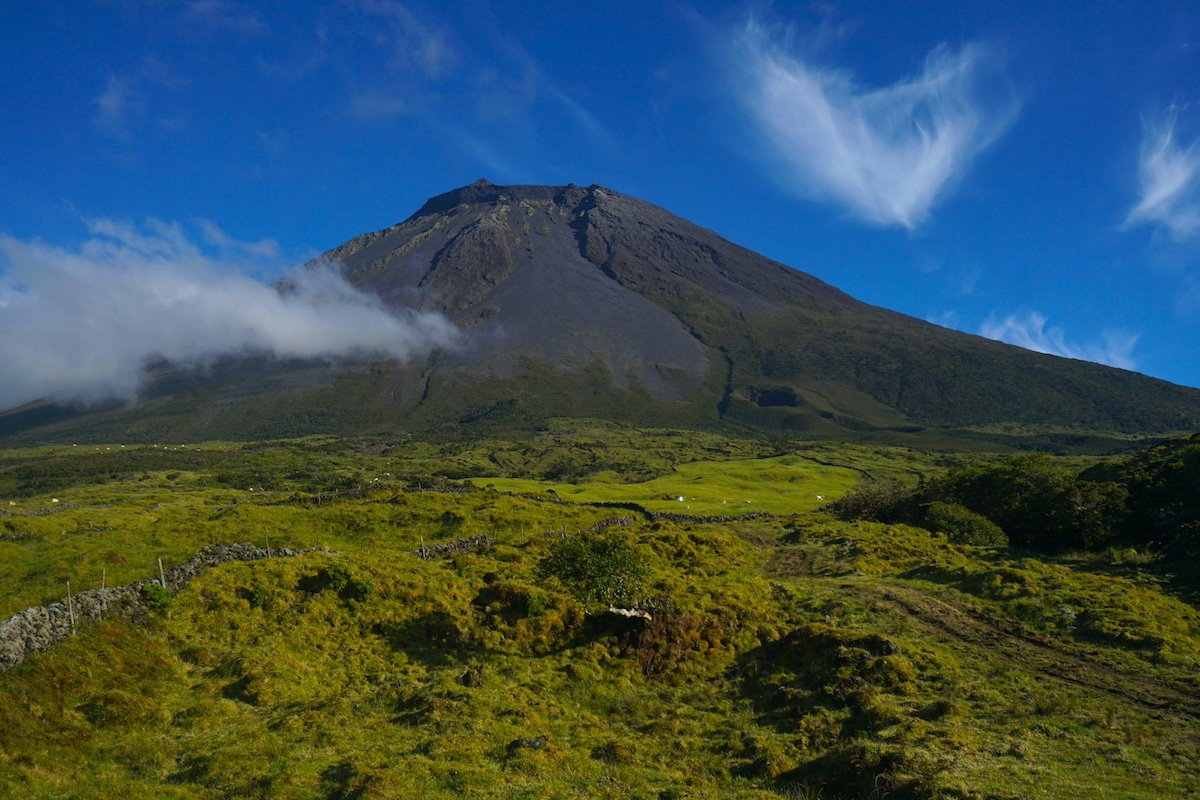
In case Atipico does not have availability for your dates, you can book the day climb to Piquinho here or the night climb here.
EN-3 Longitudinal Road and the Pico Lagoons
Considered the most beautiful road in Portugal for many, it is one of the best places to appreciate the magnetism and grandeur of the Pico Mountain with a car, during a 23 km road linking Madalena to São Roque do Pico and one of the longest straight roads in the Azores, 9 km long.
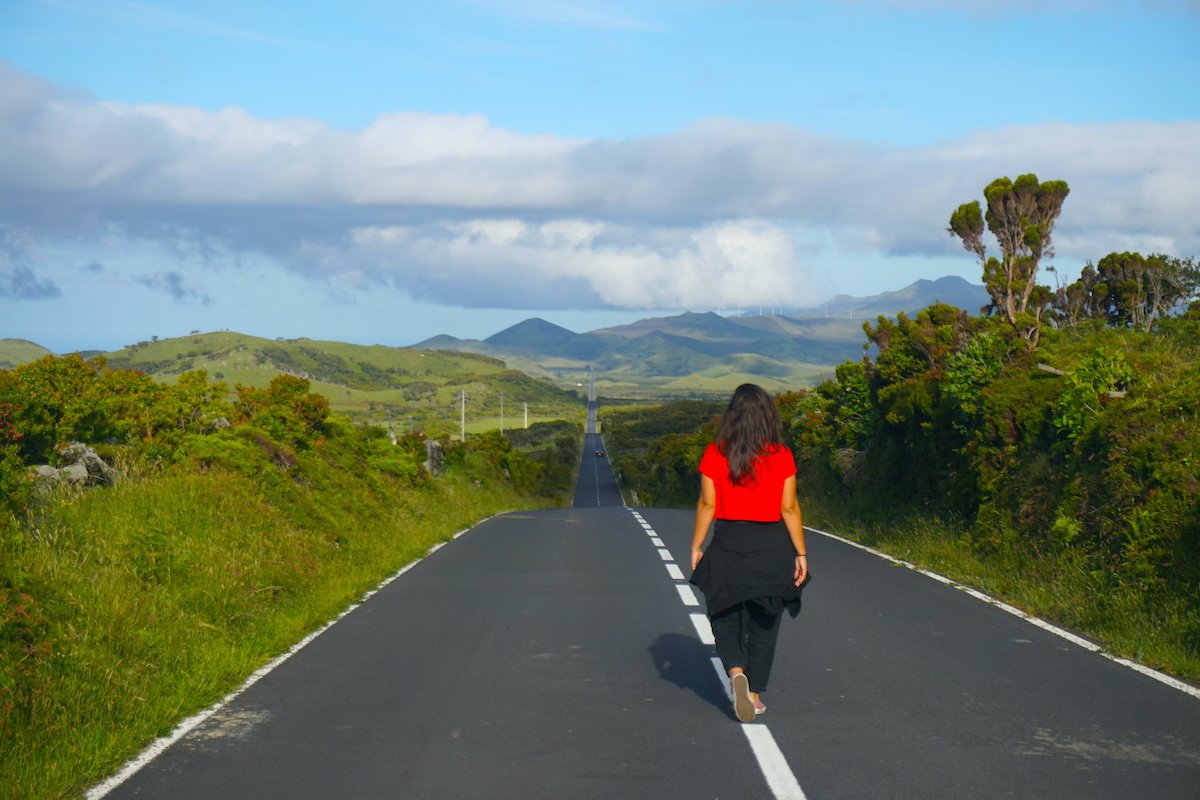
The EN3, known as longitudinal road, passes through the interior of the island and besides greeting the Pico mountain from the window, if you continue along the interior roads once it ends you will reach the most beautiful lagoons of the island: Lagoa do Caiado, Lagoa do Capitão, Lagoa do Paúl, Lagoa do Peixinho, Lagoa Rosada and, finally, Lagoa Seca. In our case, we made two attempts to see them but on both occasions the fog accompanied us and prevented us from enjoying them as they deserve. Fortunately, we still managed to catch a glimpse of Lagoa do Caiado the first time and Lagoa do Capitão the second time. Be careful, drive slowly on these small access roads to the lagoons, as they are not in excellent condition (they have potholes and holes to avoid).

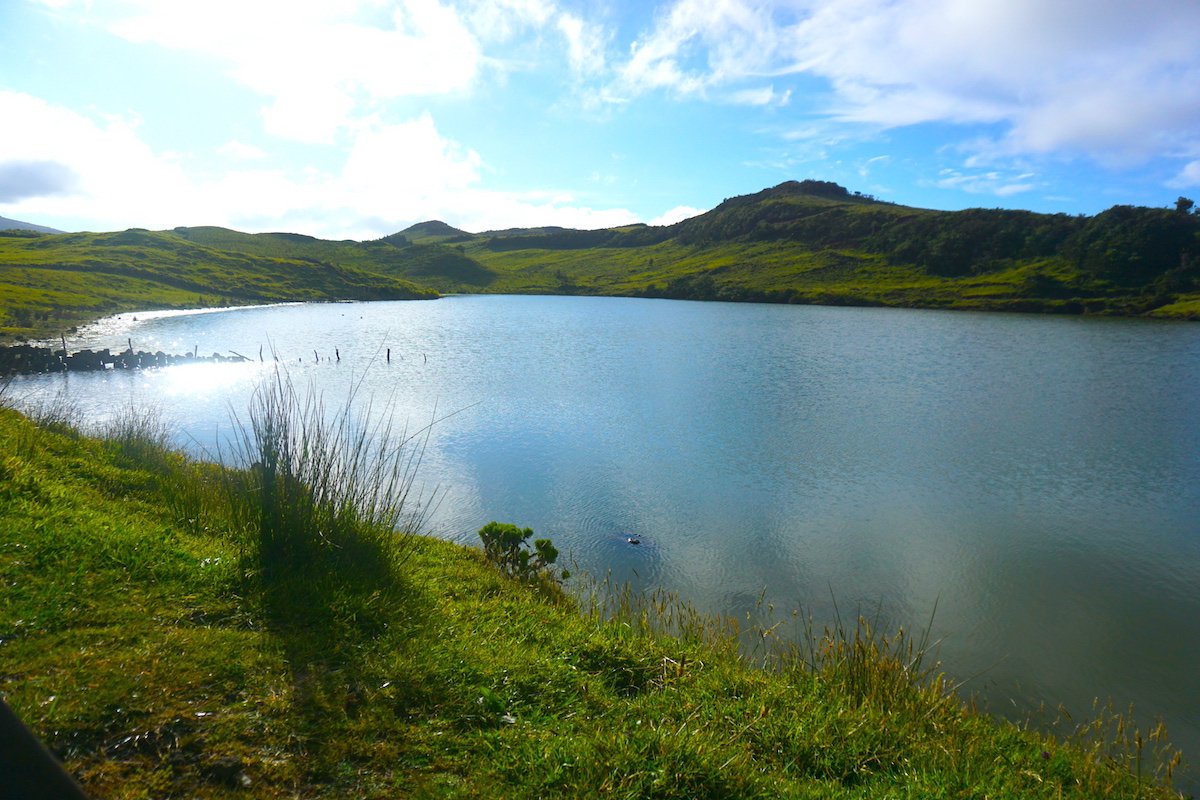
The best thing, undoubtedly, is to enjoy the sunset on the road in the company of the mountain of Pico who, with luck, will be your co-pilot.
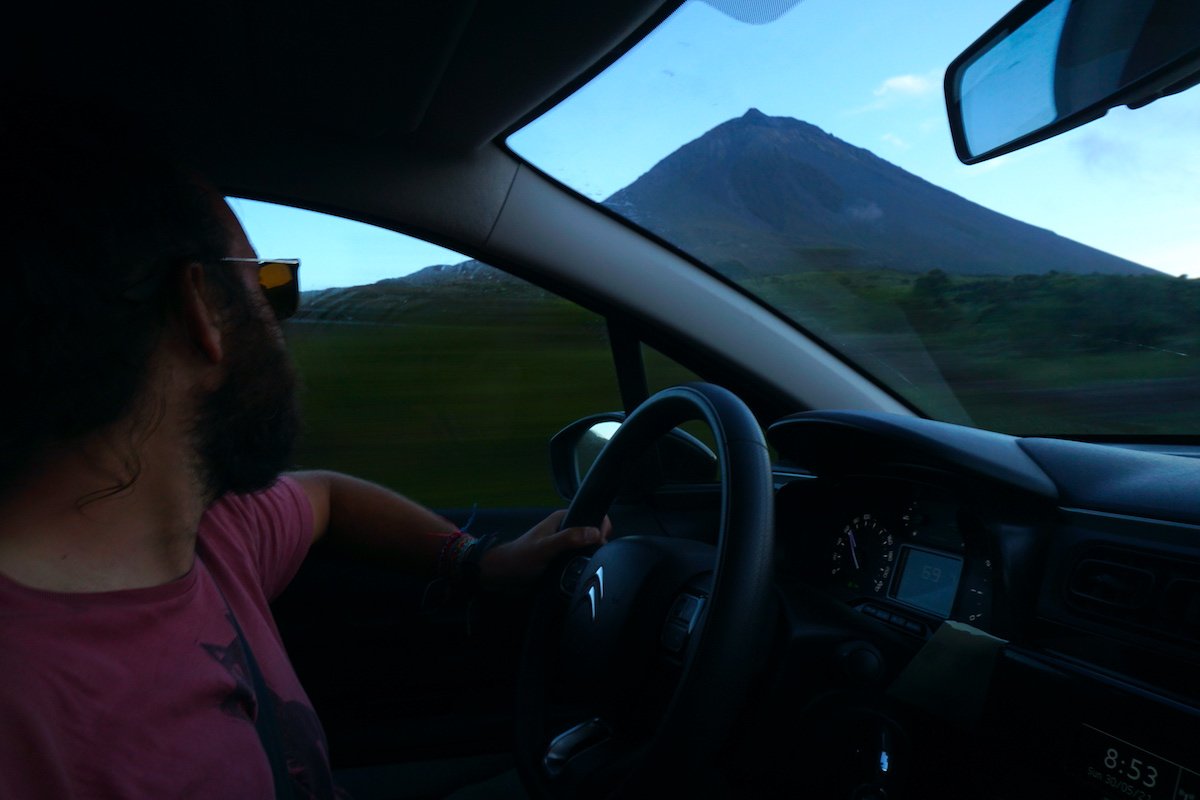
Where the EN-3 ends and the small roads that go to the lagoons begin, you can make a small detour to this viewpoint to appreciate the views of the Atlantic and the neighboring island of São Jorge.
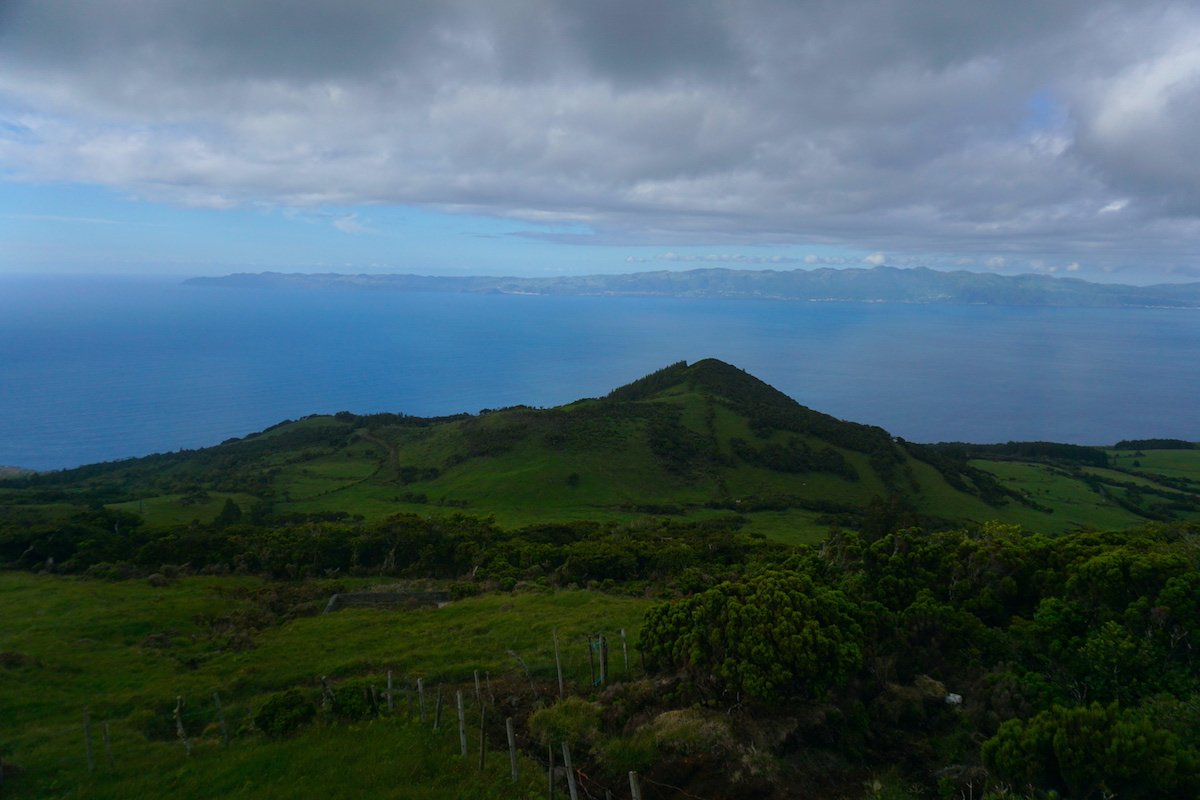
Lajido
In Lajido the volcanic black contrasts with the lava red and perhaps that is one of the main reasons for having become one of our favorite areas of the island and where we chose to base ourselves, in a beautiful volcanic cottage among vineyards overlooking the mountain of Pico (with jacuzzi and pool!).
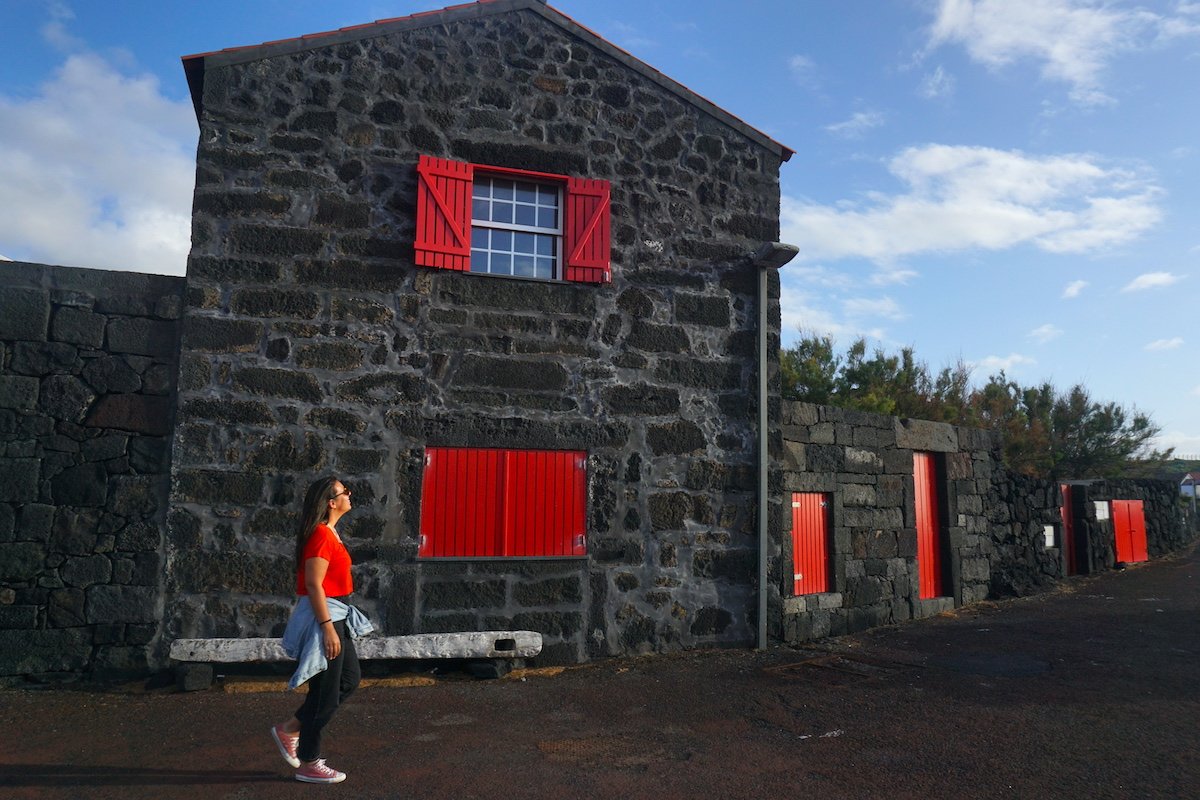
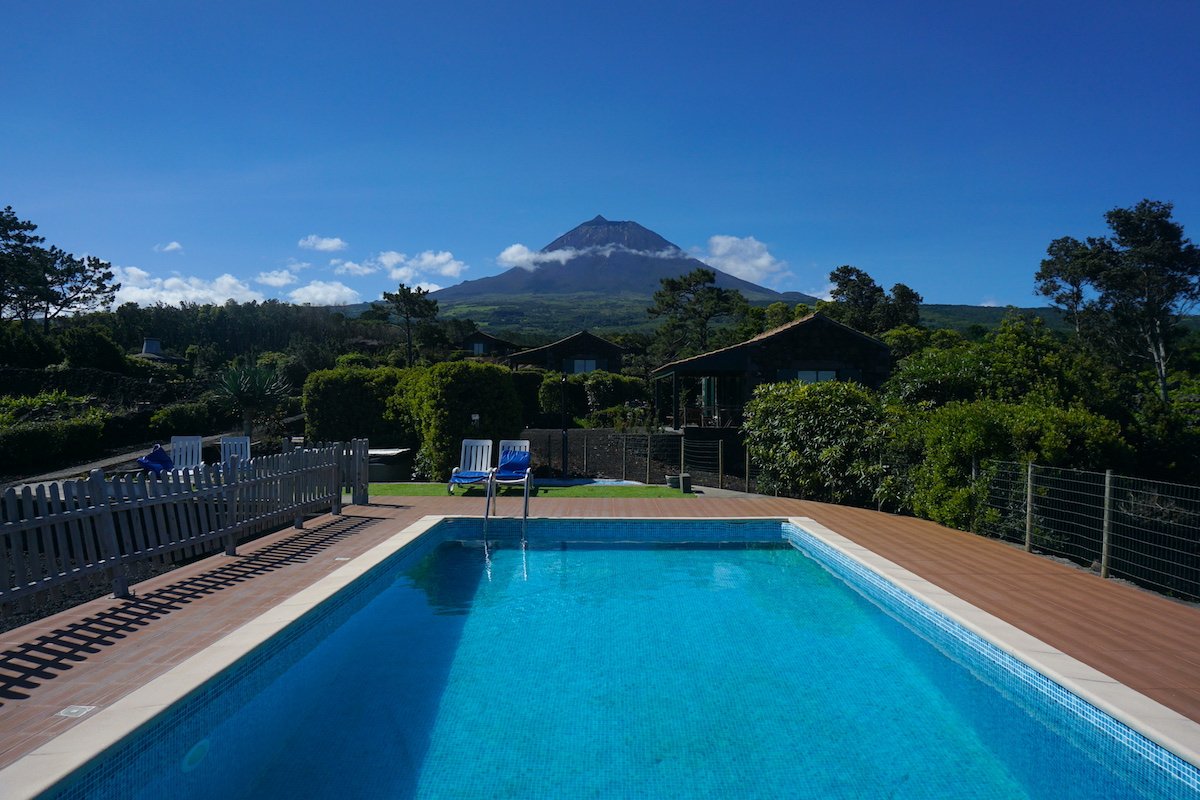
Pico Island, the youngest of the nine islands of the archipelago (estimated to be about 250,000 years old) has had four recent eruptions (between 1500 and 1700). These recent eruptions, whose lava flows modified the terrain, were called mysteries by the local people because they were incomprehensible and mysterious and could not be explained. When they turned to the priests asking what they were about, they answered that they were “mysteries of the Lord” and so these eruptions were baptized like that in the whole archipelago (in fact we also talked about them in our guide to the island of Terceira). There are four mysteries that correspond to these four recent eruptions and Lajido is part of one of them, the mystery of Santa Luzia, whose eruption occurred in 1718.

The name Lajido comes from a type of lava flow (pahoehoe), a mantle of fluid lava, emitted by a volcano during its eruptions and solidifying afterwards.
The four Mysteries – the name by which the lava fields of the four recent eruptions became known for lack of a better explanation – are Prainha (eruption occurred between 1562 and 1564), Santa Luzia (1718), of which Lajido is a part, São João ( 1718) and Silveira (1720).
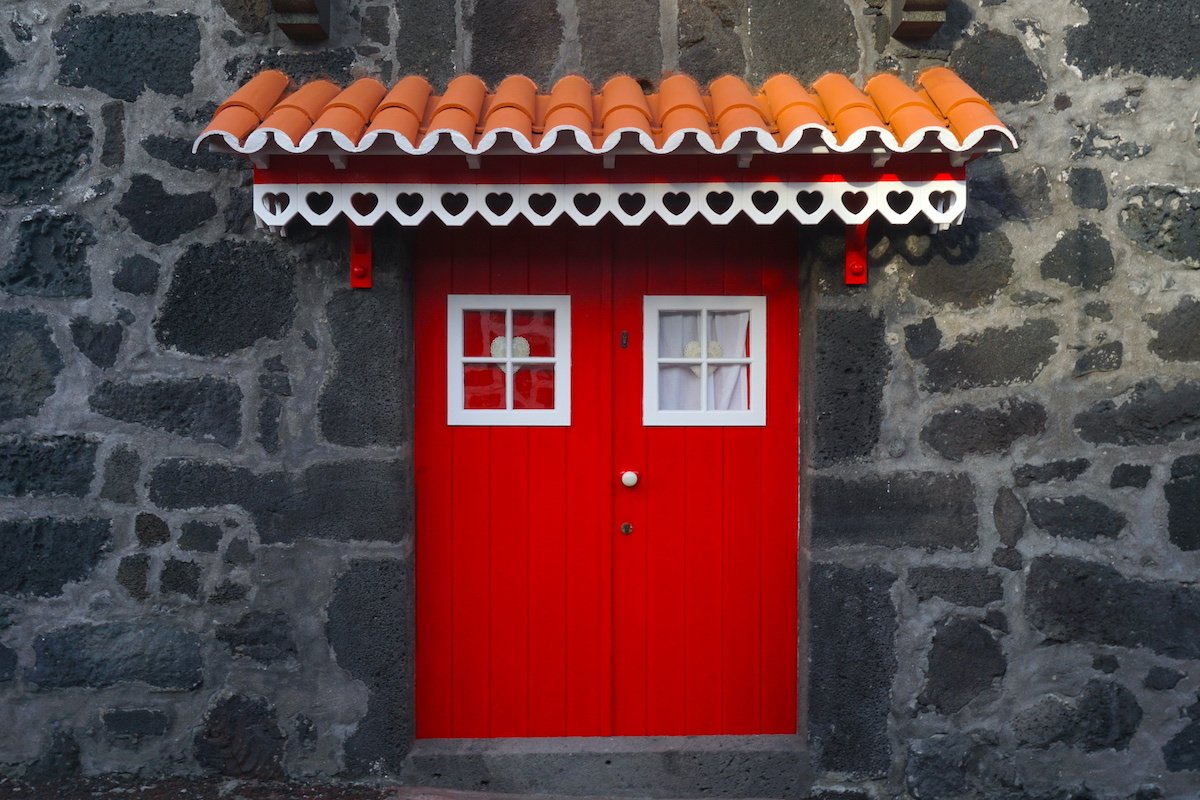
Lajido hides, in addition to its beauty and volcanological importance, several reasons why it is worth knowing it calmly. One of the plans is simply to stroll through the beautiful and small network of narrow streets between black and red houses with vineyards on one side, the ocean on the other and the mountain that overlooks everything. As an anecdote, I would like to tell you that although all that surrounds you here is the sea and vineyards, in the only bar we found in Lajido where we wanted to enjoy a glass of picaroto wine – Bar do Lajido – it turned out that it only had bottles of beer and, for wine, a red wine from Palmela (Setúbal) in mainland Portugal. To enhance the anecdote, Bar do Lajido’s logo features a bunch of grapes, clearly visible on its sign at the entrance. It is a local bar where you can feel the pulse of Lajido’s Azorean authenticity despite the growth of rural houses dedicated to tourism in the area.


The other two reasons to come to Lajido are two interpretative centers, one next to the other, Casa dos Vulcões and the Centro de Interpretação da Paisagem da Cultura da Vinha, which we will tell you about below
Casa dos Vulcões
The Casa dos Vulcões (House of the volcanos) center will help you to better understand the origin of the Azorean islands in general and of the island of Pico in particular. Together with the Gruta das Torres, which we will tell you about later (an essential visit and one of the most interesting interpretation centers of the whole archipelago that we recommend you to visit as soon as you arrive on the island), the visit to Casa dos Vulcões will help you understand everything you will see on the surface of the island(s), at a geological level and its seismic activity. Apart from the explanatory panels with lots of information about volcanoes, earthquakes, tectonic plates, and the origin of the 9 Azorean islands, it has two interactive simulations. The first is a real journey to the center of the earth, where you travel with lava from the depths to the surface in a volcanic eruption. In the second simulation you can experience what an earthquake feels like, emulating the recent earthquake on Terceira Island in 1980, measuring 7.2 on the Richter scale, and the Faial earthquake in 1998, measuring 5.9 on the Richter scale and with an epicenter 16 km from Horta.
The duration of the visit is about 40 minutes and at the entrance, there is a window with a beautiful view of the mountain of Pico. The price of a single ticket for the two centers (this one and the one we are about to tell you about) is 4 €. Free admission for residents of the Azores.
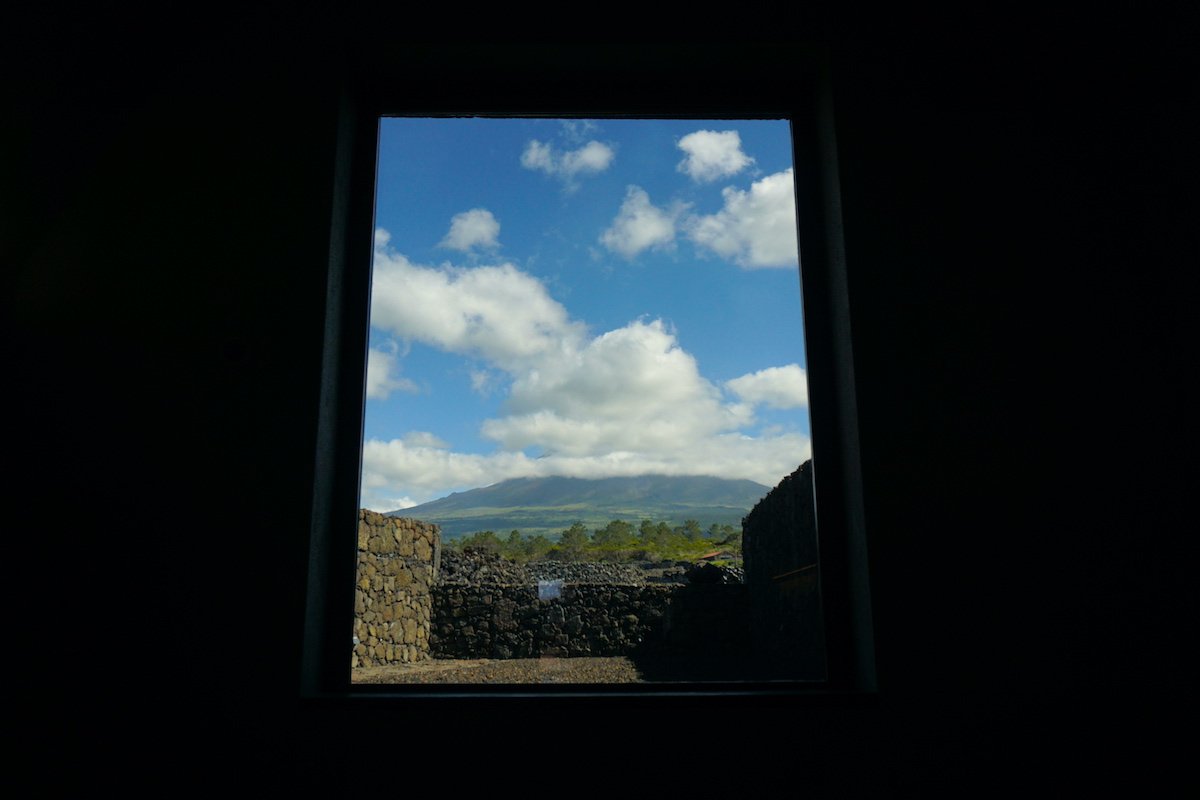
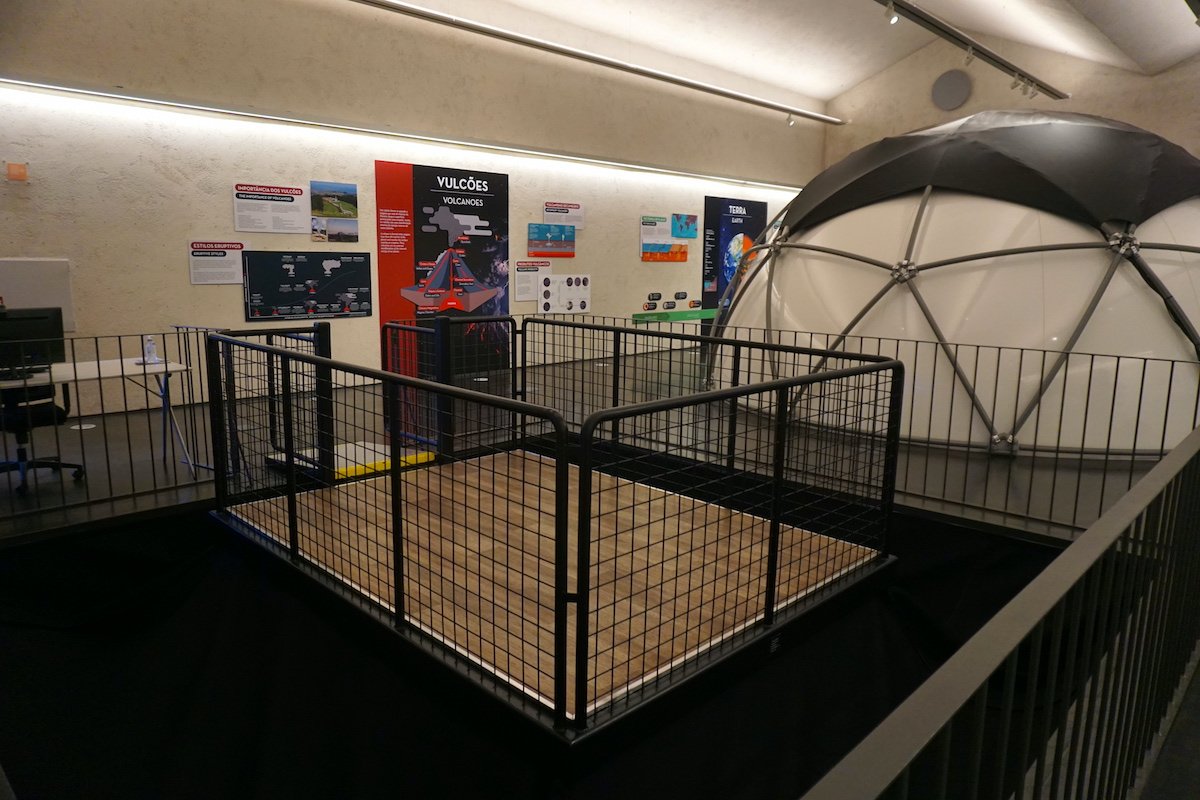
Centro de Interpretação da Paisagem da Cultura da Vinha da Ilha do Pico (Landscape Interpretation Center of the Vineyard Culture in Pico Island)
At the Centro de Interpretação da Paisagem da Cultura da Vinha da Ilha do Pico it will take you almost longer to say the full name of the center than to visit it. It is a small room with information panels about the wine culture, the relheiras, the rola-pipas (both visible in Lajido), and even the island’s fauna and flora. The Museu do Vinho do Pico, which we consider an essential visit on the island, is much larger, more complete, and interesting to investigate the whole subject of the island’s wine culture.
Relheiras (or Rilheiros) are the tracks in the lava caused by the wheels of the carts that transported the wine barrels.
Rola-pipa is a ramp excavated in a rocky area by the sea to facilitate the loading of wine barrels to be transported on a ship.
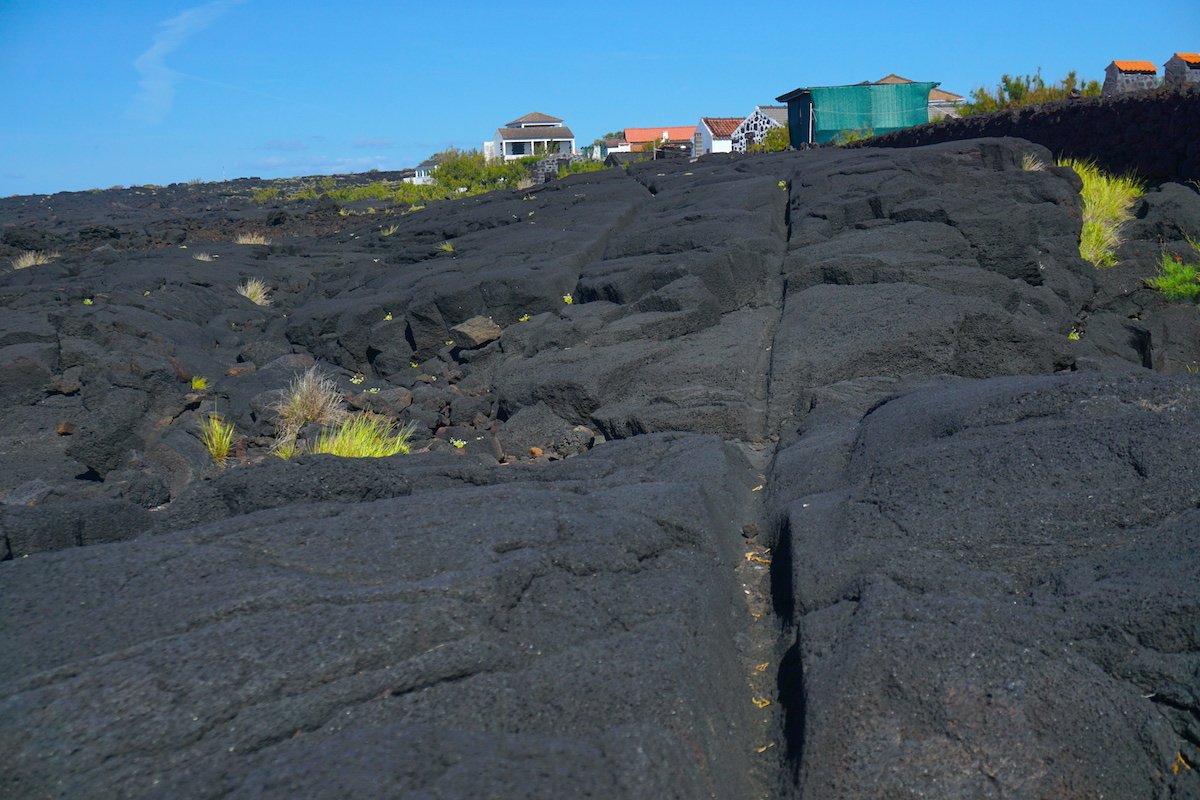
The duration of the visit is approximately 20 minutes and the price of the single ticket for both centers (single ticket Lajido) is 4 €. Free admission for residents of the Azores. Includes a white wine tasting (for non-residents).


Cachorro
At the site of Cachorro (or Puppy, in Portuguese) you can see a volcanic rock in the shape of a dog’s head looking out to sea (although the dog seems to have lost an ear). But it was not this volcanic shape that attracted us here.

Cachorro, very close to Lajido, is also part of the Protected Landscape of the Pico Vineyard Culture. In fact, it is connected to the other two coastal towns, Lajido and Cais do Mourato, through the so-called Caminho da Costa, which we recommend. Walking from Cachorro to Lajido is to walk on the history of the youngest island of the Azores with the sea as a companion.

Besides the famous volcanic dog face, you can walk among some beautiful houses surrounded by vineyards, a well next to the port that guaranteed the water supply, and even a rola-pipa (a ramp carved into the rock to facilitate the transport of wine pipes), which we learned about at the interpretation center. Today, there is a hermitage dedicated to Nossa Senhora dos Milagres and a bathing area where you can take a dip (although be careful as the sea can be quite rough around here).

Madalena, the capital of the island
Azorean cities are not usually the most interesting thing on each island and the truth is that in Madalena, except for the port from which we arrived and left the island and some restaurants that we tell you about in the section Where to eat on the island of Pico, it is not, in our opinion, a place to spend much time, especially if time is something that is in short supply. However, in the capital of the island (or very close) there are interesting places to go at least once. And we say at least once because we liked the one we are talking about so much that we went back three times!
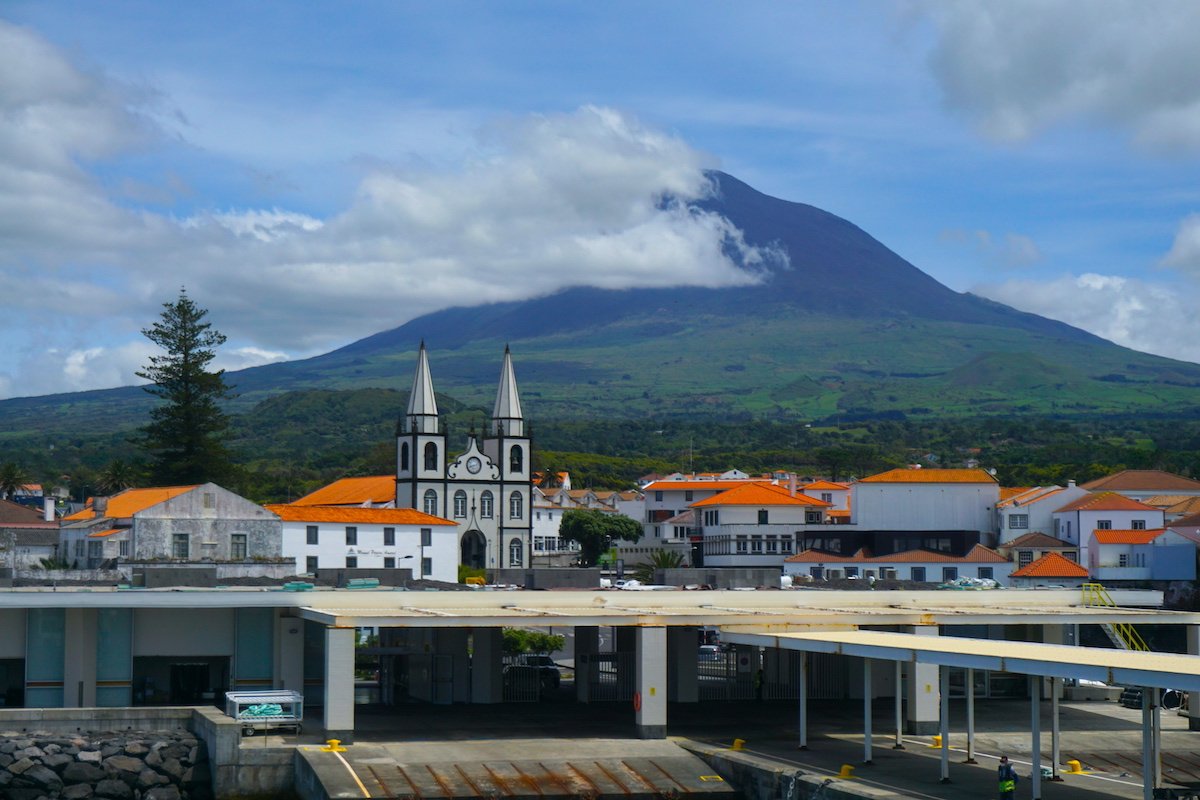
The Cella Bar is much more than a bar and a restaurant, it is a work of architecture and design by the sea where you can taste a good white wine of the island, a cheese board of the archipelago, or an exquisite dinner. Half stone house, half wood with an incredible terrace overlooking the Atlantic and right in front of the natural pool da Barca, the Cella Bar won several awards, including the most beautiful bar in the world by the prestigious online architecture platform ArchDaily, in 2016.



With the picaroto white wines “Terras de Lava” and “Frei Gigante” it is difficult to order only one glass of wine…
The Azores Wine Company winery is another architecturally interesting place to taste a good Pico white wine. Two thousand square meters of contemporary architecture in the largest winery of Pico (of all the islands of the Azores in fact). They recovered 125 hectares of vineyards, some of them centuries old, and right there you can taste the incredible whites produced there, in a beautiful tasting room.

We continue with the glass in hand, but you can’t talk about Pico without talking about wine. Now we recommend a sweet wine, the famous “Lajido Superior”, a liqueur but dry wine that you can taste at the Cooperativa Vitivinicola Da Ilha Do Pico (CVIP) or, as it is known, Picowines. One of our favorite Picowines, Frei Gigante, is also produced here.
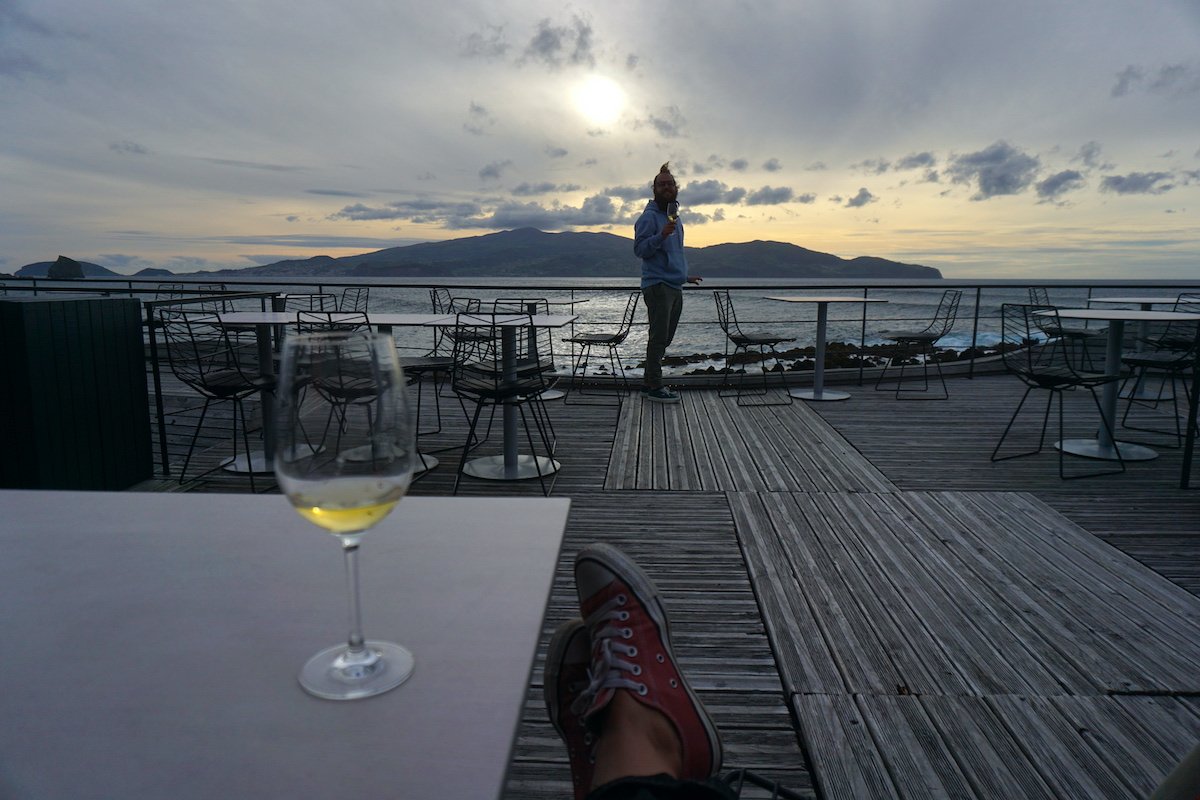
Museu do Vinho do Pico
Something very surprising is that from such an arid land such rich grapes are born and that one of the attractions of the island of Pico is its wine (especially white wine), but it is true! And the best place to learn about Pico’s wine culture is at the Museu do Vinho do Pico.

The photogenic orange museum, surrounded by dragon trees and, of course, the sea, is located in an old Carmelite convent. In fact, it is said that it was the priests who introduced the wine to the Azores because they needed it for the masses.
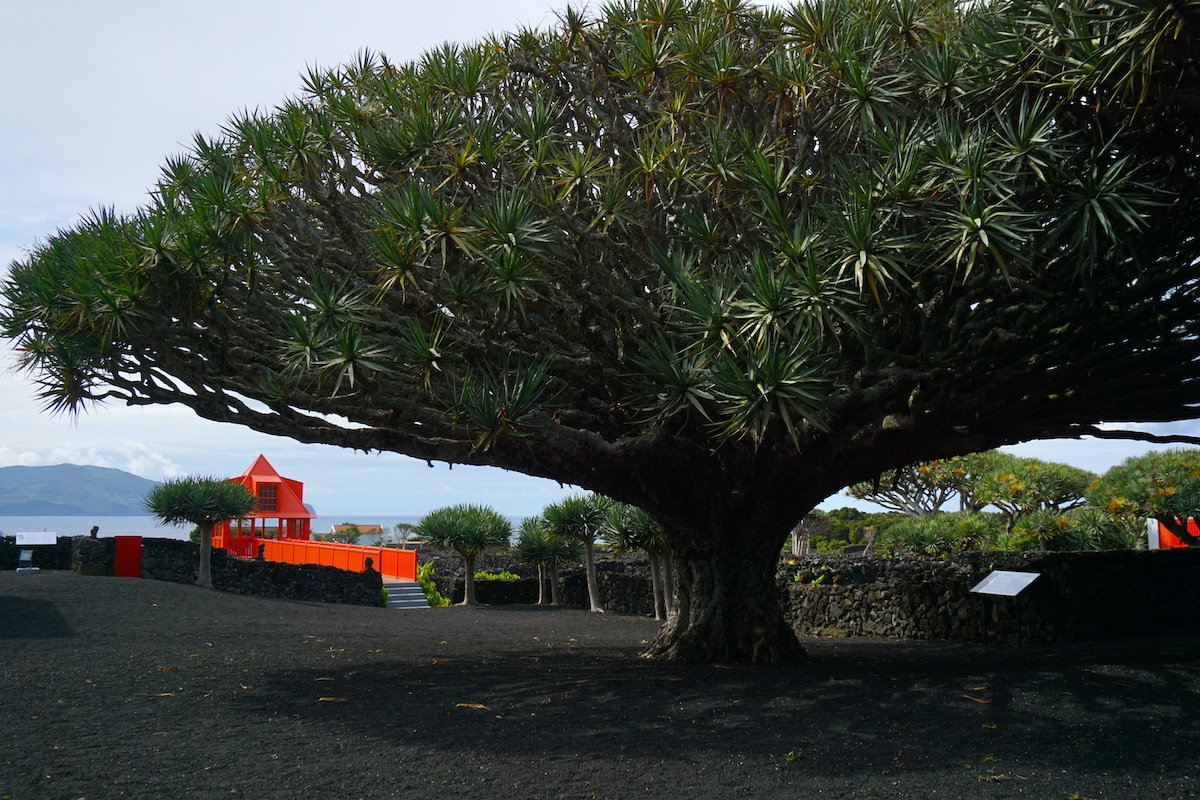
We learned at the museum that the first references to Pico wine date back to the 16th century and that when they settled on the island of Pico, known as the “broken island” (because the rainwater leaked and ended up in the sea), they encountered many difficulties as less than 5% of the island was arable (something like 3.4%). Much of the island was covered with lava so soil had to be brought in from neighboring Faial by boat. After arranging much of the scattered volcanic stones, the“picaroto miracle” was created: the famous“currais“.
The currais are the black stone walls that protect the vineyards (and other plants) from the wind and sea water.
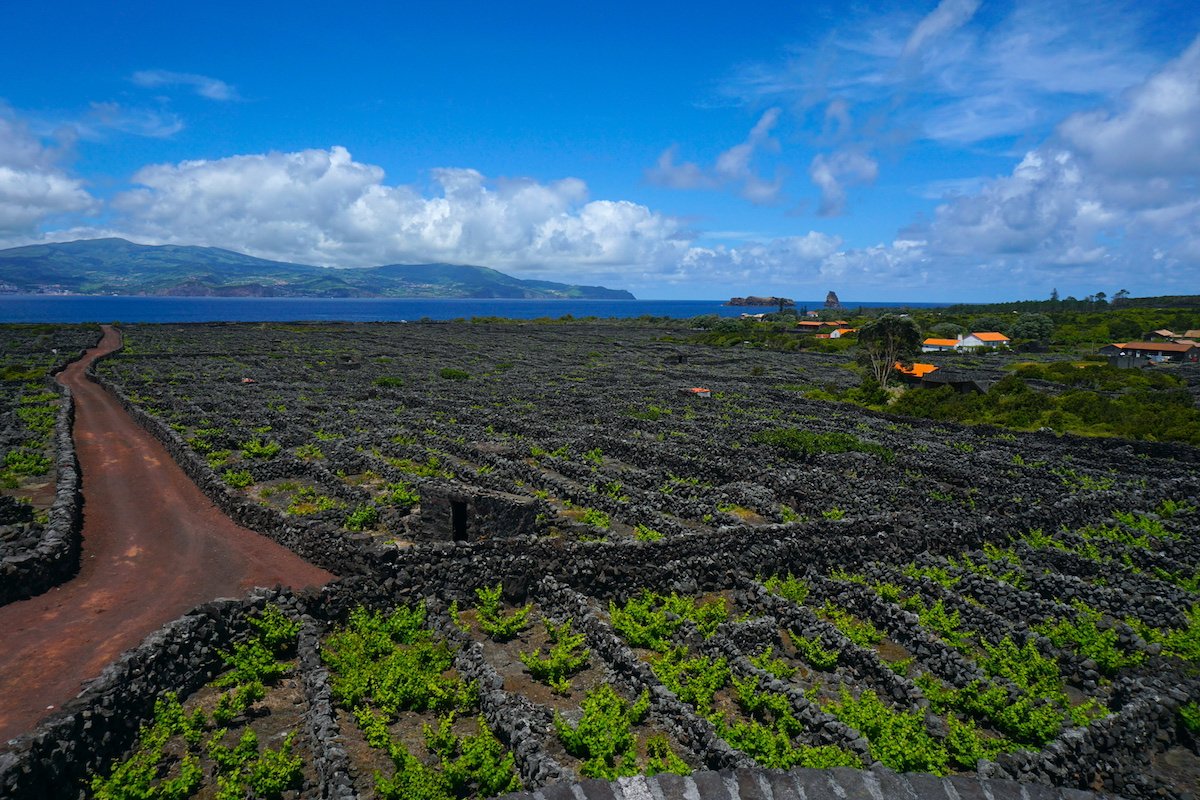
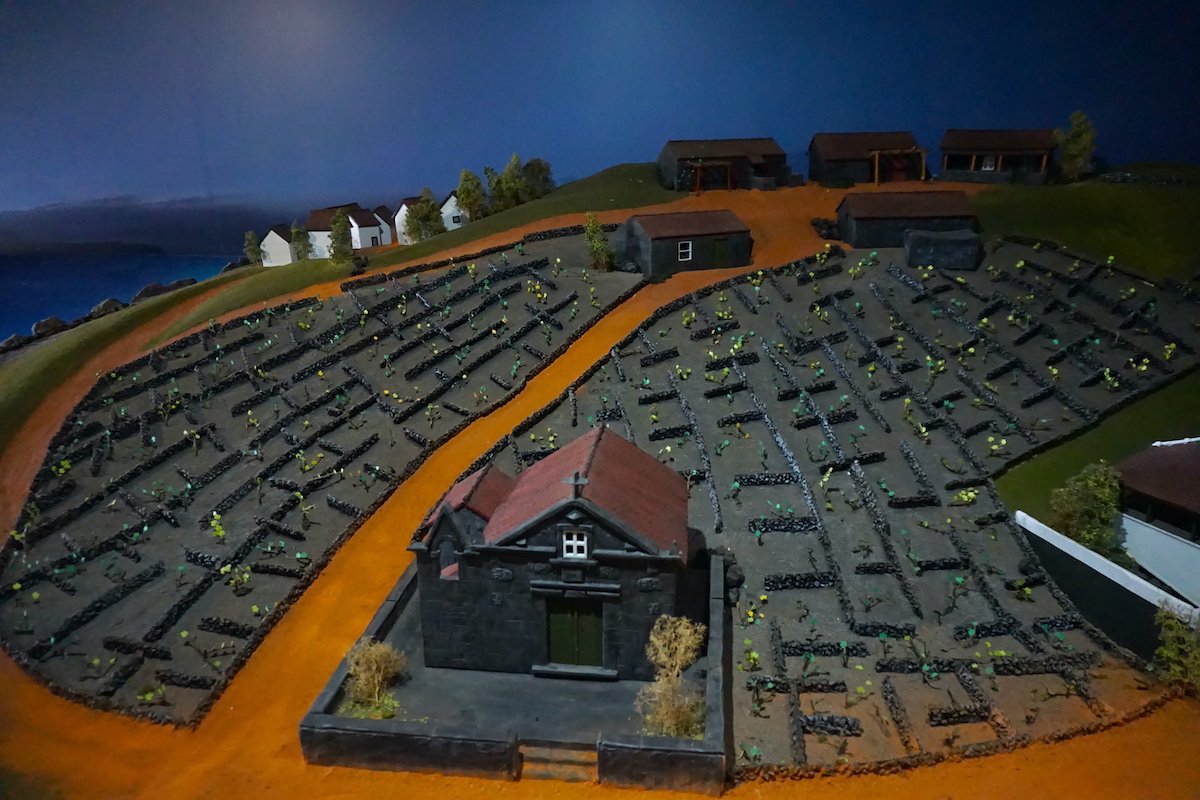
When they created the currais (corrals) they realized that something was very good there, wine. Today, the landscape of the vineyards is a Unesco World Heritage Site and its grapes are the most expensive in the country. These grapes create a unique wine that is born from the effort of these vineyards to survive (breaking rock to take root), the greenhouse effect of the currais in volcanic stone, and the salinity of the sea.

But it has not been an easy road. In the museum, you learn about the difficulties of the Picaroto people in what came to be considered an infertile island, even cursed, with no land and an excess of volcanic rocks, and all the obstacles they managed to overcome, especially in the 19th century with the vineyard plagues that contributed to their abandonment and, subsequently, the emigration of a large part of the population. But if there is something that characterizes the Azorean people in the face of their Atlantic solitude, it is precisely resilience, and the Picaroto wine culture is also a reflection of this.

Apart from being beautiful, very complete and ideal to learn about the history of the island through the culture of its wine, the museum hides some other surprises and no, we are not only referring to the incredible views of the sea and the currais from its oriental-inspired viewpoint…

In the Museu do Vinho do Pico we can walk through a forest of dragon trees (apparently the largest in the world) where there is nothing more and nothing less, the second oldest dragon tree in the world (the oldest is in Tenerife) that has more than 800 years.


The Wine Museum is located here, on the outskirts of the island’s capital, and is open from 10:00h to 17:30h in summer and from 9:30h to 17:30h in winter, closed on Mondays. The entrance fee is 2€/person.

Madalena, the capital of the island, can be a good option to stay because of the number of options, especially if you don’t have a car. For example, the My Bed in Pico or the Casa do Pico. Check here for other accommodation options in Madalena.
Criação Velha: wine culture and Moinho do Frade
In Criação Velha, there are miles and miles of currais that make up one of the most beautiful trails of the island through the “Landscape of the Vineyard Culture” whose architecture has made it considered a Unesco heritage site since 2004.
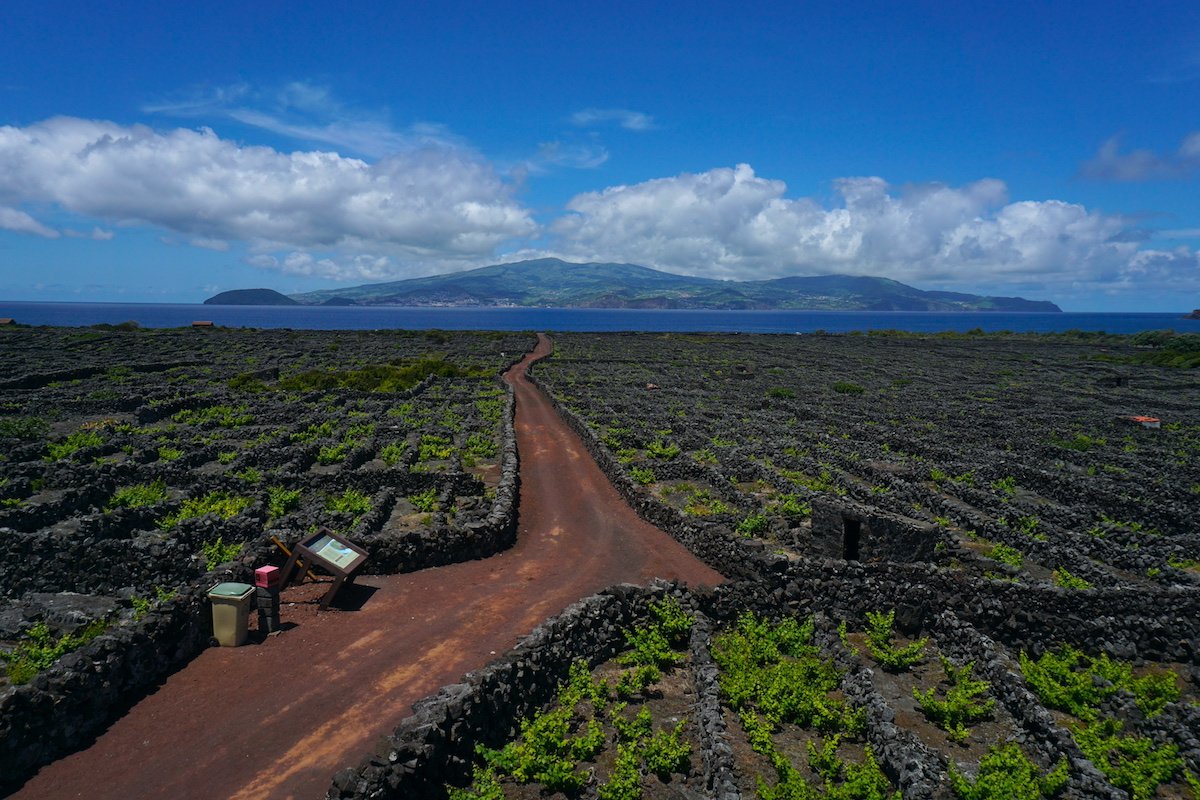
The photogenic red mill, Moinho do Frade (recovered in 2004), serves as a viewpoint to the mountain, the vineyards between currais and the sea, being one of the most famous postcards of the island.


It is a great plan to walk among volcanic vineyards along 7km and, since it is a flat and easy trail, it is ideal to recover after coming down from Piquinho. That’s what we did, since our guide Nuno recommended we move a bit the day we came down from the mountain and thus avoid that the recovery was more painful in the legs. Said, done and confirmed.

Randomtrip scale of Difficulty: Easy. It is a 7 km linear trail, flat, which will take you about two and a half hours approximately. If it is hot, it is essential to put a swimsuit in your backpack to take a dip in the natural pool through which you will pass.
We did the trail with our friends from Faial, Tiago and Diana, and since the trail is linear, we left the car parked near the restaurant Ancoradouro (the end of the trail) and asked for a cab to the beginning of the trail, near the Vinhas do Calhau accommodation. We recommend the cab driver we met on the island and with whom we booked this route, his name is António Silva and you can call him at +351 917 537 913, he also does tours around the island for one or several days.
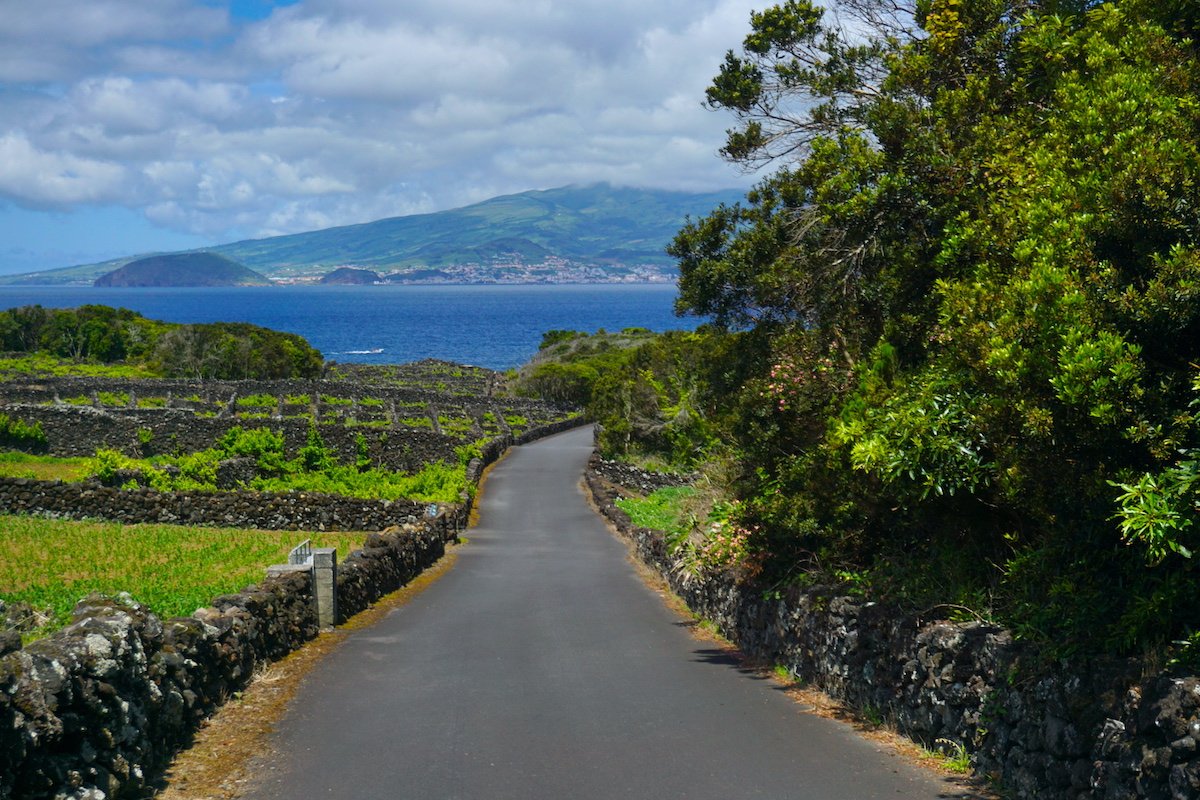
Apart from the challenge of farming on a lava-covered island and appreciating the beautiful picaroto miracle of the currais, the time spent on the trail is worth extending if the program includes a stop at the Lajidos (solidified lava fields by the sea) and a dip in the natural pool of Lajã das Rosas, also known as the Criação Velha pool.

If you want to stay overnight near one of the most beautiful landscapes of the island, as we did for a few nights, we recommend staying at the Vinhas do Calhau (from 80€/night) where we celebrated my birthday or the next door, the luxurious Pocinho Bay (from 195€/night).

Given the importance of the wine culture on the island of Pico, if you do not have much time, you can concentrate most of what we propose in a day tour that includes a visit to the landscape of the vineyard and its currais, Unesco heritage, of Criação Velha with the photogenic Moinho do Frade; visit to the PicoWines Cooperative (and taste a wonderful Frei Gigante, one of our favorites); lunch at a Picaroto restaurant with typical gastronomy; visit to the complete Museu do Vinho and, finally, tasting at the architecturally beautiful Azores Wine Company. Sounds good? Book here.
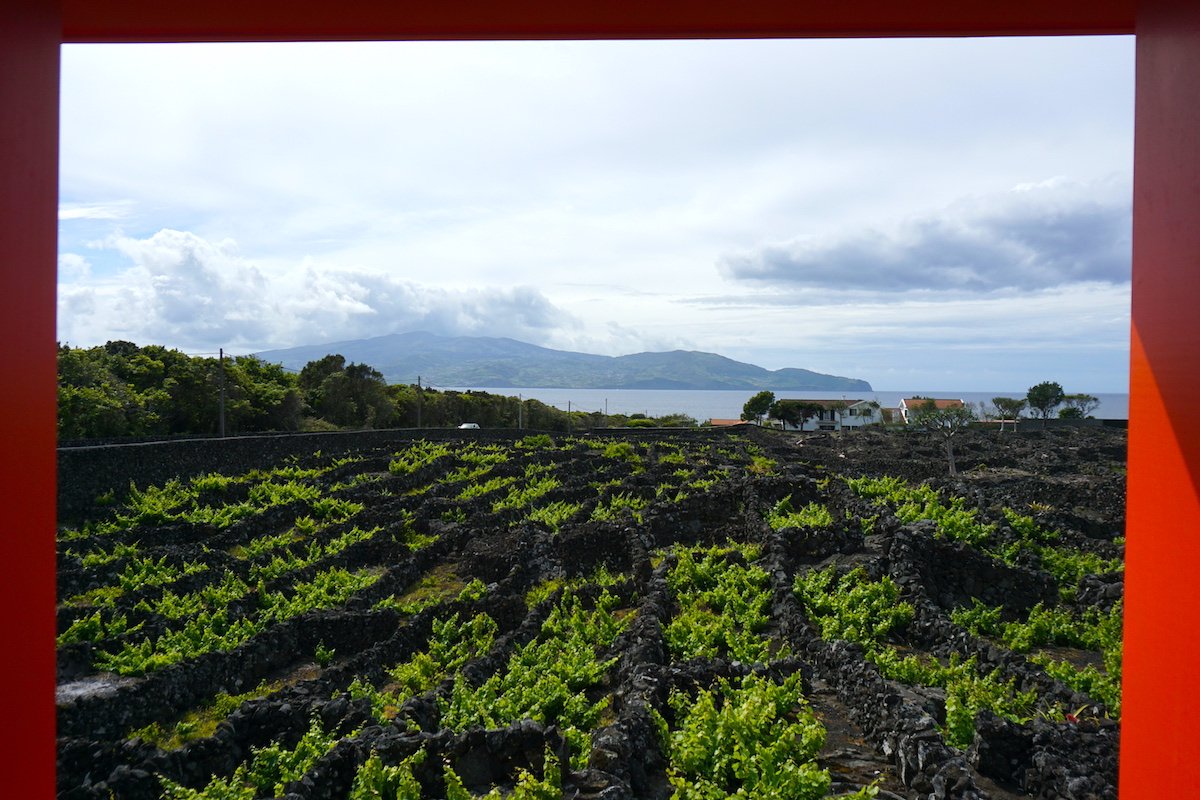
Gruta das Torres
The Gruta das Torres Interpretation Center, where the largest lava tube in Portugal is located, is an essential visit to understand the origin of the Azores islands in general and the island of Pico in particular, since everything you will learn below, in the cave, will help you understand what you are seeing above, on the island of Pico and the other Azorean islands. Basically, the visit to Gruta das Torres prepares you for what you will see on the surface on your trip to the island of Pico. For this reason, we recommend you make this visit as one of the first plans on the island.
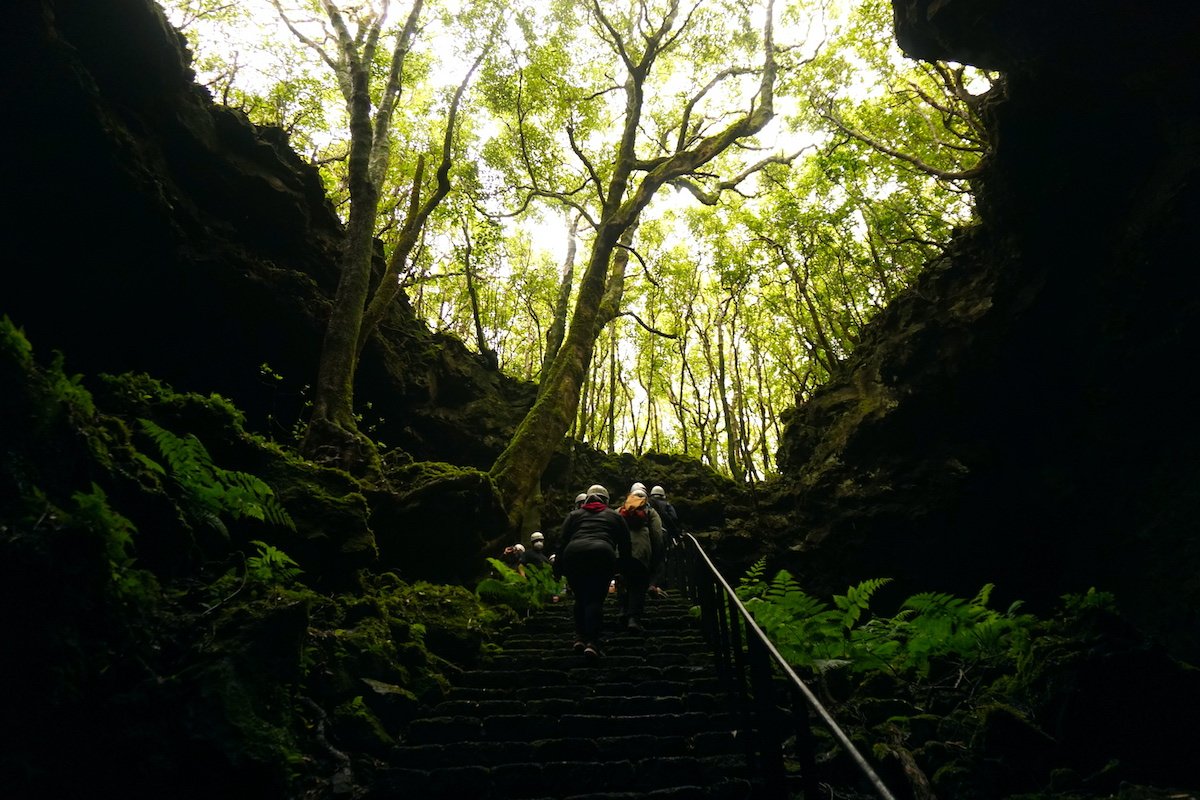
There are more than 100 caves on the island of Pico (almost as many as on all the other islands combined) and the Gruta das Torres, with an extension of 5150 meters, is the one that is enabled to be visited on the island (also in a very respectful way of its environment) and see the footprint left by the lava when it was created.
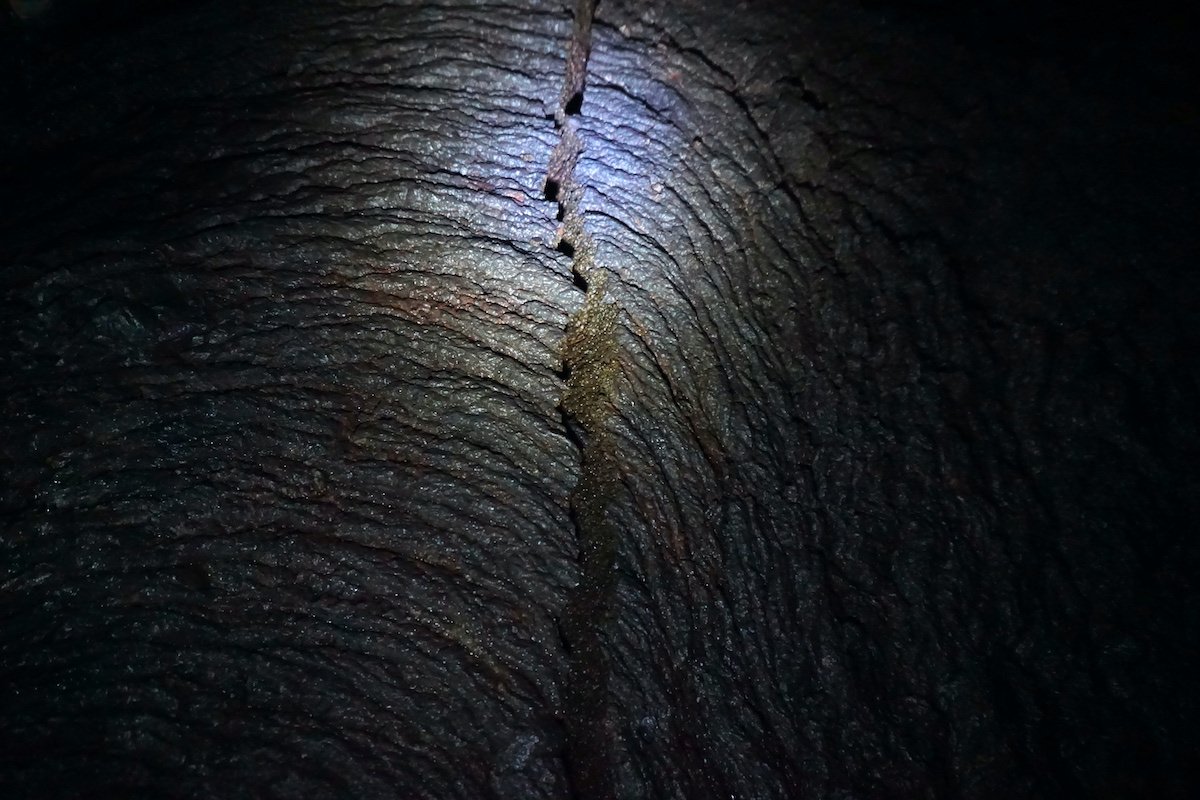
When you arrive at the center, there is a very interesting presentation about the origin of the Azores in general and the island of Pico in particular, about how these caves are formed and all that you are about to know below in first person.

After the guide’s presentation and explanation, you will put the helmet on your head and the flashlight in your hand and descend to the maximum depth of 22 meters of this natural monument, excavated by a volcanic eruption and preserved as a farmer found it in the nineteenth century, and you will enter the 500 meters of the visitable section.
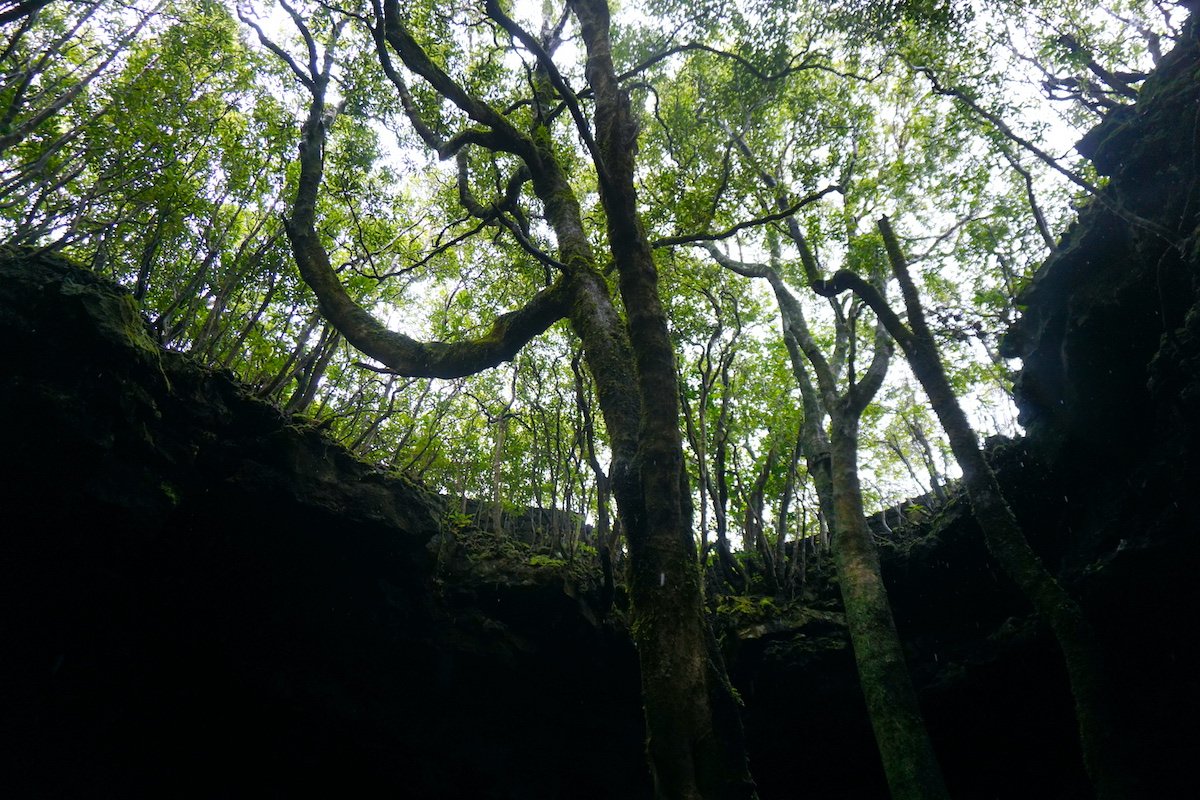
Once inside, you will observe stalagmites and lava stalactites (known as shark’s teeth for their triangular shape) and learn about the island’s geology and volcanic activity with the 4 recent eruptions baptized as mysteries (the Mistério de Santa Luzia, Mistério de São João, Mistério da Silveira, Mistério da Prainha).
You will also see that there is a unique ecosystem down there, with fungi and bacteria that look like gold lining the walls of the cave and you will even find a bottle of wine! Unfortunately, you won’t be able to taste it, it’s Picowines‘ Gruta das Torres wine, aged there to take advantage of the unique conditions of the cave.
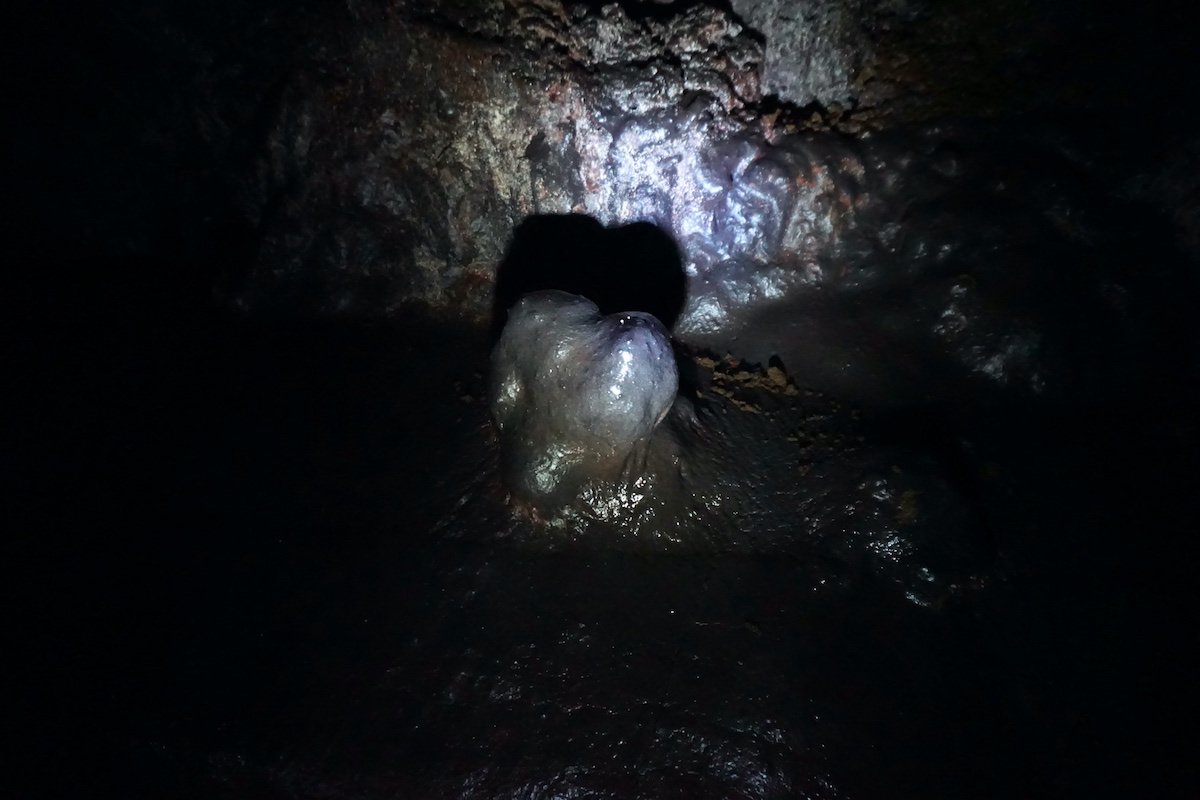
The visit to the interpretation center Gruta das Torres is guided, by reservation and in restricted groups. It is open from Tuesday to Friday from 10:00h to 17:00h and Saturdays and holidays from 14:00h to 17:30h. Closed on Sundays and Mondays. The visit lasts between 60 and 90 minutes, in limited groups of between 4 and 15 people maximum, and must be booked in advance by calling +351 924 403 921. The entrance fee is 8€. It’s better to bring something waterproof and good shoes that grip because except for the entrance, you walk through the cave as it is and the terrain is uneven and slippery in some areas.

Mirateca has an art surname: MiratecArts
Mirateca is the name of a small town on the island that has, for some years now, had the surname of Art. When Terry Costa (a Canadian-born artist, producer, and acclaimed artist of Portuguese descent) decided to move to Pico in 2011, the island where he grew up for several years, Pico became known for its cultural agenda. MiratecArts is a cultural association that was born here, on the island of Pico but whose work extends to the 9 islands of the archipelago bringing exhibitions, concerts, workshops, and conferences from Flores to São Miguel. Terry Costa is also the founder of the famous Azores Fringe Festival, an art festival that takes place every year in June and that we were lucky enough to enjoy on its mother island, Pico.

The inauguration of the Azores Fringe Festival was here, at MiratecsArts where we attended an artistic and musical journey accompanied by 9 bonfires (representing the 9 islands and the 9 years of the Azores Fringe Festival) and ended with a Galician queimada with its incantation!
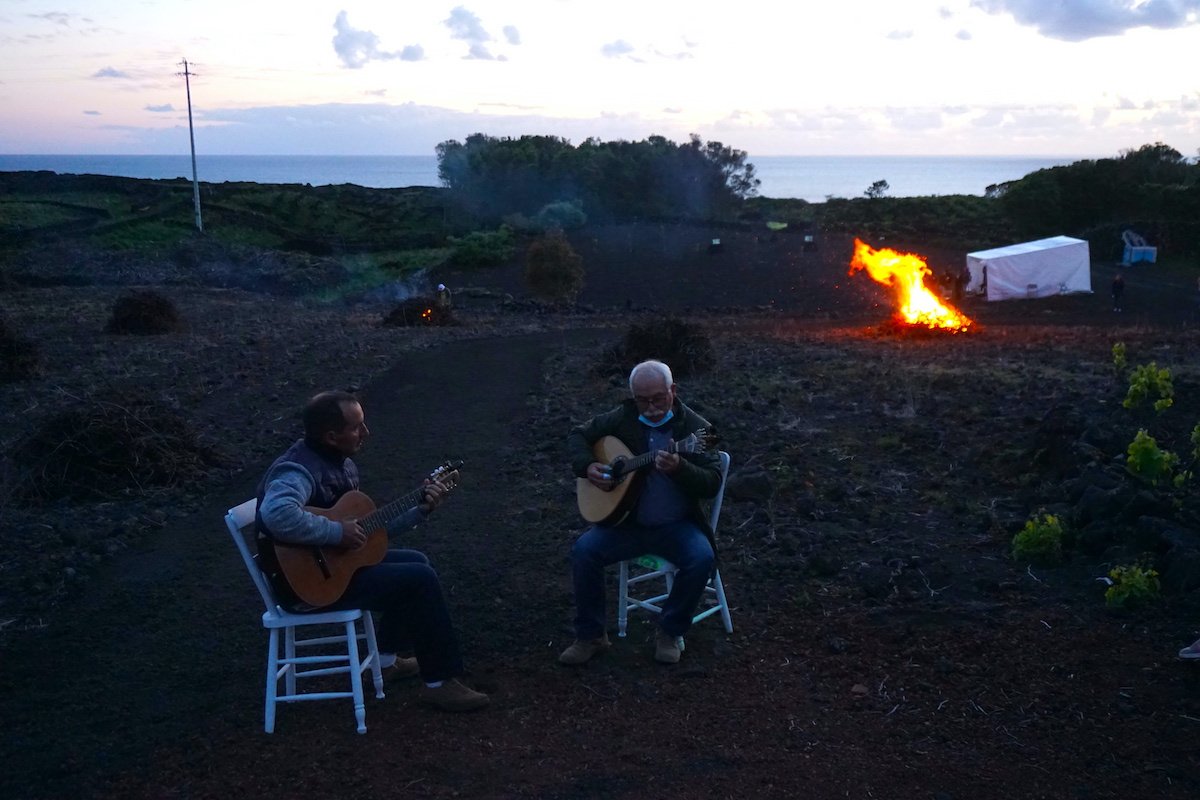
Even if your visit to the island does not coincide with the festival, you can still visit Mirateca, where you can tour several art installations on Terry’s property.

When you go, try to find as many “Sorrisos de Pedra” by local artist Helena Amaral as you can, who we had the pleasure to meet at the inauguration. In fact, these “stone smiles” are scattered all over the island of Pico (and other islands too!) so you can find as many as you want to brighten up your days.
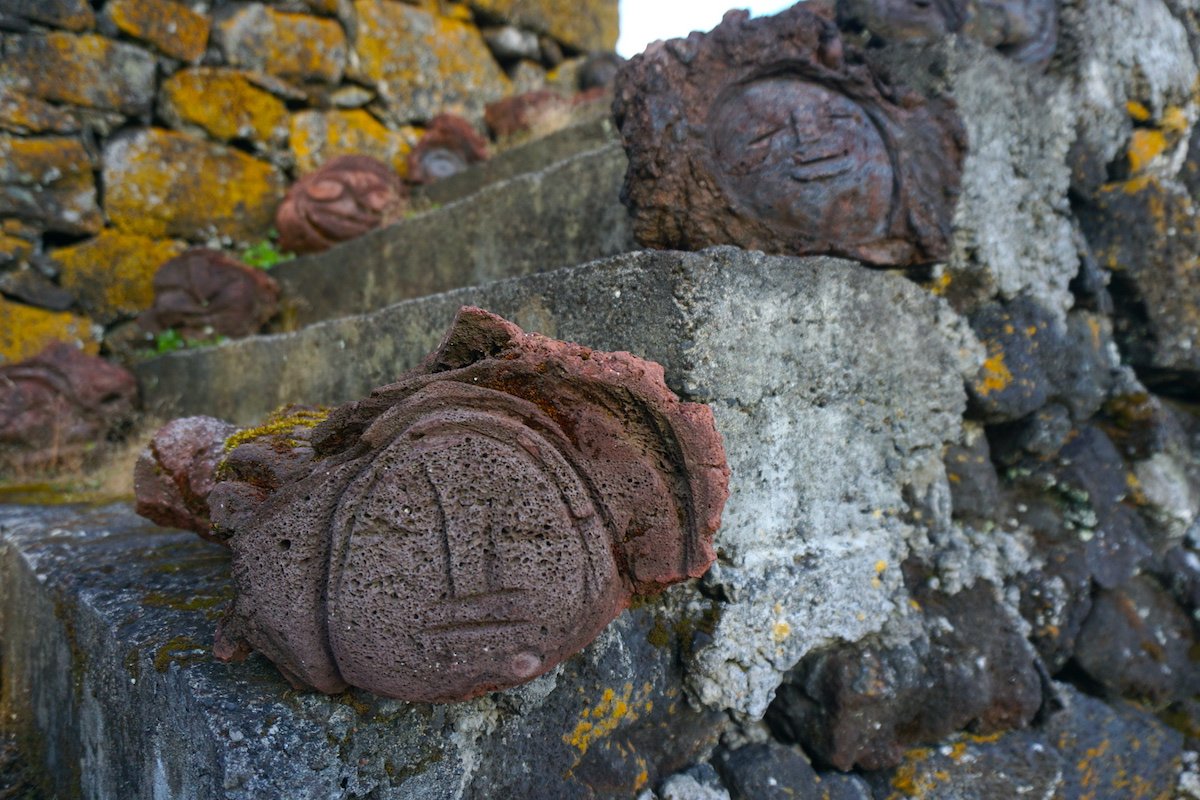
Sao Mateus
Sao Mateus is one of the oldest parishes on the island of Pico, being populated in 1482, where its parish church of 1838 stands out.
If you pass by here, besides visiting the church, you can take a dip in the natural swimming pool or buy local handicrafts in Picoartes.
Here in São Mateus there is a spectacular accommodation to stay, the Aldeia da Gingeira (from 52€/night) where you can relax in a jacuzzi overlooking the Atlantic! It was where our friends Márcia and Mário stayed on their visit to the island so we have very good first hand opinions. The other option in the area is to stay at Aldeia dos Caldeirões (from 64€/night), this one with jacuzzi and pool overlooking the Atlantic.

São Caetano
Next to São Mateus is São Caetano, a village with a fishing port and a beautiful bay both above and below the sea, as it is one of the dive sites of Pico Island. More info in the section Where to Dive in Pico. There is a restaurant with a terrace where you can eat good fresh fish: O Galeão.
Lajes do Pico: whale and dolphin watching
Different types of cetaceans live in the Azores – some residents, others on their migratory routes depending on the season – and observing them in their habitat is one of the island’s star activities and the best place to do it is in Lajes do Pico.
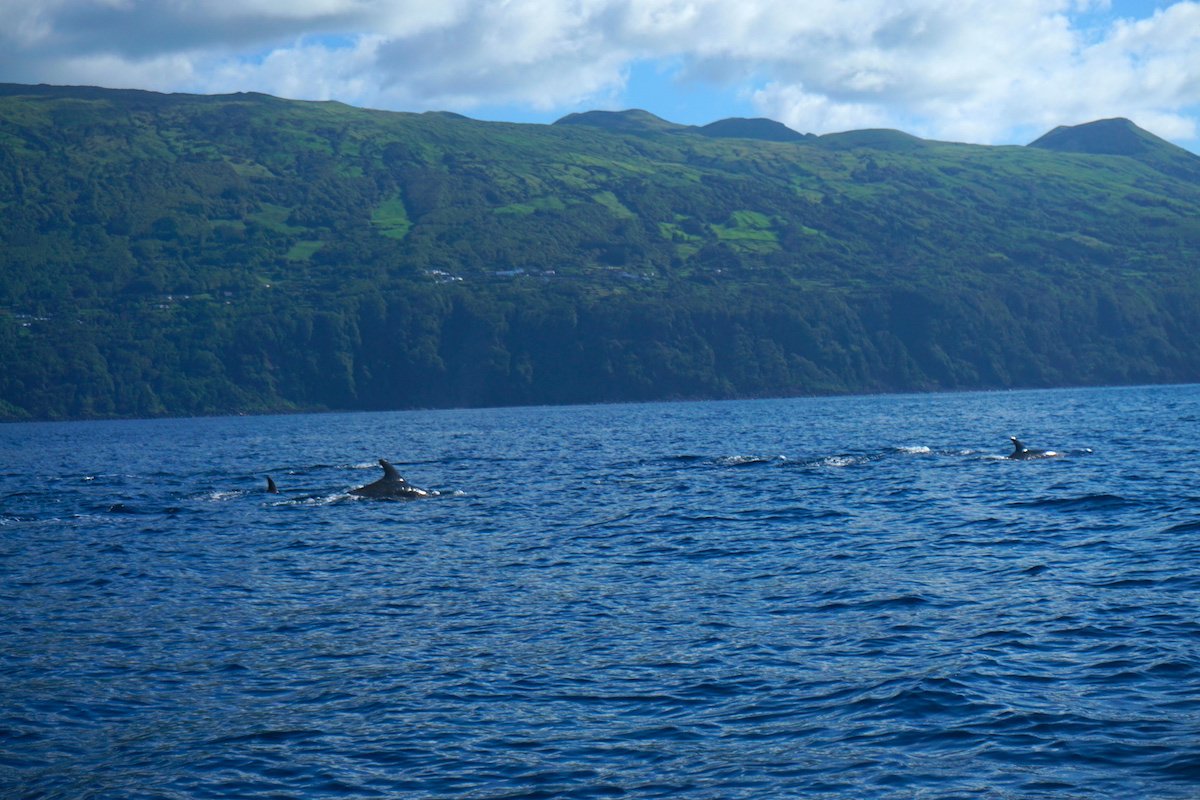
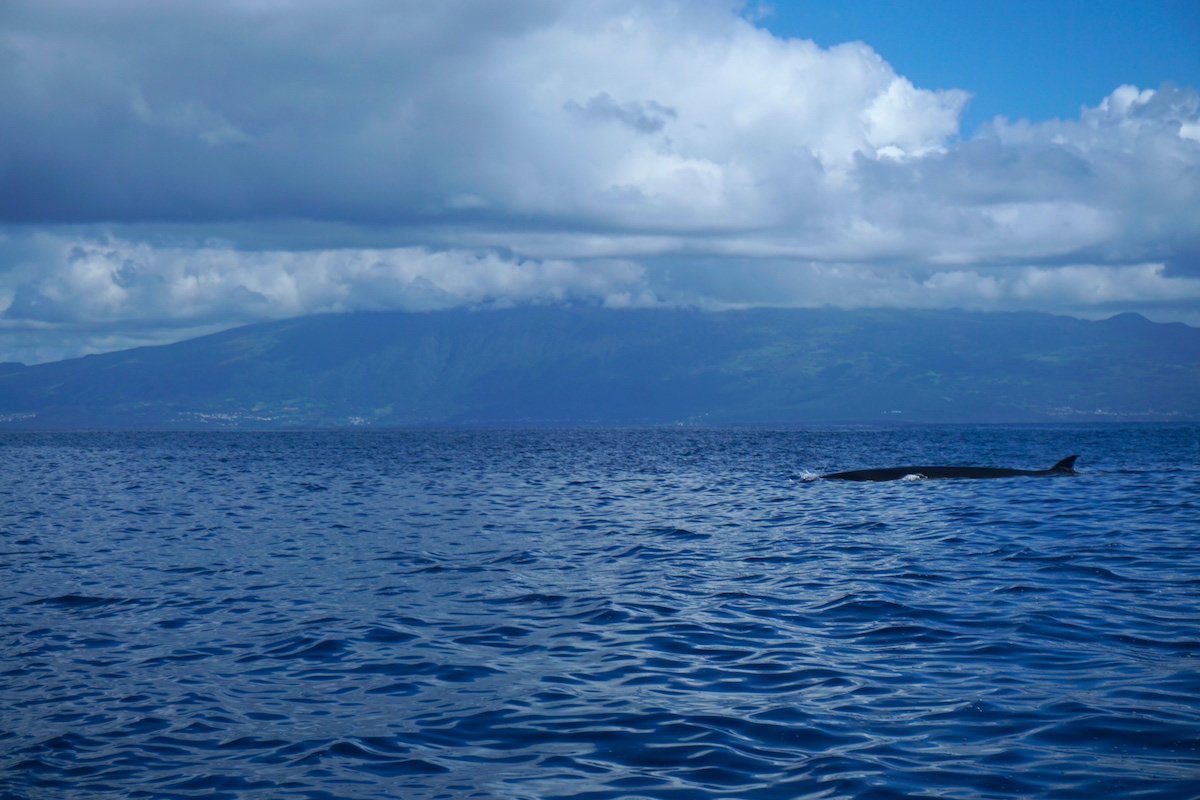
A whale watching done respectfully must include rules such as approaching the animals with reduced and constant speed, a maximum of 3 boats, never less than 50 meters, and never more than 15 minutes with the same animal. For this reason, we recommend Espaço Talassa for its ethical commitment to the animals and the environment. In addition, Espaço Talassa has a strict policy prohibiting the activity of swimming with dolphins, an unfortunate practice common in several centers of the archipelago that we ask you not to do because of its implications for the animals (you can read more about it here).

The whale-watching tour lasts about 3 hours during which the boat you are on is in communication with the different lookout points that are on land and communicate if they see anything “big”. Everyone hopes to see a sperm whale or a whale during the tour. You must adjust your expectations when you do this tour as you are doing something beautiful and responsible which is trying to observe an animal in its habitat but, for that reason, it is a lottery if the animal comes to greet you or not. Almost all operators advertise that they allow you to do the tour again for free if no cetaceans are sighted, but it is practically impossible not to see dolphins so in practice that clause is more marketing than anything else.

Book your whale watching tour here
The day we went to do the activity with Espaço Talassa we were very lucky! First, we were greeted by some“roazes” (bottlenose dolphins), then a large group of common dolphins wanted to accompany our boat for several minutes, very playful. Finally, our captain received a warning from a lookout, accelerated the boat a little and there they were: three whales! The ones we saw were“baleias sardinheiras” (sei whales), nothing more and nothing less than the third largest whale in the world. By the way, the Espaço Talassa also includes a restaurant and lodging, in case you get hungry or want to stay overnight in Lajes.
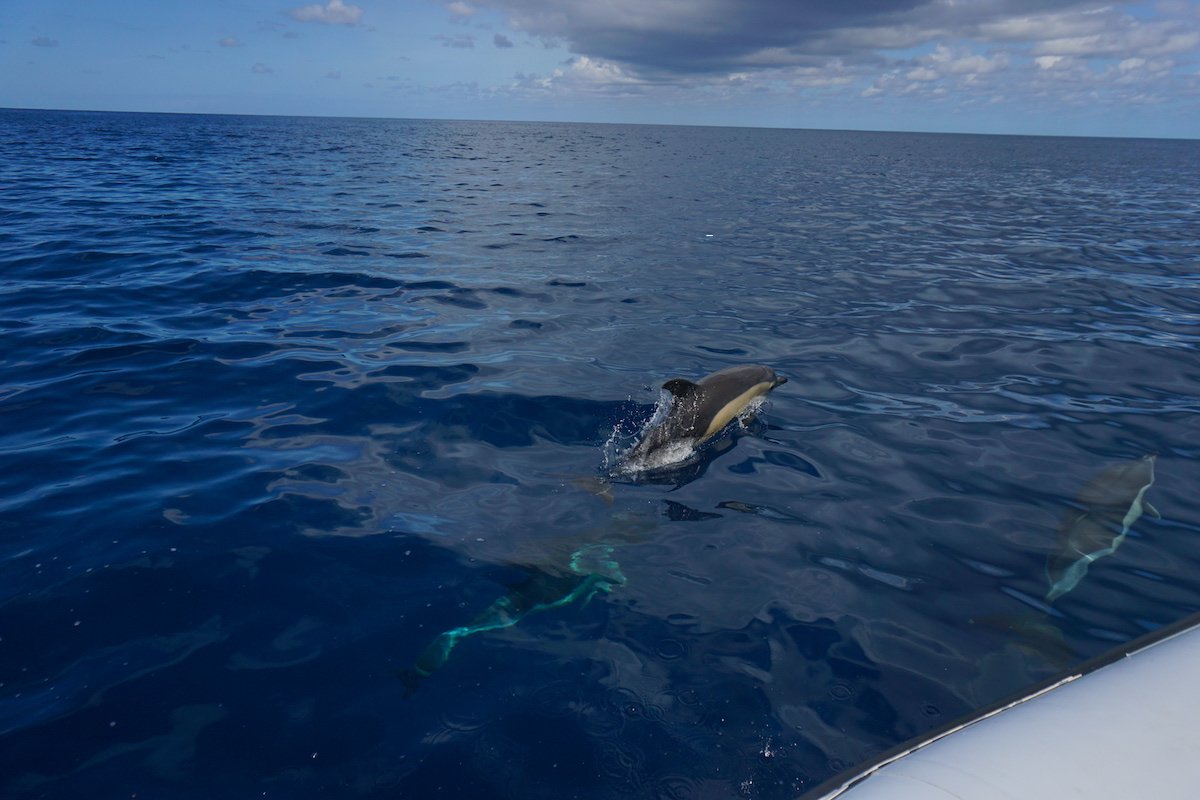

There are many options to stay in Lajes, from the Alojamento Bela Vista (45€/night) to more luxurious options such as a cottage in Aldeia da Fonte (75€/night) or a suite in Casa da Ribeira. More options in Where to stay in Lajes.
The Museo dos Baleeiros and the whaling industry
After the whale watching and included in the tour you book at Espaço Talassa, you can visit the Museu dos Baleeiros. If you don’t take the tour, you can still visit the museum on your own.

In the past, whale watching was for… hunting them. Whaling – the “baleação” – was a very important economic activity in the Azores, especially on the island of Pico, for about 50 years and the numbers are shocking: between 1896 and 1949 about 12 thousand whales were hunted. The activity was happily banned when Portugal joined the European Economic Community (EEC) in 1986 but it was not until 1987 that the last sperm whale was hunted on the island of Pico.
The museum portrays the hard life of the baleeiros (mostly men), explaining their daily life, hunting in small and fragile boats, the baleeiros boats and, if you are interested, you can watch a short documentary recorded in the 70’s about whaling on the island of Pico. A very hard activity where the animals and some of the humans who dedicated themselves to it lost their lives. The target: products derived from sperm whales and other whales: oils for lighting and lubricants (mainly for export) and various types of flour (made from whale bones). It is a visit where you will swallow dry many times, especially after having greeted the beautiful and majestic cetaceans in their Atlantic home.

In the Núcleo do Bote Baleeiro, one of the sections of this museum, you can see the “Santa Teresinha”, one of the most emblematic baleeiro boats as it is probably the oldest with the original hull of the entire archipelago.
The Centro de Artes e Ciências do Mar, also in Lajes do Pico, has a permanent multimedia exhibition on the biology of these cetaceans and a museological area dedicated to the whaling industry. Also at the Casa de Exposições Capitão Alves where you can see miniatures of baleeiro boats, caravels, and various types of cetaceans as well as handicrafts.

If you feel like a dip, there is an amazing natural pool in Lajes, more open and bigger than most you will find on the island, and with luck, you might even be able to spot a dolphin in the distance!
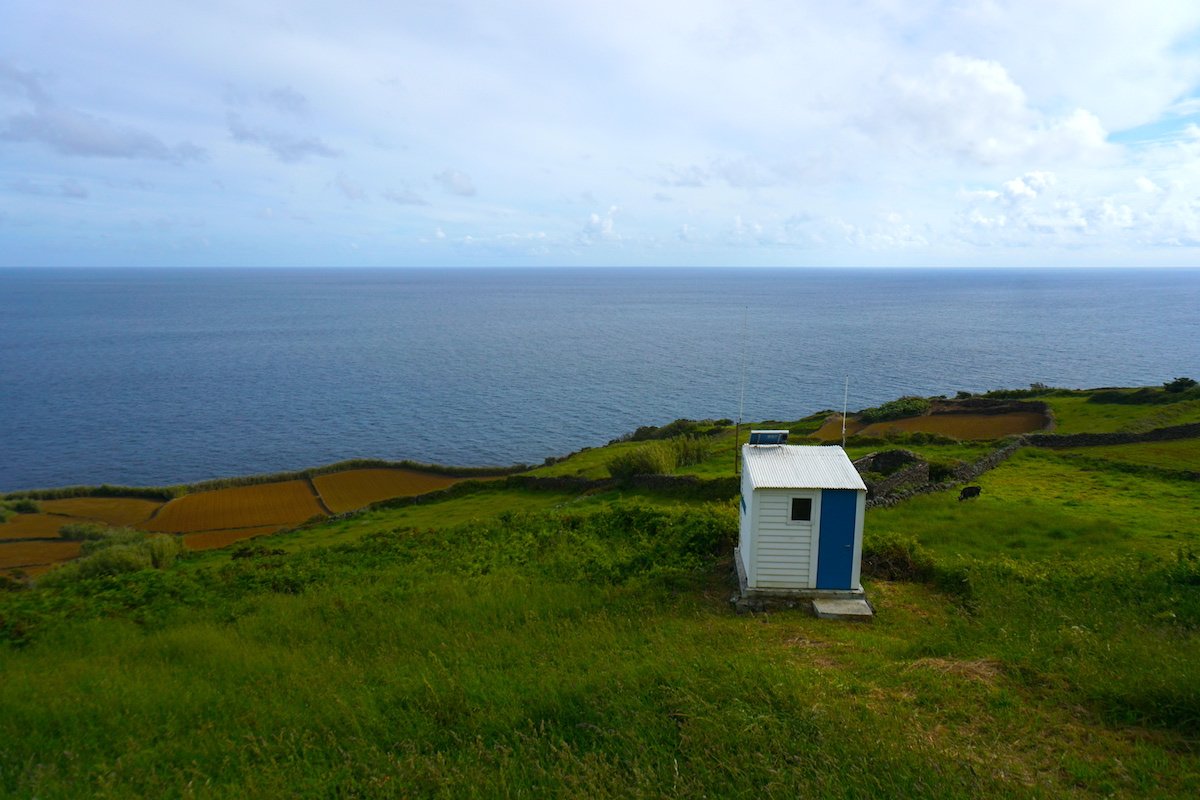
For the best views, go to the Vigia da Queimada, a whale-watching post of the Espaço Talassa where you can go to catch a glimpse of whales or simply enjoy the magnificent views.
Near Lajes is the fabulous Aldeia da Fonte Nature Hotel (from 75€/night) where you can stay in one of the 6 volcanic stone cottages and dine in the delicious Fonte Cuisine restaurant. Book here.
Calheta de Nesquim
It is in Calheta de Nesquim that the whaling activity is said to have started and the old photographs in the Casa dos Botes (the house where the boats sleep, the baleeiros boats) keep the witness of those years. Nowadays (and happily) the boats are used for regattas and it is very likely that, when visiting Calheta de Nesquim, you will see some young people training in the late afternoon. The islands of Pico and Faial often dominate the regional regatta championships.

Another peculiarity of Calheta de Nesquim is its church, or rather, the doors of its church. If you look at the latches of the church doors you will see that they are made of whale bones. It is said that they used it because it lasted longer than wood and that they even used it in the construction of some parts of the baleeiro boats.
If you feel like cooling off, Poça Branca and Poça das Mujas are ideal natural pools in Calheta de Nesquim. And if what you want is a walk, there is a highly recommended circular hiking trail in Calheta de Nesquim. We didn’t have time to do it but we are looking forward to it because it was recommended to us by 2 couples of friends, Joana and Zé and Diana and Tiago. It is the PRC11PIC (official info)
As you can see, the small town of Calheta de Nesquim has much more to offer than it seems at first glance, when you park the car and feel its tranquility.
Along the southern road of the island that connects Lajes do Pico with Calheta de Nesquim, you can see several lookout posts that warn boats if they see any large cetaceans. In addition to the lookout posts, the signs that warn that there is one nearby are very cute.

Ponta da Ilha
If you want to reach the easternmost tip of Pico island, head towards Ponta da Ilha and its lighthouse. When we went there it was closed but it promises beautiful views of the Atlantic.
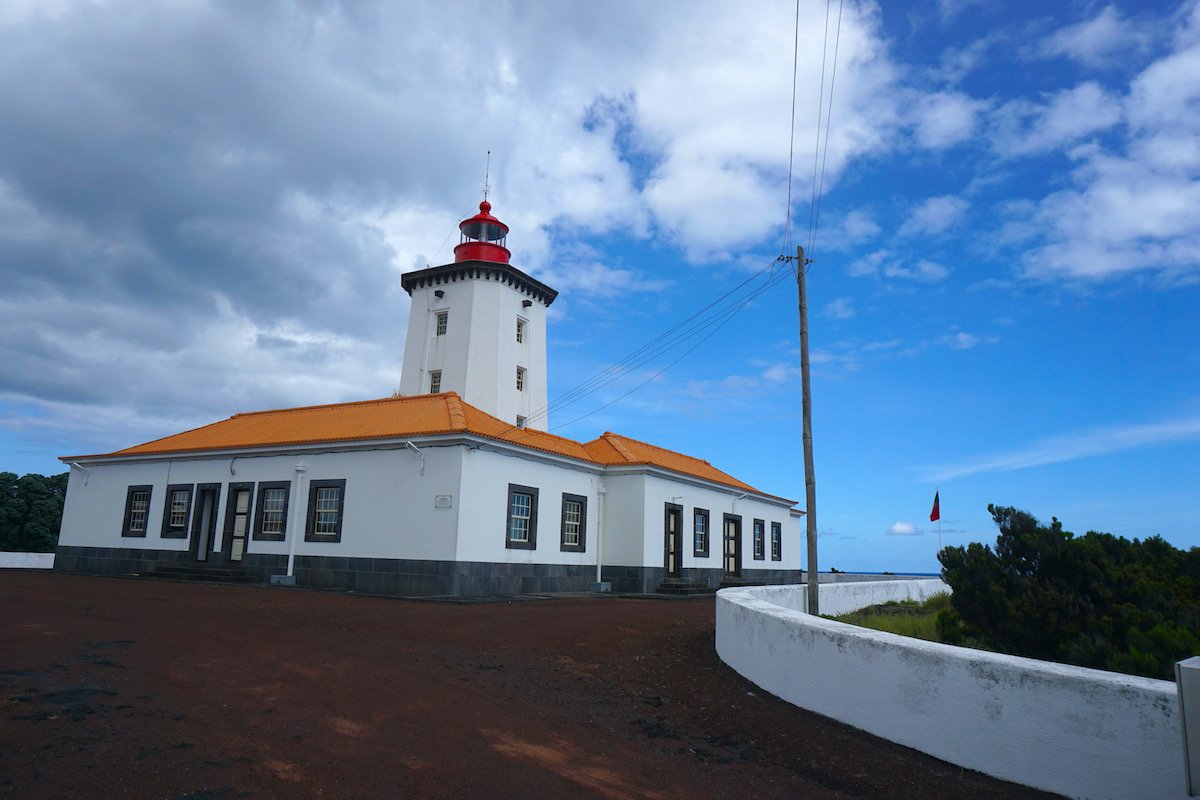

If you want to take a souvenir of the island, don’t miss the pottery store “O Oleiro” of a charming Belgian couple who settled here more than 20 years ago. A whale of theirs already inhabits our house.


Terra Alta
We include Terra Alta here because of a viewpoint, the Miradouro da Terr’Alta.
It is a lookout that is suspended on a cliff at 415 meters, offering a spectacular view over the Atlantic Ocean and the neighboring island of São Jorge.
Santo Amaro
In Santo Amaro, you will find one of the most famous lodgings and restaurants on the island. The accommodation is the Lava Homes (14 cottages of 1, 2, or 3 bedrooms) with a swimming pool and the restaurant is Magma. We approached the restaurant and we advise you to do so because it is worth it not only for the views of São Jorge and the Atlantic Ocean but also for the dishes made with local products and excellent service.

Also in Santo Amaro is the Escola de Artesanato de Santo Amaro, a handicraft school where the meticulous and delicate art of working with the inside of the fig tree trunk and even hydrangeas are taught and, of course, the ideal place to take home a souvenir of the island. Here you will find accessories (necklaces, earrings), embroidery, patchwork, and hats made of straw and even dried dragon tree leaves!



Between Santo Amaro and Piedade, on the ER1 road (West-East direction), if you stop in Ribeirinha you will find a beautiful beach, Praia da Baixa da Ribeirinha, so if you feel like a dip, head for the sea.
Prainha
One of the four mysteries of the island is that of Prainha, resulting from the eruption that occurred between 1562 and 1564, the longest eruption since the Azores have been populated. Here you can hike a trail of approximately 9 kilometers and cross the island from south to north. Along the trail you will see several sites linked to the geological history of the island such as the site where this eruption started, the site known as Cabeços do Mistério. It is the PR02 PIC (official trail info).


You can follow the trail to São Miguel de Arcanjo or to Baía das Canas beach, a beautiful pebble beach with beachfront cottages (public showers and toilets are available but camping is prohibited).
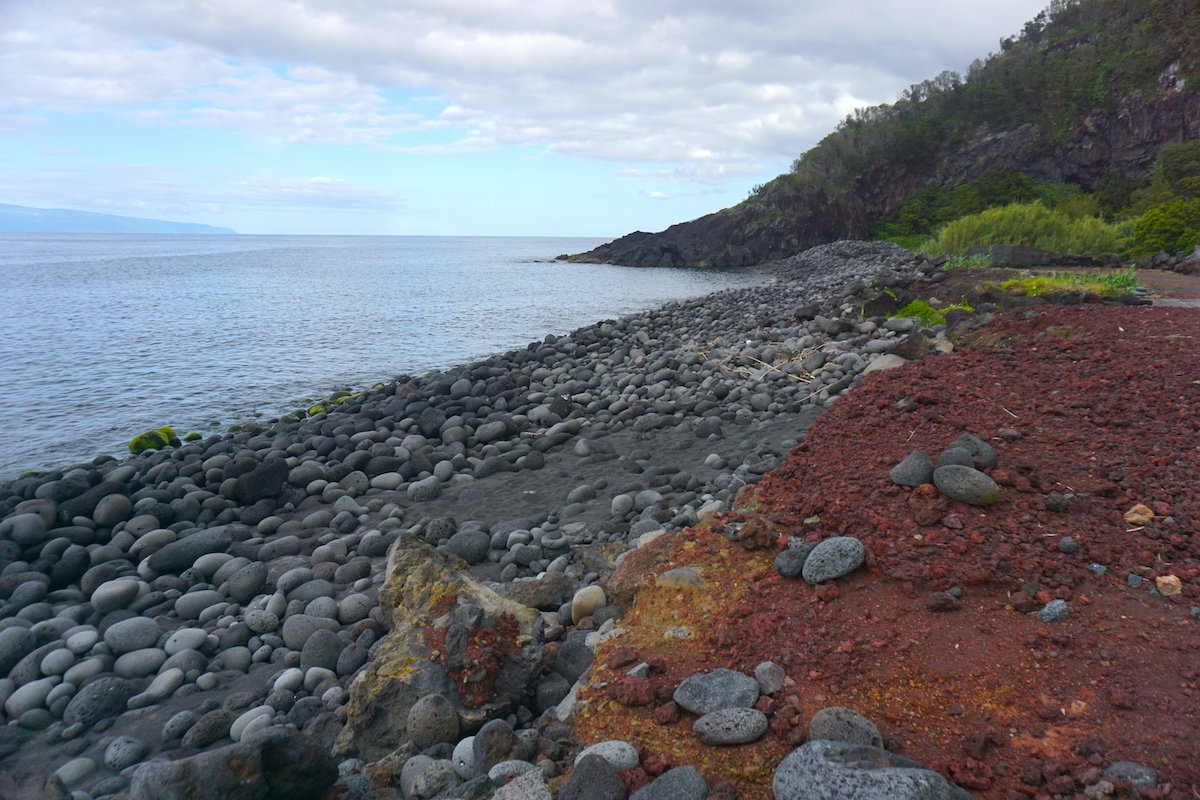
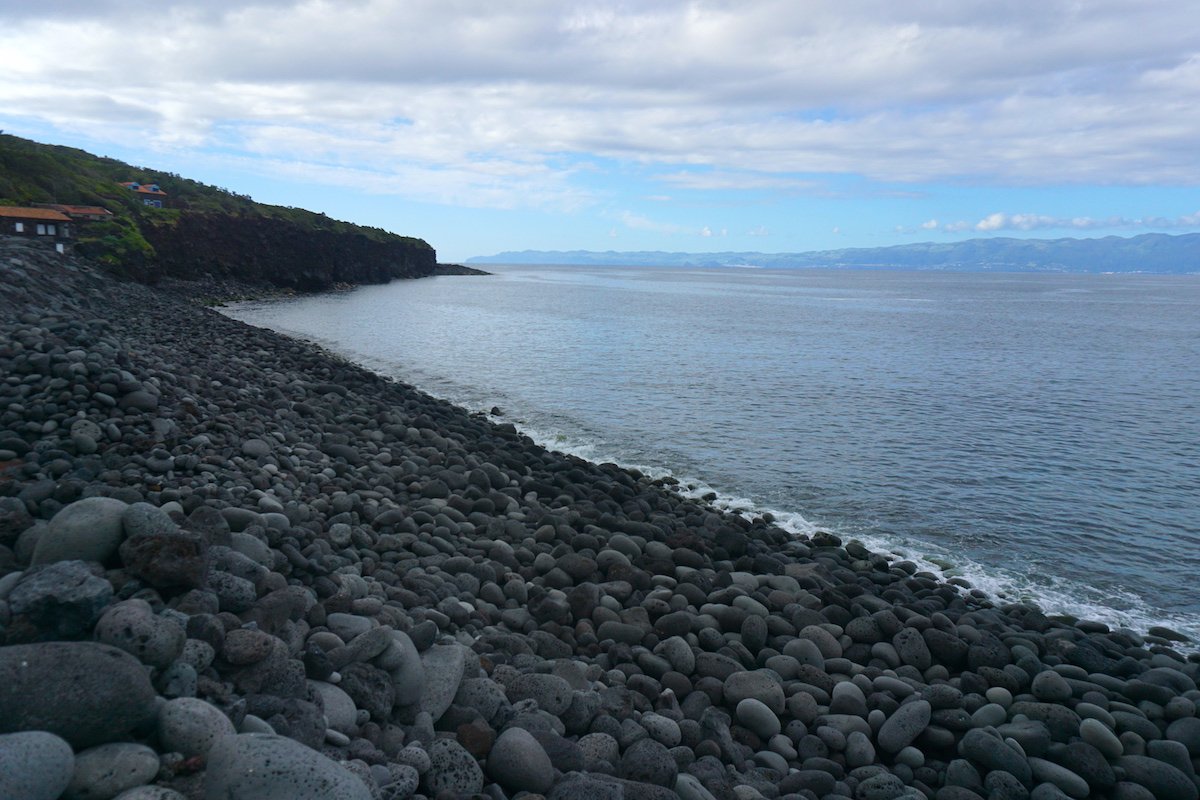
This area is also linked to the wine culture of Pico, next to the Parque Florestal da Prainha, where there are still several wineries such as Adega Açoriana.
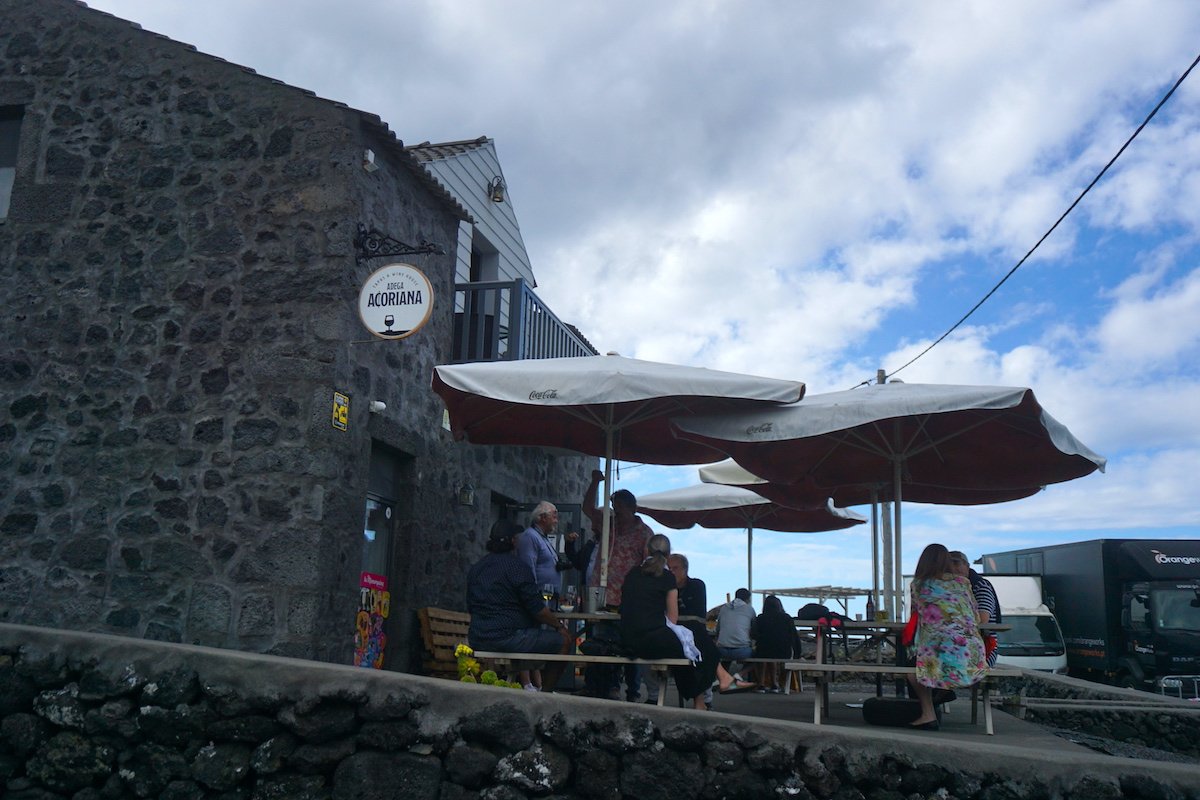
If you feel like a dip, the ideal is to go to Poça da Branca, a natural pool with calm waters and, with luck, a view of the neighboring São Jorge.
Finally, go to Ponta do Misterio, a viewpoint where you can enjoy incredible views of the Atlantic Ocean.
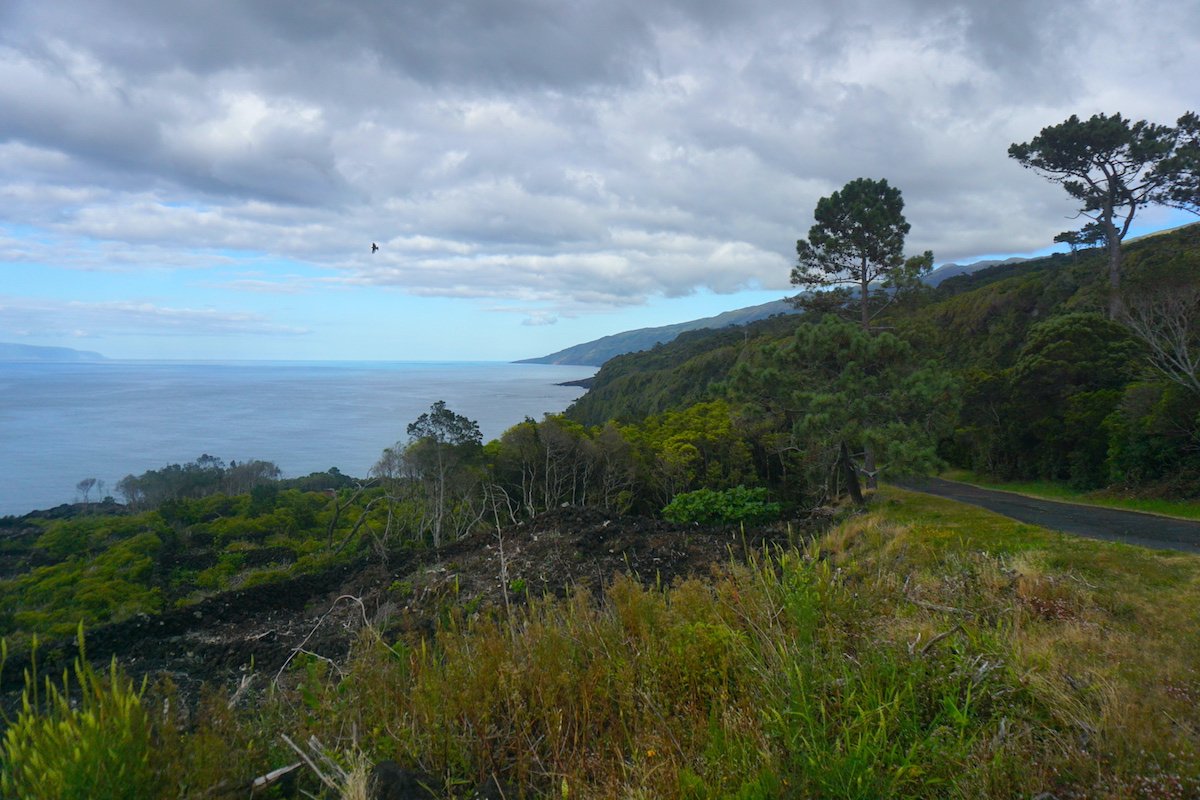
If you want to wake up in Prainha with a panoramic view of the Atlantic Ocean, then you want to stay in one of the 12 traditional cottages of Adegas do Pico (from 100€/night). Book here.
São Roque
What attracted us to São Roque was a restaurant recommended by our friend Joana, Casa Âncora, a building that stands out from the rest, in the middle of the road, with the sea in front. Apparently, it belongs to the same owners of the Cella Bar and, upon entering the design restaurant that reminds us of a Scandinavian place, it is understood. The menu features original and modern dishes made with local products. It was not our gastronomic favorite (what we chose seemed too expensive for what we ate) but the place alone is worth a visit.
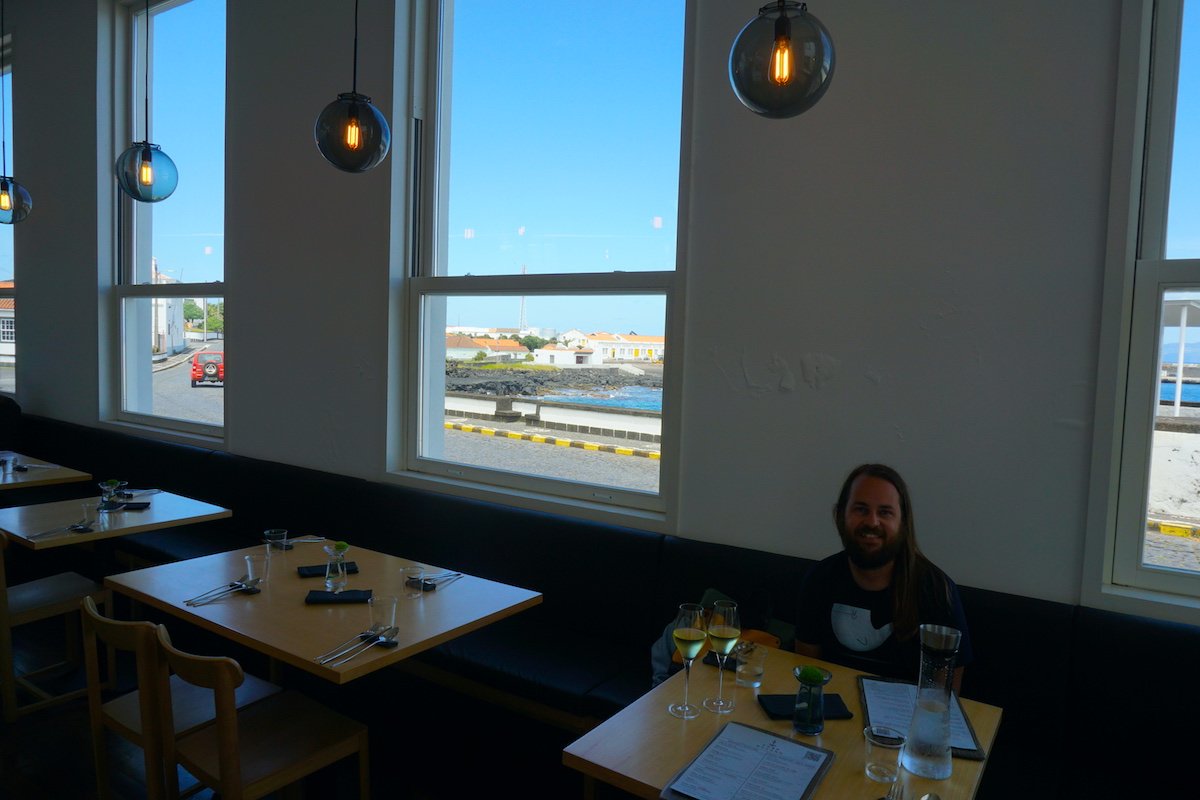
If you feel like cooling off in São Roque, the ideal is to explore its natural pools.
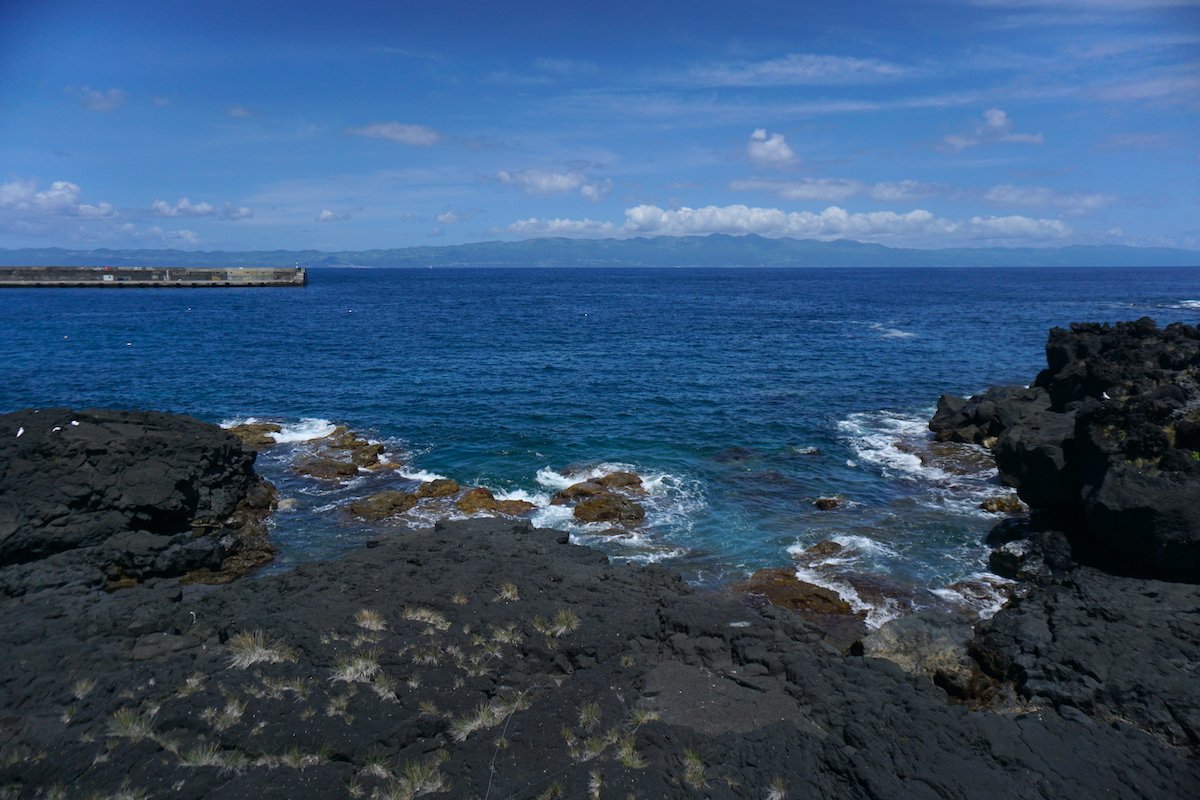
Also in São Roque is the Museu da Industria Baleeira, a former factory of the whaling industry. We didn’t go so we can’t give you first-hand information but if you want to know one of the factories of an industry with a lot of historical importance on the island, here you can see the arsenal (such as generators, boilers, and mills) that were used for the manufacture of flour and various oils from the majestic cetaceans when their observation was motivated by hunting and not to admire them, as it is -happily- today. Admission to the museum costs 2€, is free on Sundays, and is open from Tuesday to Sunday, from 10:00h to 17:30h.

Near São Roque, in its surroundings, there are several treasures. In Santo António, the Furnas de Santo António natural pools are ideal for a dip in peace and quiet, far from the hustle and bustle. Then, also in Santo António and very close to these pools is the Adega A Buraca, a beautiful traditional basalt house that hides a family business of a winery, of course, a small museum, and even a handicraft store.
The other treasure is in Santa Luzia, the Palm Bookhouse Gallery, a project of books, art, and music created by a Canadian lawyer of Portuguese descent (his grandfather was from the island of Pico) which is worth a visit.
The ideal place to stay here is the Casa de Lava (from 70€/night), as the name suggests, it is a volcanic basalt house, with two bedrooms, a garden and sea views, an ideal option for two couples or families with children.
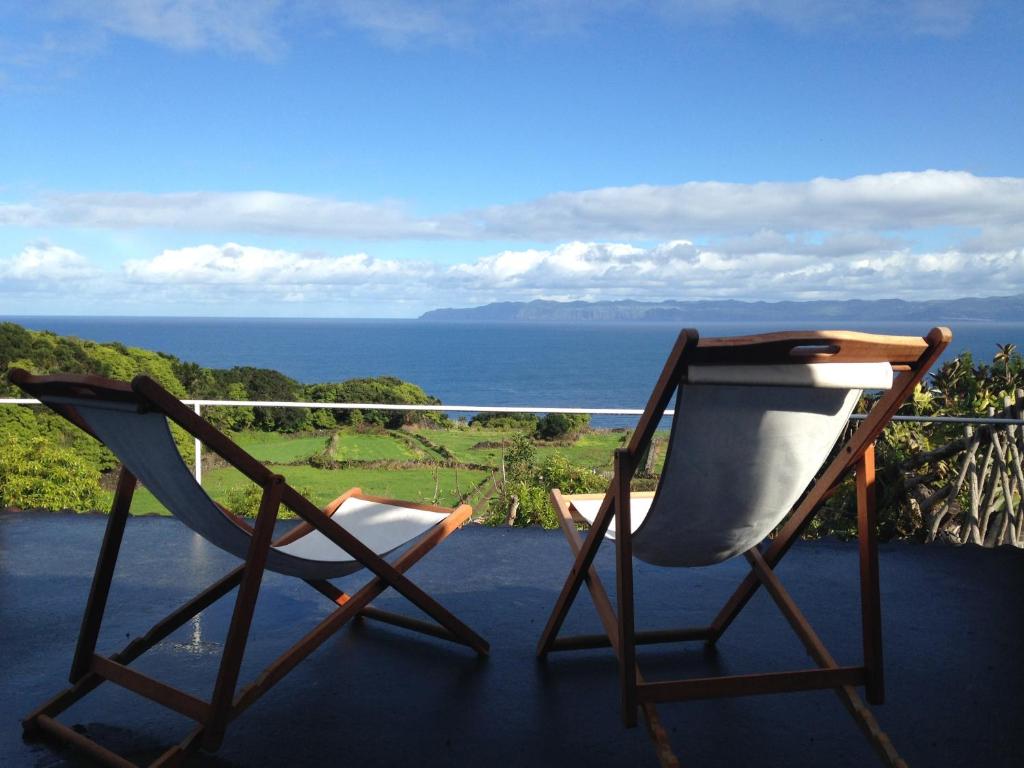
The best hiking trails in Pico
It was in Faial that we promised our friend Tiago to do at least one trail per island and the truth is that we ended up doing several in Pico.
- Climbing Piquinho, the highest point in Portugal. Of course, the best hiking route you can do on the island and one of the most incredible experiences we have done on all our trips. It is not an official trail, although you can do it on your own paying the fees at Casa da Montanha (only for experienced people). You can do the climb during the day, at night, or even stay overnight in the crater. We did it at night with Atipico, we highly recommend it and we tell you all about it here.
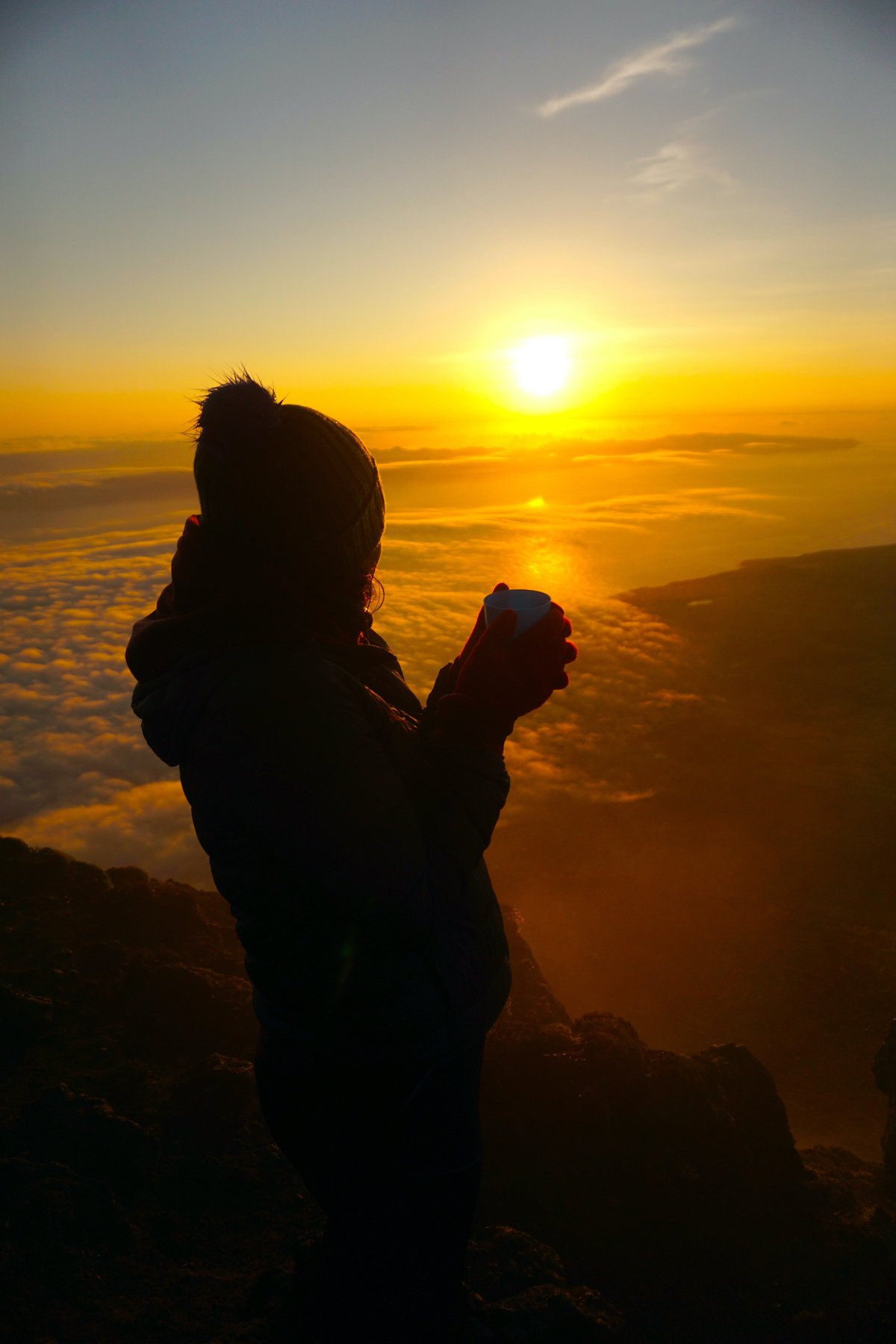
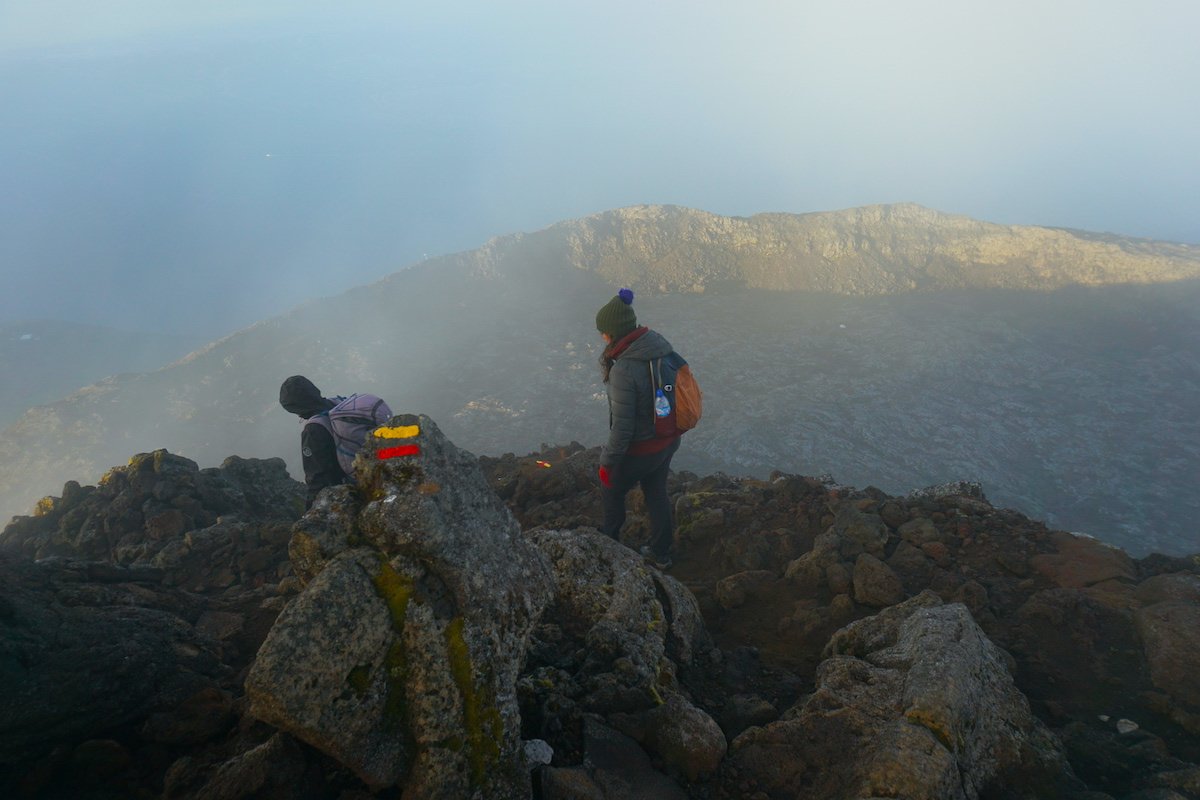
- Criação Velha- PR05 PIC (official info / brochure): Linear route through the Unesco heritage vineyards. It is a very easy route, practically flat, almost always next to the sea and among the vineyards. It was for this reason that we did it the day after the ascent to Piquinho, so as not to spend the whole day resting, as the pain would be worse. It passes by a couple of natural pools and a photogenic mill that can be climbed to better appreciate the views. ideal to go if it is clear and you can see the peak. It is almost 7km and it takes about 2 hours, doing it slowly and stopping for photos.
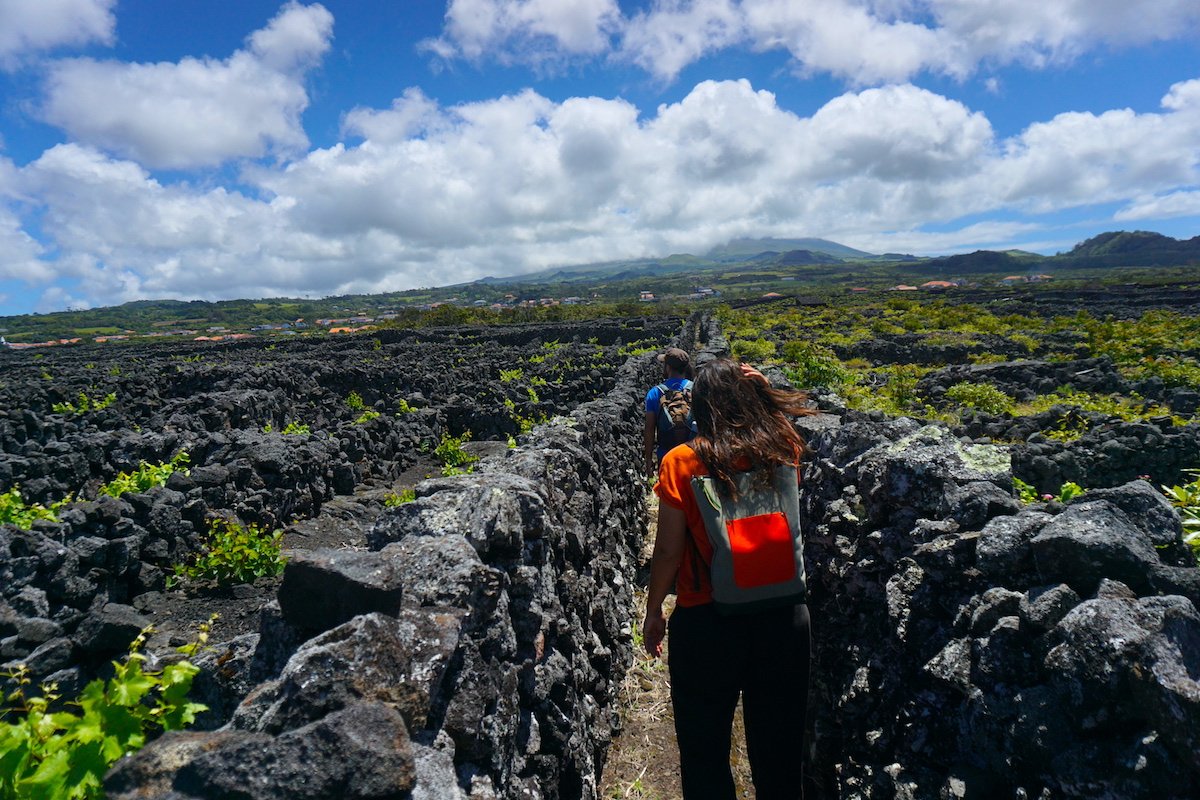
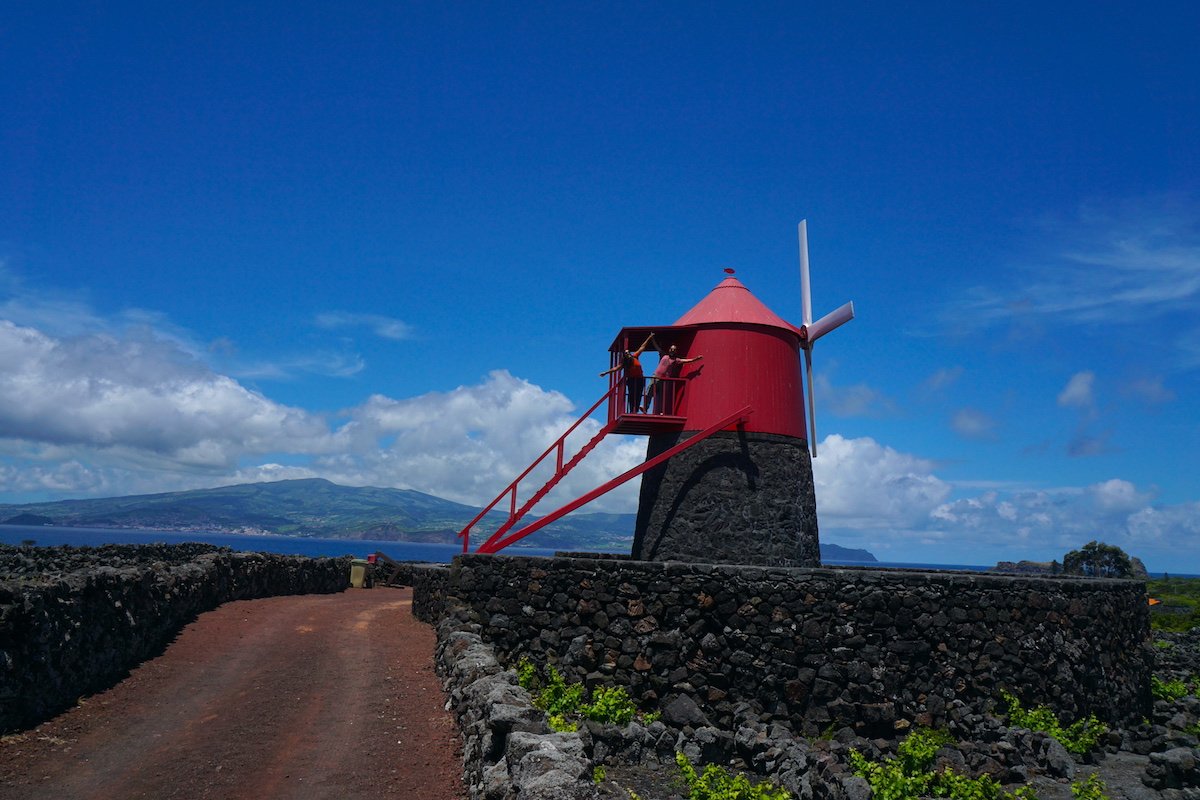
- Calheta de Nesquim – PRC11PIC (official info / brochure): a circular route that we didn’t get to do but was recommended to us by our friends, Joana, Tiago, and Diana. It has nice views (passing by a whale lookout post) and the possibility to take a dip in Poça das Mujas.
- Mistério da Prainha – Caminho dos burros – PR02PIC (official info): approximately 9 km trail that crosses the island from south to north. Along the trail you will see several sites linked to the geological history of the island such as the site where this eruption began, the site known as Cabeços do Mistério, the site of the first eruption, the site known as Cabeços do Mistério and the site of the first eruption of the Prainha.
Where to dive in Pico
On the island of Pico, more specifically between the island of Pico and the island of Faial, there is an incredible underwater world teeming with life and in fact, given the proximity of both islands, it is possible to dive in the Pico-Faial channel, as well as on the east coast of the island of Faial, in addition to several dives on the Pico coast.
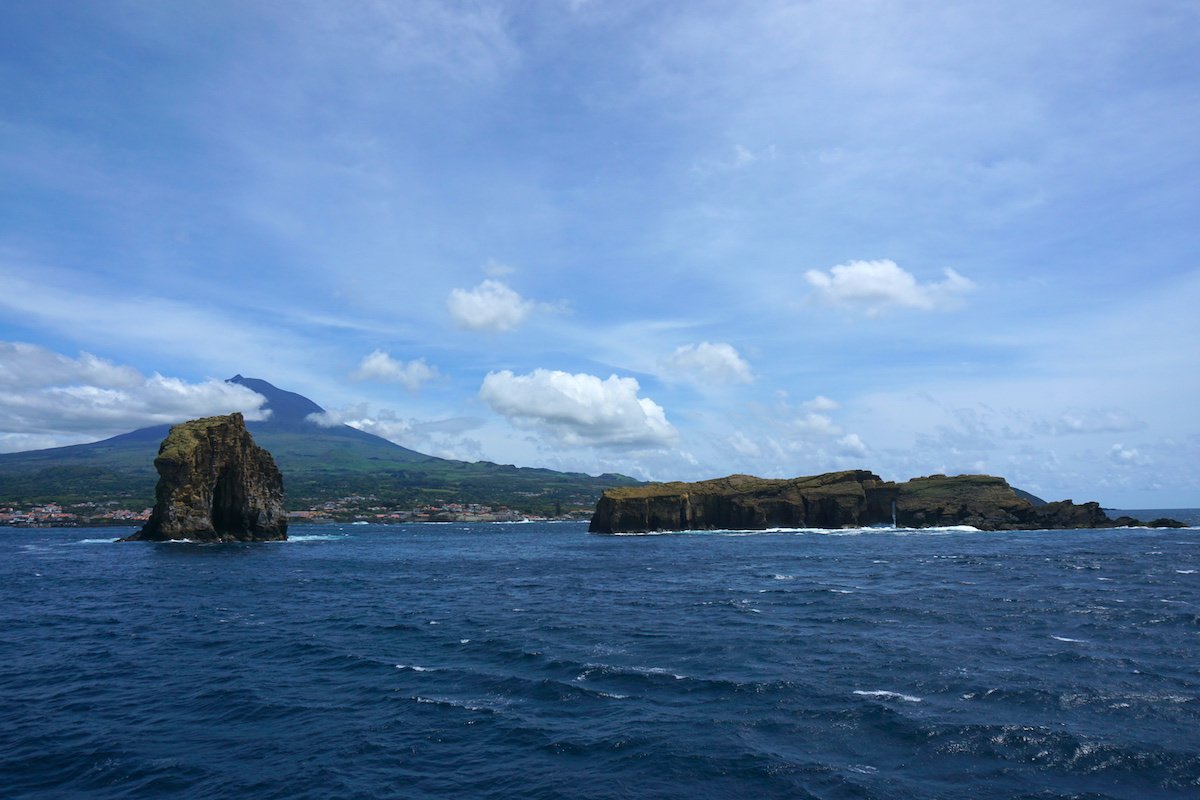
- Condor Seamount: probably one of the most famous dives in Pico is diving with sharks, because the Azores are one of the few places in the world where it is possible to swim with one of the fastest fish in the oceans: the blue shark. Diving with this incredible predator is possible in several islands of the archipelago, however the most visited place and the cradle of this activity is the Condor seamount, located about 10 miles from the island of Faial and accessible from the islands of Pico and Faial (dives around 175€).
- Princess Alice Bank: Pico (like its neighbor Faial) is one of the main starting points of the Princess Alice Bank, located about 45 nautical miles away and considered by many as the best dive of the Azores archipelago, where encounters with large schools of fish, manta rays and even sharks are common (dives around 250€).
- Arcos do Pocinho: the magnificent rock formations surrounding this island cannot be overlooked, with the double arches located at Arcos do Pocinho, perfect for those interested in dives of geological interest.
- São Caetano: the bay of São Caetano is beautiful above and below the sea and this is one of the most interesting dives to do directly from the shore, without the need of a boat. The dive starts at a shallow depth (3 meters), but we can quickly get deeper and at 15 meters, just out of the harbor to the southwest, we find a wall covered with black coral that descends to 60 meters deep where we can see painted moray eels, black moray eels, groupers and solitary dogfish (dives starting from 50€).

This last one, São Caetano, was the dive I had the opportunity to do on the island with CW Azores and the truth is that I just caught the tide change and the day I dived there was very little visibility, very strong currents and ended up being a hard dive in which I saw very little. In addition, I did not particularly like the organization pre, during and post-dive by the center and I found out at the end, paying, that they offered the activity of swimming with dolphins so in this particular case, given my personal experience and knowing that they promote this type of activity, I do not recommend it.
Where to stay on the island of Pico: best areas
Although Madalena (the capital of the island of Pico) is not a point of special interest compared to all that the island has to offer, the area around the capital is a good base for its location to move around the island, for its offer of accommodation and the gastronomic variety. So staying in the capital or nearby, somewhere nicer among vineyards (such as Criação Velha or Lajido) is an excellent option. On the other hand, if your visit to the island is longer than 4 days, it may be a good option to divide your stay between the north (for example: Lajido) and the south (Lajes do Pico) and thus avoid so many trips by car to visit the points of interest. In this section, we recommend the accommodations where we stayed and others that we loved.
Where to stay in Madalena and Criação Velha
We stayed very close to Madalena but not in the capital itself but in a much nicer place, nothing more and nothing less than next to the vineyards of Criação Velha and in front of the sea, in Vinhas do Calhau.
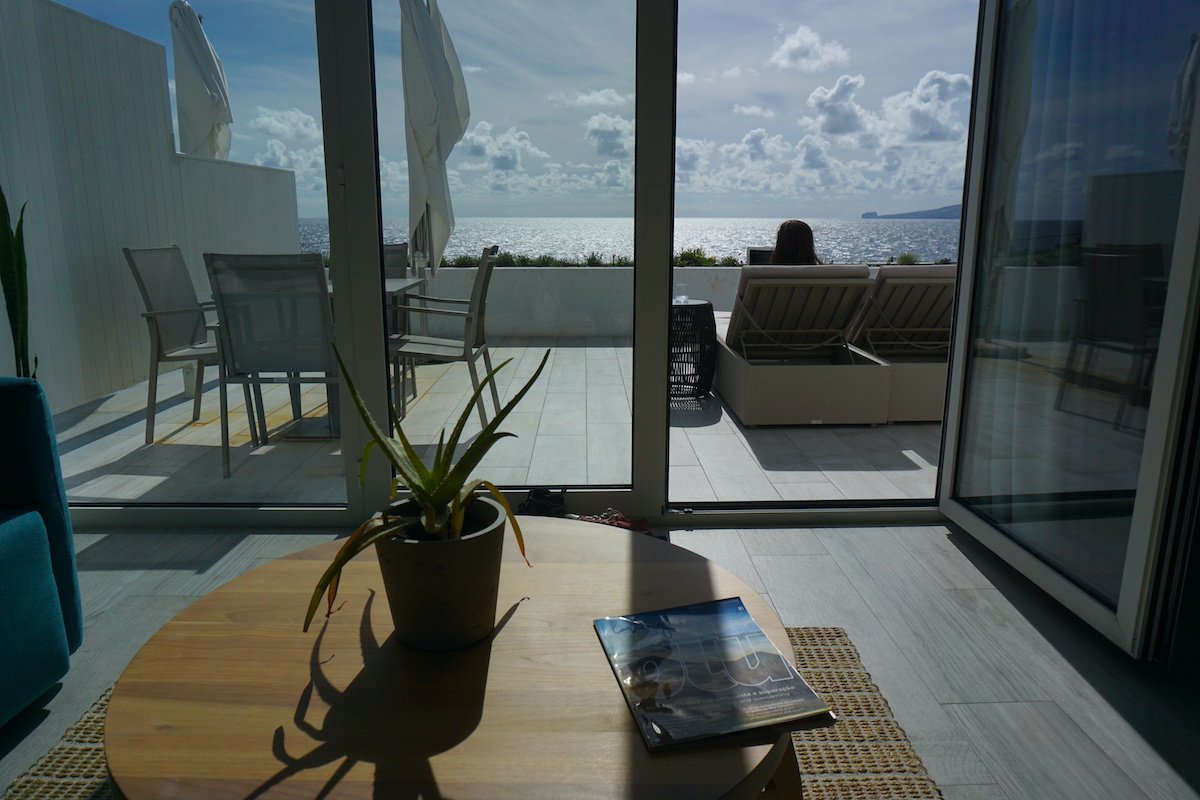
We loved this hotel with several apartments. Ours had an amazing terrace with sea views, a living room and kitchen, and a bedroom and bathroom on the second floor. They brought us breakfast every morning at the agreed time and the only “but” to say something is that we expected a different breakfast for a hotel of this category (several of the products were not local but rather “industrial” as bread and jam). In short, we highly recommend it.

Another incredible option to stay near Criação Velha and the photogenic Moinho do Frade, very close to the Vinhas do Calhau, is Pocinho Bay.
- Pocinho Bay (from 195€/night) are luxurious rooms, with black basalt walls and wooden interiors where contemporary design and objects of yesteryear coexist in harmony. It is located on a former wine and spirits estate and has a swimming pool!
If you want to stay in the very center of Madalena the capital, for example because you do not have a car, there are options such as:
- Porto Velho Boutique Hostal (from 25€/night for a bed or 60€/night for a room): rooms or dorm beds with shared living room, garden and sea view
- My Bed in Pico (from €60): rooms or studios with patio or balcony in the center of the capital city
- Casa do Pico (from 83€/night): a 3-bedroom apartment in front of the sea and near natural pools, with terrace.
- XA Apartments (from 156€/night): 1 or 2-bedroom design apartments with garden and terrace

More options where to stay in the capital or nearby here.
Where to stay in Lajido
Another interesting option to stay (about 10 minutes drive from Madalena) is Lajido, where we stayed the other nights. Here you will literally sleep among vineyards with privileged views of the Pico mountain. However, be aware that in Lajido there are no supermarkets or stores. We stayed in one of the cottages of Baco’s Vineyard (from 49€/night), with pool and jacuzzi in addition to the mountain views as soon as we woke up:
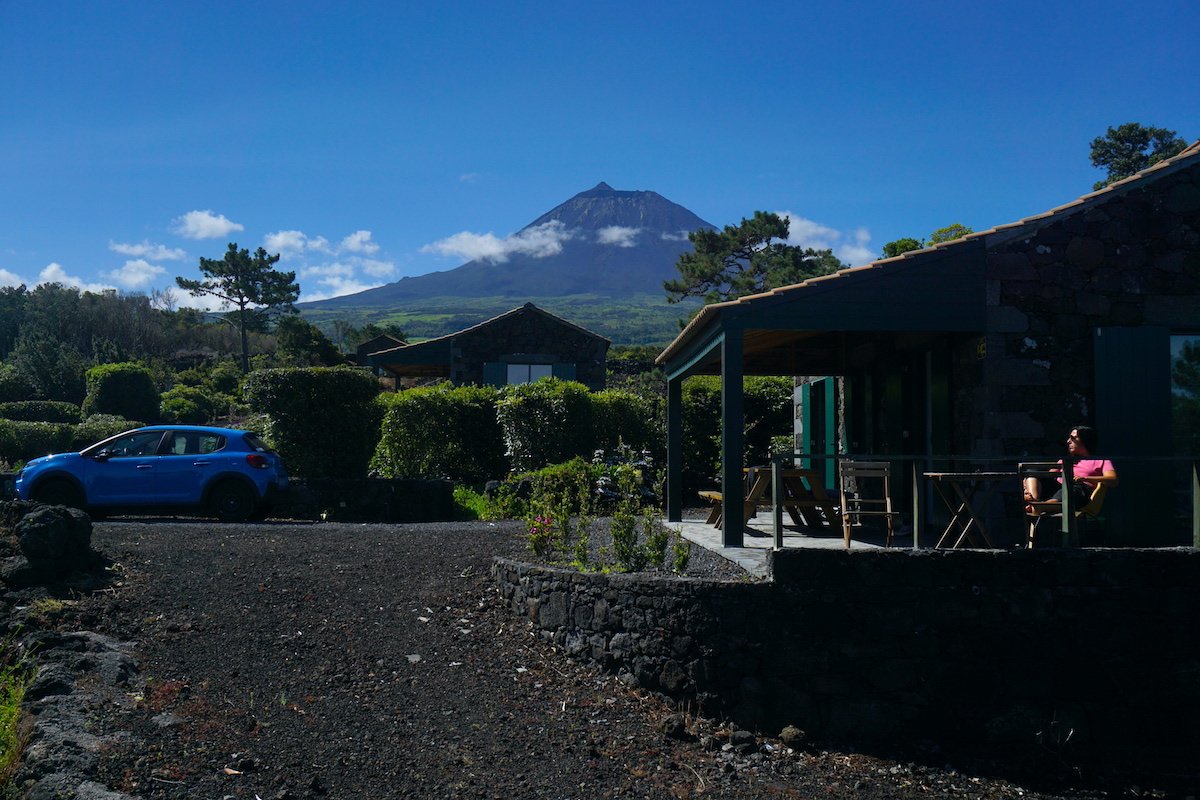
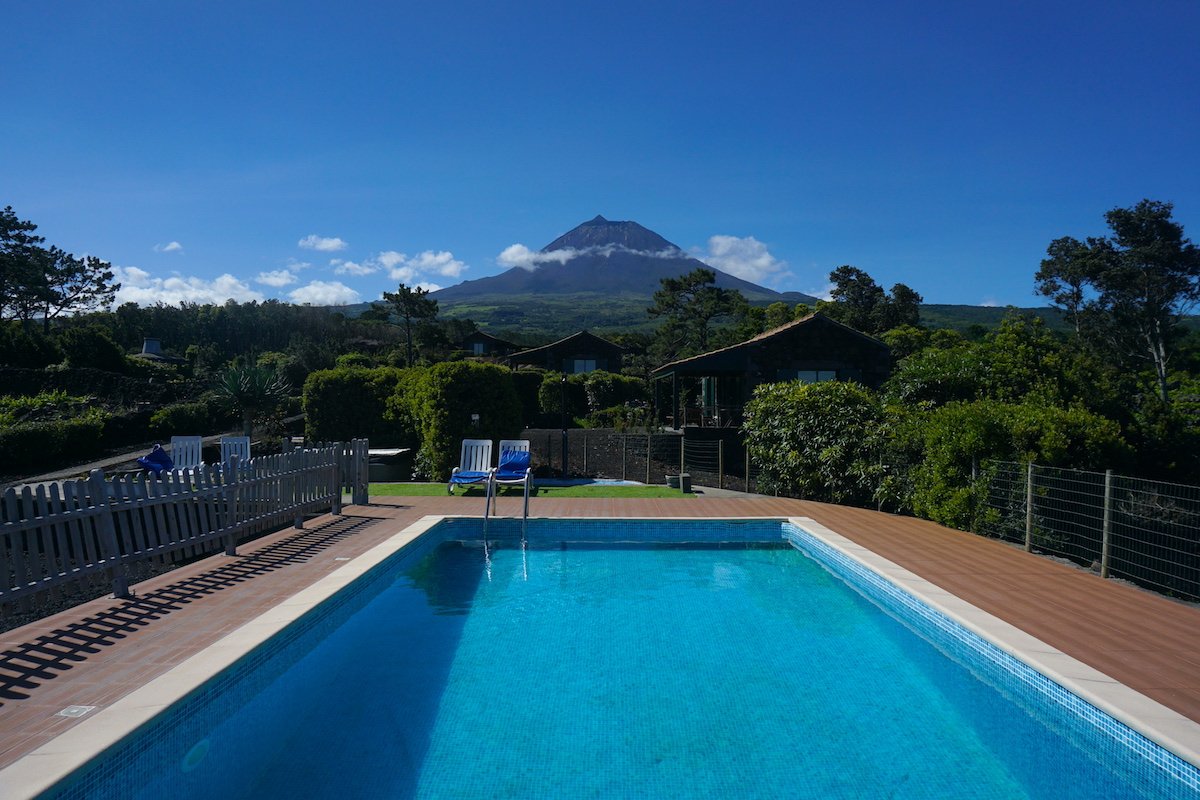
Other options in Lajido are:
- Adega do Xelica (from €60/night): 2-bedroom house with terrace, sea and mountain views
- Paraíso do Triângulo ( from 80€/night): 1-bedroom volcanic cottages with sea and Pico mountain views and a welcome basket with free fruit, wine and breakfast products.

Find more options in Lajido or nearby here.
Where to stay in São Roque do Pico
Another point of the island that also offers a wide variety of accommodations and restaurants is São Roque do Pico. Here we recommend:
- Casa da Lava (from 70€/night), as the name suggests, is a two-bedroom volcanic basalt house with garden and sea view, an ideal option for two couples or families with children.
- Adegas do Pico (from 100€/night): 12 restored traditional houses along Prainha, with panoramic views of the Atlantic Ocean.
- Aldeia das Adegas: 10 houses inspired by traditional island wineries

Find more options to sleep in São Roque do Pico here
Where to stay in Lajes do Pico
Finally, the other place where you can stay, which is chosen by many people and has a wide variety of accommodations is in the south of the island, in Lajes do Pico.
- Alojamento Bela Vista (from 45€/night):
- One bedroom appartement with sea view terrace and wifi (from 131€/night): a 1-bedroom apartment in the center of Lajes, very close to the Espaço Talassa where we did the whale watching.
- Aldeia da Fonte Nature Hotel (from 75€/night): six volcanic stone cottages built on top of a cliff, among gardens. It also has the incredible Fonte Tavern restaurant, a restaurant where you can enjoy modern Azorean gastronomy.
- Casa da Ribeira (from 173€/night): a modern house with two suites (you can rent just one suite or both) overlooking the sea.
- Arte de Fuga (from 500€): a spectacular 3-bedroom house to accommodate up to 6 people where art is predominant on the walls, furniture and even lamps, all cared for with design and care and, of course, an incredible terrace with endless views of the Atlantic.

Find more options to sleep in Lajes do Pico here
Other options where to stay in Pico
In addition to the above centers, if you rent a car you can stay in almost any corner of the island, looking for more rural or different environments (although yes, you will be more limited in terms of dining options nearby). Here are some of the accommodations that we evaluated during our trip and that we will save for another occasion:
- Lava Homes (Santo Amaro): a set of 1, 2 and 3-bedroom cottages on a cliff in Santo Amaro, overlooking the sea. The cottages are excellently decorated, and the space also has a common area with a heated infinity pool and an excellent restaurant (Magma, which we also recommend in this guide). From 160€/night
- Casa do Caisinho (Santo Amaro): one-bedroom house (and sofa bed, up to 4 people) with private pool and sea view. From 120€/night

- Janela do Porto (Prainha): cottage for up to 6 people, overlooking the sea. From 150€/night

- Casinha de Nesquim (Calheta de Nesquim): house with balcony and sea view, for up to 4 people (1 double room and 1 sofa bed). From 100€/night
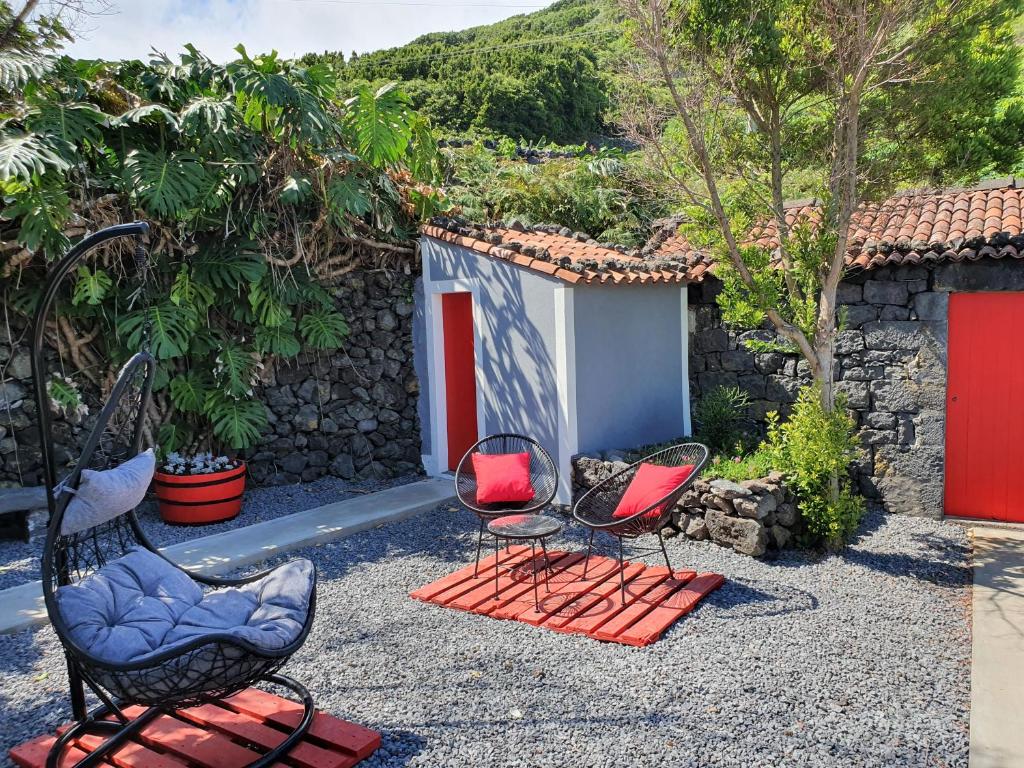
Best restaurants in Pico Island
- Cella Bar (Madalena): More than a bar and restaurant, the Cella is an architectural pearl, or it would not have won the award for the most beautiful bar in the world by the prestigious online architecture platform ArchDaily, in 2016. Ideal for tasting Pico wines (and a good cheese board) since its wine library has 25 wines from the island of Pico alone.



- O Ancoradouro (Madalena): One of the best restaurants on the island (if not the best). Cataplana de cherne, fish brochette, fish fillets and battered octopus and desserts also delicious. Sea views and excellent service. Best to make a reservation. We paid 54€ for two courses, water and a bottle of Pico wine.
- O Petisca (Madalena): Family restaurant with traditional food (fish, limpets, meat…) and petiscos (portions) of very good quality (try erva-patinha and pão de milho frito). At noon they have a buffet to try the most typical although we did not try it because we went at night, for dinner. We paid 44€ for two courses, 3 glasses of wine and 2 coffees.
- Taberna do Canal (Madalena): we found it expensive and a bit insistent that you order more things, so you end up ordering more food. However, the quality was very good (fresh tuna salad and steaks).
- O Cinco-Caffe 5 (Madalena): good steak although the place is tiny. It has more options of sandwiches / bifanas /pregos and salads, we repeated several times (between 25 and 35€ for two people).
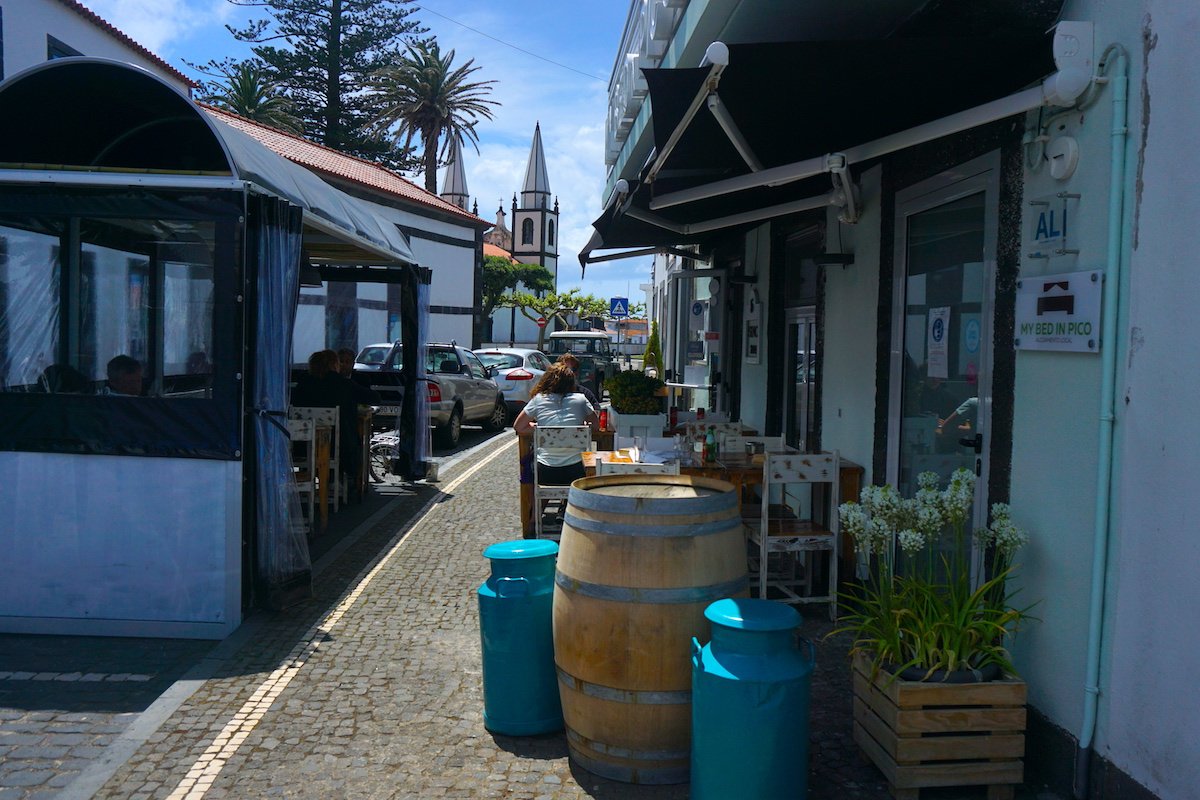
- Mercado Bio: Right in front of Caffe 5, this is the place to go if your diet is vegetarian and vegan. Apart from delicious food (we dined there a couple of times) it has take-away products and even a good selection of local wines.
- Garrafeira da Vila (Madalena) for tasting good Pico wine (especially white)
- Magma (São Roque do Pico): restaurant of the Lava Homes, beautiful views of the sea and São Jorge. 50€ for 2 with two courses and two glasses of wine and dessert.
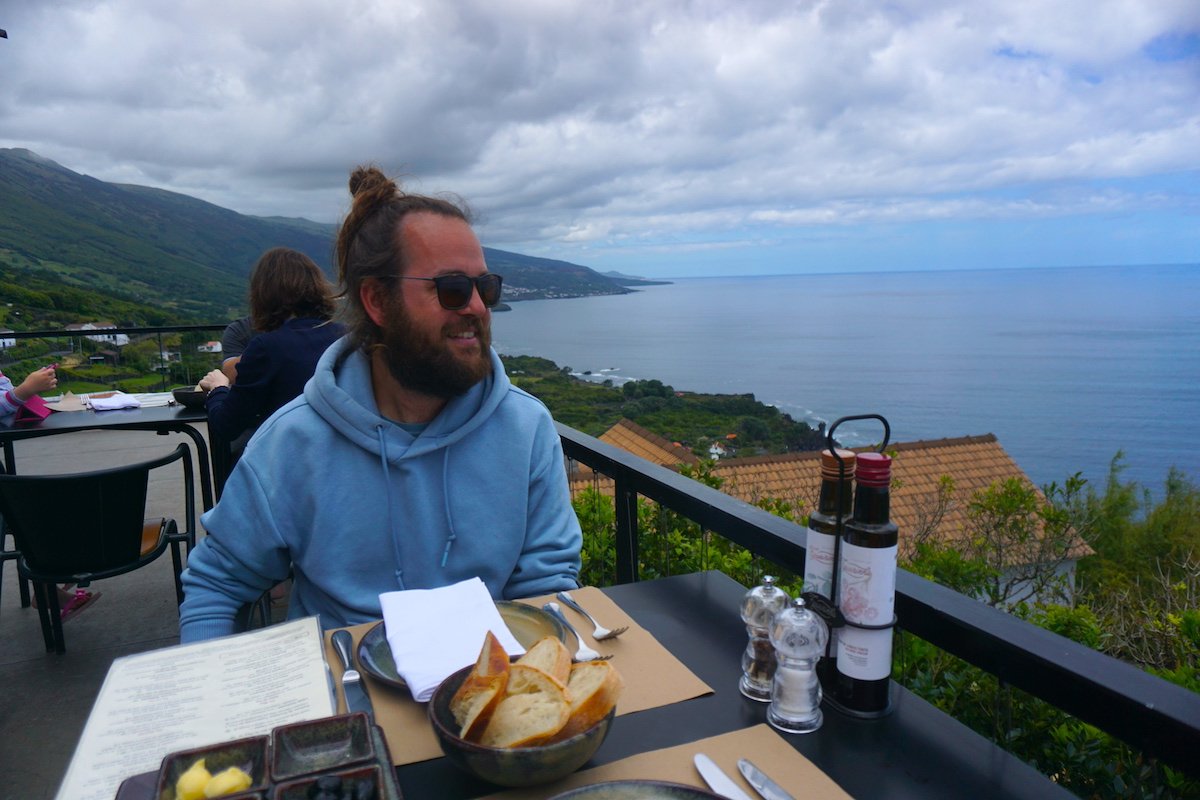

- Casa Âncora (São Roque do Pico): The truth is that although the place is very nice and with a Scandinavian design that you do not expect to find in the middle of São Roque do Pico, we had high expectations and we were a little disappointed. The food is good but average and the prices are a bit more expensive than average. 50€ for 2 appetizers, main course and dessert. The best part was the dessert (brownie)


- Georgette (near Calheta de Nesquim): We booked it for a special evening and loved it. A French couple settled in Pico chose this place with incredible views of the Atlantic Ocean to delight us with their original dishes made with local, organic and seasonal products. The menu changes every week and consists of 3 starters, 3 main courses and 3 desserts (meat, fish and vegetarian). Prices vary depending on how much you order, from 15€ for a main course to 21€ starter+dish+dessert, drinks not included. It is essential to book as far in advance as possible, it is a small place with a wonderful terrace from which, with luck, you can even say hello to a dolphin.
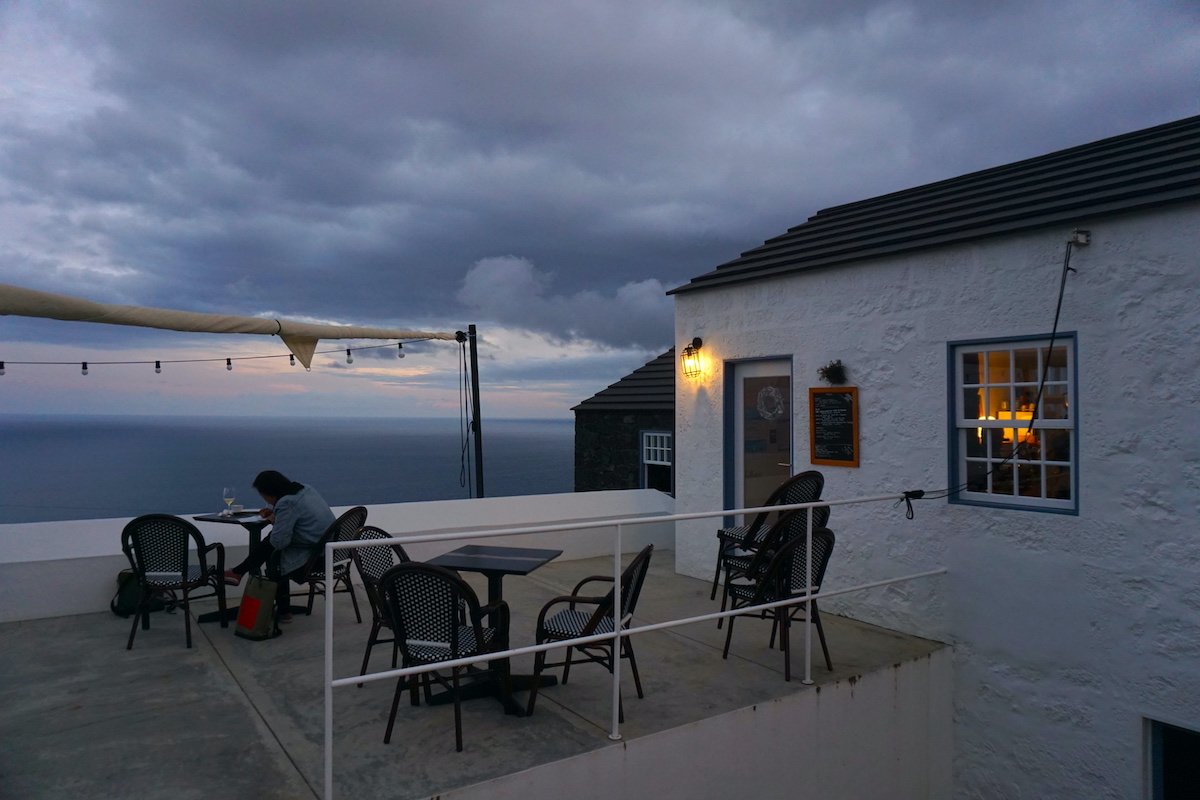


- Fonte Tavern (Lajes do Pico): from the owners of Aldeia da Fonte, tapas place with local products, all original and very tasty, with vegetarian and vegan options. We paid 12€/person sharing tapas with Tiago and Diana.
- Aldeia da Fonte (Silveira): belongs to the hotel, it was recommended to us but we did not go there.
- O Galeão (São Caetano): recommended by Nuno (Atipico) to try the peixe soup.
- Ponta da Ilha (Ponta da Ilha): We didn’t get to go but it was recommended to us at the Vinhas do Calhau lodge.
- Atlantic Brine: It’s not a restaurant, it’s an experience. There is no menu or several tables, it is a dinner with starters, fish, wine, coffee and dessert at Ana and Filipe’s house. The meeting time is at 19h and the dinner lasts approximately 3 hours, as dinners between friends usually last. It can be for 2 people (at 75€/person) or a maximum of 3 or 4 people (at 65€/person). We didn’t go because we discovered it late but we’ve made a note of it for the next time.
Pico island itineraries
As you will have seen if you have read our entire guide, Pico has many incredible places to visit, so to see everything you need at least five days.
Your itinerary will depend on whether or not you are going to climb the Piquinho: if you are, you should reserve a good part of a day for it.
RandomTip: if you are going to climb Piquinho, the weather can greatly influence your experience. Although it is impossible to guarantee that the weather will be good, if you travel out of high season try to have some flexibility to choose the night/day with the best weather (less wind and clouds) for the climb. If you do it with a guide, you will have to communicate beforehand to know availability and if there are more people signed up (in high season you will have to take the risk and book the day in advance, as permits are limited). In our case, we were in Pico in late May, early June (where it was not yet high season), and checking Windy every day, we chose a day where the conditions were very promising (0 wind and 0 clouds), and we were very lucky as the weather was perfect and the visibility from Piquinho incredible to see the sunrise and the nearby islands.
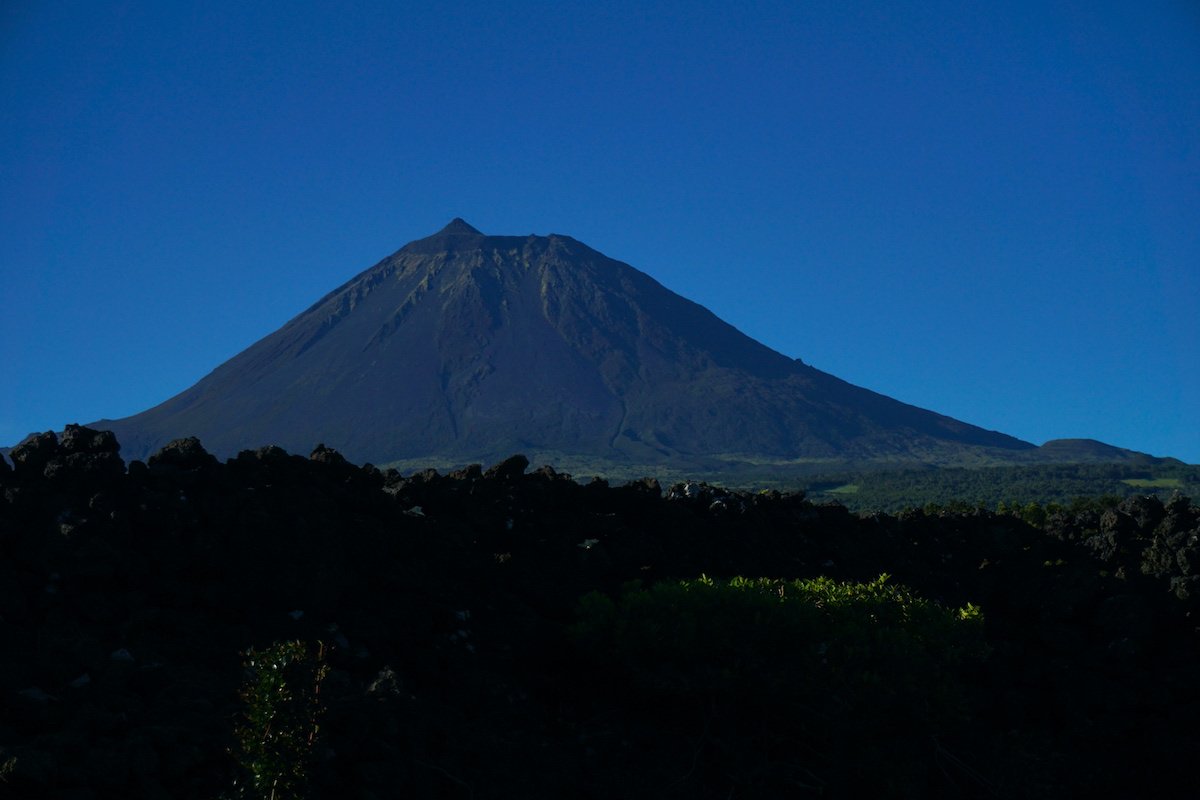
As we do not always have so much time to enjoy the island, we leave you several suggestions of itineraries for 3, 5 and 7 days.
Things to do in Pico in 2-3 days (a weekend)
A weekend is very little time for Pico, so if this is your case we recommend that you choose: either stay in a single area or assume that you are going to spend some time on the road and visit several in a lighter way (in which case, we recommend getting up early!).
Here is an adjusted itinerary for a weekend with a climb to Piquinho.
Itinerary of Pico 2-3 days climbing Piquinho
- Day 1: Arrival and check in at the lodge. Easy trail in Criação Velha, to see closely the vineyards of Pico and the famous red mill with the mountain in the background. Go to bed early to try to sleep a few hours before the climb.
- Day 2: Early morning to climb the Piquinho at night, watch the sunrise at the top and descend. Lunch in Madalena or surroundings and rest the legs from the climb in a natural pool if the weather is good.
- Day 3: whale watching in the morning in Lajes do Pico, choose some other plan for the afternoon if we have time (Museo do Vinho, Gruta das Torres, etc.).

Things to do in Pico in 4-5 days
We believe that 4 or 5 days is the ideal amount of days to visit Pico, trying to explore most of its corners and leaving some time for relaxation.
Here is our suggested itinerary (including the ascent to Piquinho):
4-5 day Pico itinerary climbing Piquinho
- Day 1: Arrival and check-in at accommodation. Visit Lajido and its museums, and lunch/dinner at Magma.
- Day 2: whale watching in the morning in Lajes do Pico, then tour the island’s lagoons and the longitudinal road.
- Day 3: Early morning to climb the Piquinho at night, see the sunrise at the top and descend. Lunch in Madalena or surroundings and rest the legs from the climb in a natural pool if the weather is good. Visit MiratecArts
- Day 4: morning easy trail in Criação Velha, to see the Pico vineyards and the famous red mill with the mountain in the background. In the afternoon, Museo do Vinho and Gruta das Torres.
- Day 5: Calheta de Nesquim circular trail. If you have time to spare, choose an extra plan from this guide.
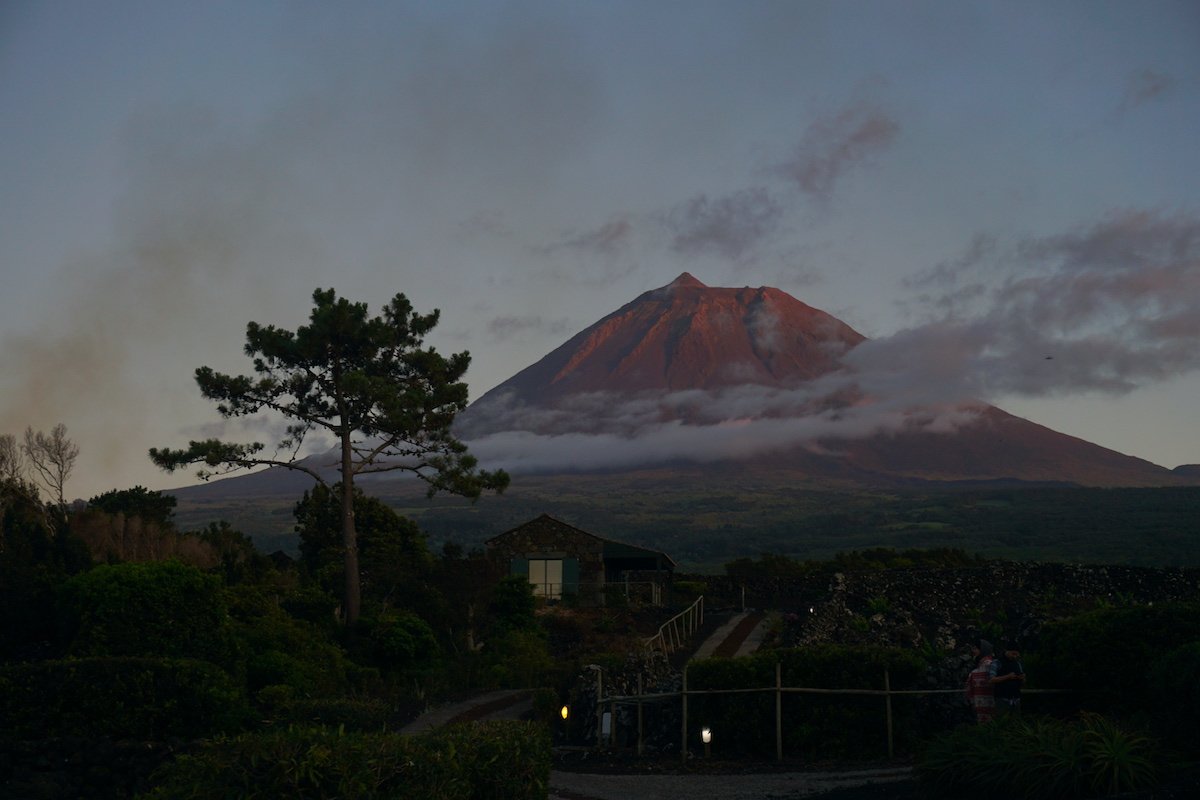
Things to do Pico in one week (7 days)
A week in Pico is the ideal time for the island if you travel in summer (to enjoy its natural pools) or in winter to have margin and flexibility if the weather is not good.
To make your 7-day itinerary in Pico, you can use the 5-day itinerary, add some natural pools and places that we include in the guide or simply make the same plans more calmly, to enjoy the vacation in a more relaxed way.

Transportation: rent a car in Pico
As in all the islands of the Azores, in Pico we consider it essential to rent a car in order to enjoy the island to the fullest, take advantage of the weather, and be able to visit some emblematic places (which are not always accessible by public transport).
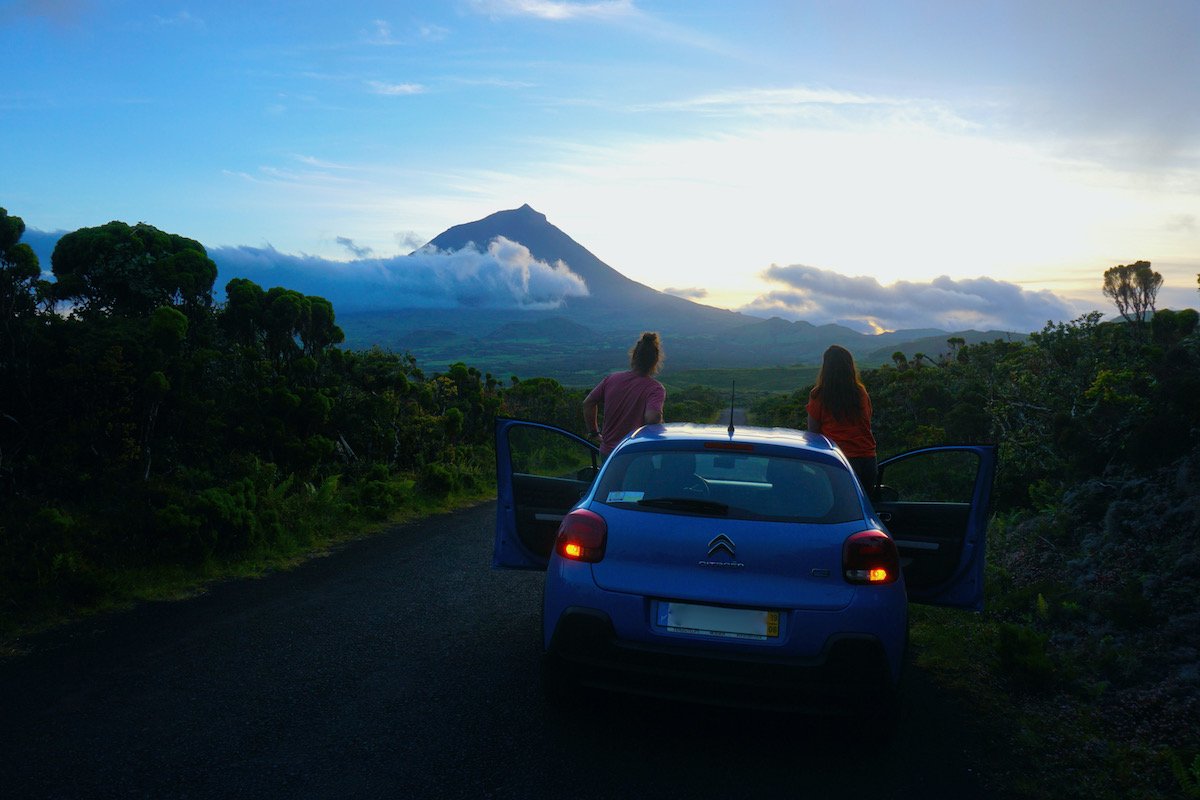
We rented our car with Autatlantis both in Pico and in the rest of the islands, and everything was perfect: the attention on arrival was fast and effective, the car (a blue Citroen C3) was like new and we had no problems. Practically all companies include an excess in the insurance, and Autatlantis is one of those with the lowest excess (700€, compared to 1300-1500€ of other companies).
If there is no availability with Autatlantis, you can check and compare other companies with availability for your dates in comparators such as DiscoverCars. Remember to check the rental conditions of each company (excess, insurance coverage, fuel policy, reviews…) and not only the price.
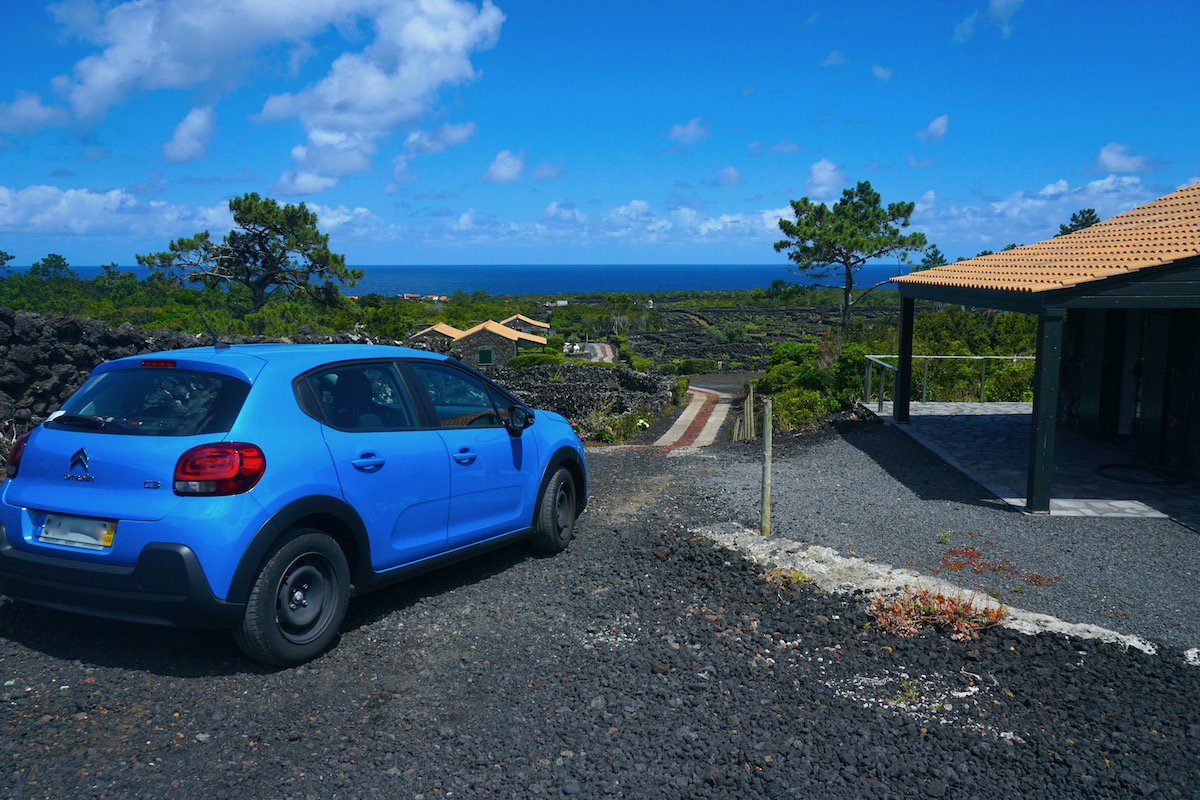
For refueling before returning the car, if you have an early or late flight/boat, there is a Galp 24h gas station (self-service), here
In case you want to do linear trails, the easiest way is to leave the car at the end of the trail and pay a cab to pick you up there and take you to the beginning of the trail. We did this on the Criação Velha trail, here is the cab driver’s contact: Antonio Silva(+351917537913). In case Antonio doesn’t answer or doesn’t have availability, here is the list of all cab drivers on the island.
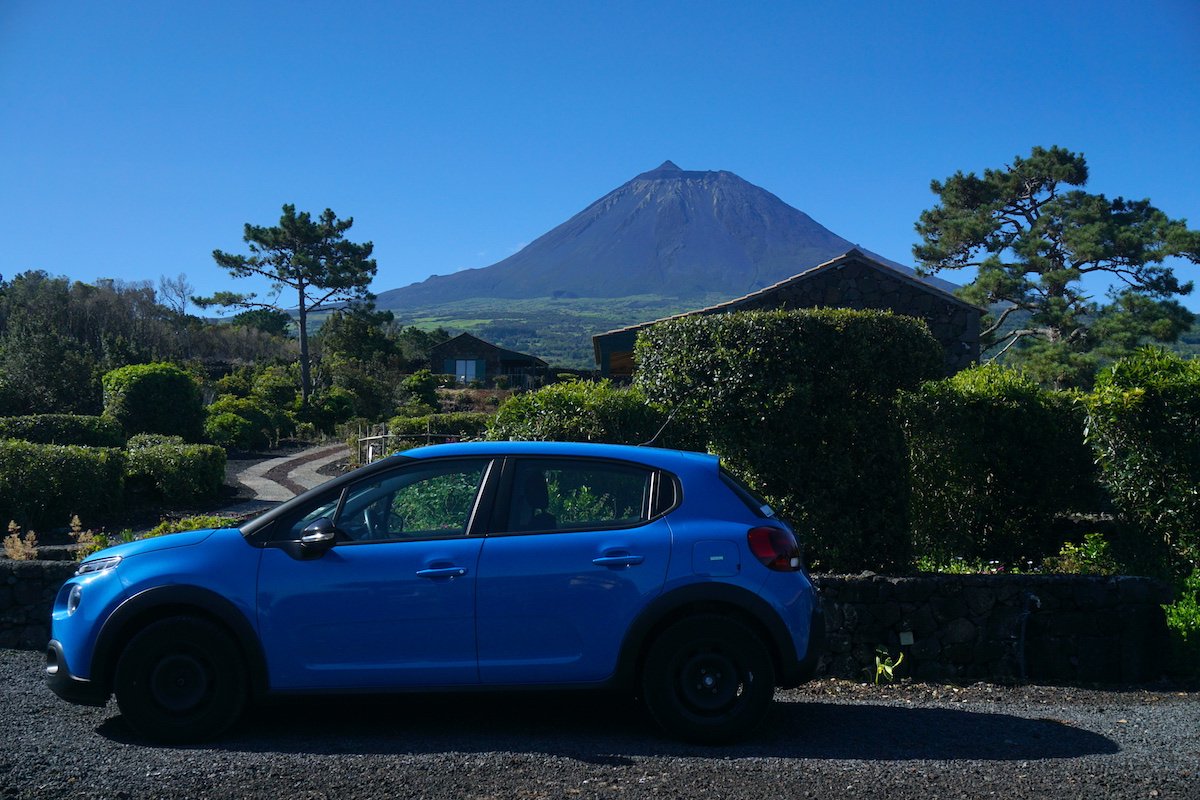
How much does it cost to travel to Pico?
As always, giving a generic budget is very difficult as it depends greatly on your style of travel. What we can do is to give you an orientation of prices and that you calculate your budget with them:
- Flights: You can find flights from 120€ round trip to Pico from Lisbon but it depends on how far in advance you book. If you are traveling from Spain, you will have to add either a trip to Lisbon or a flight to São Miguel (currently only in summer from Madrid and Barcelona) and from there fly with Sata to Pico.
- Car rental: between 25 and 3o€ per day for the cheapest car (depending on the company and the number of days)
- Accommodation: from 45€/night for a room with private bathroom or apartment with kitchen.
- Restaurant meals: between €15 and €25 per person
- Activities: 25€ per person to go up to Piquinho on your own (75€ if you do it with a guide). From 50€ per person for whale watching.
In total, as a guideline, a one-week trip to Pico with a rented car can cost between 500 and 700€ per person (with the cheapest options of car, accommodation and restaurants) depending on meals out and whether you climb Piquinho on your own or with a guide.
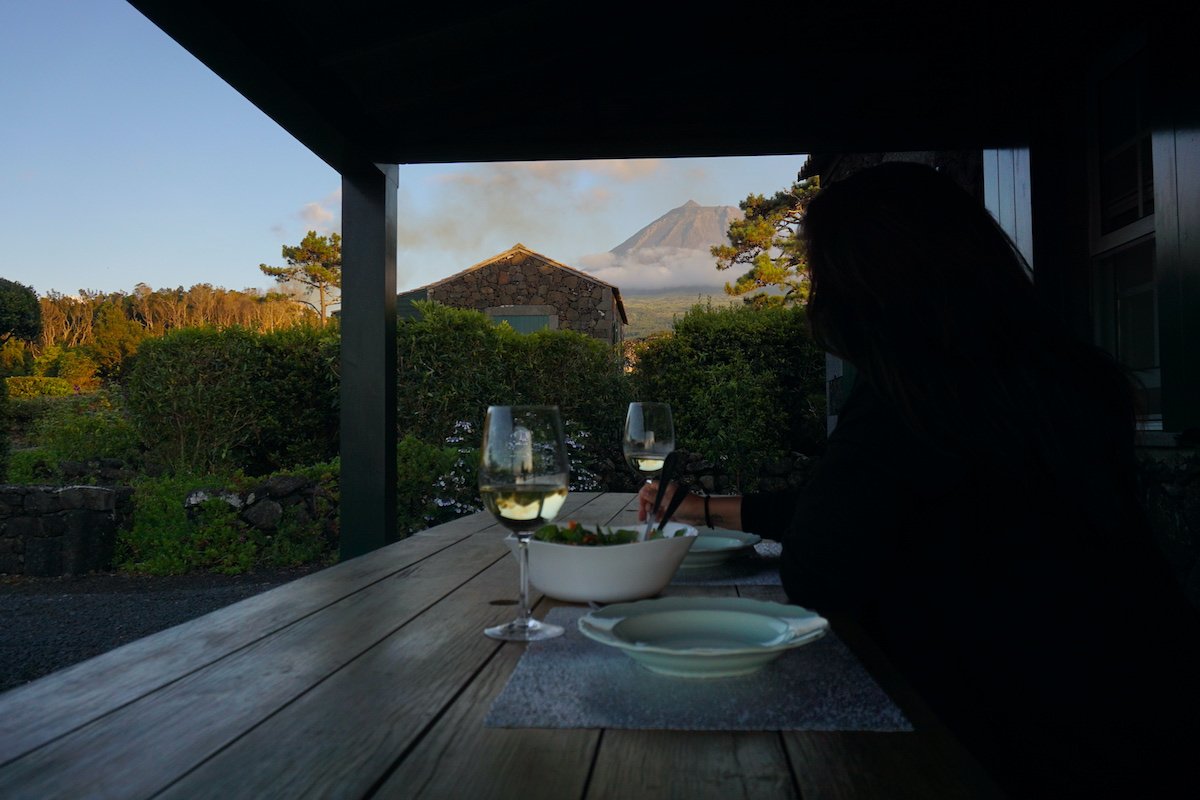
Useful Apps for traveling to Pico Island
We recommend some applications to install on your cell phone that will be useful for your trip to Pico:
- SpotAzores (Android / iOS / Web): here you can see all the existing webcams in different points of the islands to see how the weather is. Because the weather is very changeable and it can be raining in one part of the island and sunny in another, this app is the fastest way to make sure and avoid unnecessary trips.
- Windy (Android / iOS / Web): essential app in our trips, even more so in the Azores. It allows you to see forecasts for rain, clouds, wind, etc. to help you plan your days based on the weather (as there are places that lose a lot depending on the weather). Obviously the forecasts are not 100% reliable. It also shows the available webcams
- GoogleMaps (Android / iOS): is the one we use to save / classify all the places we want to go / have gone and as GPS in rental cars. You can see other people’s opinions of the places, photos, restaurant menus, phone number of the places to contact them, etc.
- Maps.me (Android / iOS): application similar to Google Maps but works offline (although Google Maps can also work offline) and in many cases has information that Google Maps does not have, especially trails. Useful whenever you are going to do a trail, to orient yourself, download the route from the official website of the Azores trails (click on Downloads->GPS), etc.

Recommendations to enjoy Pico
- In the whalewatching activity, respect the behavior indicated by the center and be suspicious if it does not involve measures such as: prohibition of swimming with dolphins; reduced and constant speed of the boat and a minimum distance of 50 meters from the animal; avoid the presence of several boats within a radius of 150 meters around the group of cetaceans and do not stay more than 10 minutes with the same animal.
- Do not allow the disturbance, pollution and destruction of seabird nesting habitats. The “cagarros” are a migratory bird that nests in the Azores and that on your trip will sound to you by their particular song of “awa awa” as if they were singing the chorus of the song Video Killed by Radio Star. In order to avoid situations where young shearwaters are captured or run over on the road, the Government of the Azores annually promotes the SOS Cagarro Campaign, which we recommend you to know when you arrive in the archipelago.
- Never try to touch or feed an animal – don’t be an accomplice to animal abuse!
- Do not buy handicrafts made from sea animals or extracted from the sea (e.g. dolphin teeth, turtle shells, shark jaws, sperm whale ivory, …). The ivory trade, currently the only valuable product of the sperm whale, is still an argument for hunters. Buy local handicrafts made from alternative materials such as wood, stone or vegetable ivory.
- If you visit the island in summer and enjoy the sea, remember that sometimes you may encounter a jellyfish (aguaviva) or a Portuguese caravel whose sting is painful and dangerous. The good thing is that these last ones float and are easily detectable, but in case you see one, get out of the water immediately and warn other people of their presence. In case you have been stung by either of them, it is very important that you follow these official recommendations: do not scratch the area of the sting (to prevent the venom from spreading); do not clean with fresh water or alcohol, clean only with sea water and very carefully; and in case the sting is a Portuguese dogfish sting, seek medical attention as soon as possible.
- Respect other people and the island: don’t play your music loudly on the beach or natural pool (if you want to listen to music, bring headphones), don’t leave trash, don’t throw cigarette butts, etc. Leave the beach better than you found it (if you find plastic, pick it up).
- In some areas bathing can be dangerous due to strong currents. Don’t be brave.
- Always travel with travel insurance: medical expenses, theft or problems with your plane on a trip can cost you a lot of money, so the ideal thing to do is to take out travel insurance. We always use IATI and we recommend it. If you purchase your insurance through this link you have a 5% discount.

Checklist: what to pack in your backpack/suitcase for Pico
Here is a list of must-haves you can’t forget to take with you on your trip:
- If you are going to make the ascent (and descent) to Piquinho, the highest point in Portugal, remember all the essentials you should take with you, which we discuss in the specific section here.
- Reef friendlysunscreen, i.e. free of coral-damaging chemicals, oxybenzone-free, and not tested on animals, such as this one or this one.
- Cap, the sun is very strong
- Sunglasses
- A water bottle like one of these to always carry water with you. Are you on the island of waterfalls and great water! Take advantage of it! In addition, you will avoid using single-use plastic.
- A neck brace like one of these to protect you from wind and sand.
- Long sleeve lycra T-shirt with UV protection that we wear to protect us from cold water or the sun when snorkeling, such as one of these.
- Snorkel kit/glasses. Here is a kit for less than 20€.
- Watertight bag, to keep your electronic devices safe on boats (when you go whale watching). This one for example costs 12€.
- Microfiber towel, which occupies little and you will use for the beach. If you don’t have one, you can buy the typical ones from Decathlon or these ones on Amazon
- Camera to record the majoreras adventures. We carry a Sony A5100 and a GoPro for underwater images.
- Power bank: with so many photos you will spend a lot of battery, so it always comes in handy to carry a good power bank. We travel with these 2(Xiaomi and Anker), which allow us to charge our smartphones, camera and GoPro.
- First-aid kit: ourfirst-aid kit includes a medicine against seasickness (such as biodramine for sea sickness on boats), antibiotics, antidiarrheals (and some probiotics to recover more quickly), antihistamines, analgesics and antipyretics.
Although you are on an island where most of the visitors come to hike or climb the Piquinho, when we went in June the only two sport stores on the island had absolutely nothing necessary to climb the mountain (jackets, boots, down, thermal shirts, hats, gloves, for example). In other words, if you visit the island in spring or summer and you have not come prepared to climb, in the store you will not find anything for winter or for climbing mountains. Nor for puddles, there was no way to find goggles and a snorkel. Go to the island with everything you need or make sure that whoever you do the climb with can lend you the material, who warns is not a traitor.

With your magnetism, Pico, it happens to us as with good friendships: it will not be a“longe da vista, longe do coração” (“far from sight, far from the heart”, as the Portuguese expression goes). Even if we keep looking for you with our eyes since we said goodbye, we will always carry you inside.
“Ninguém é tão estrangeiro em lugar algum como quem volta ao lugar da infância depois de longos anos de ausência.”
“No one is so strange in any place as someone who returns to the place of his childhood after long years of absence.”
Judite Jorge, poet, was born on the island of Pico in 1965.
We would like to thank two very nice Nunos. To Nuno from Atipico, thanks to whom the ascent (and especially the descent) of Piquinho was not only enjoyable but also a lot of fun. And to Nuno from Turismo de Pico for the compliment on our work and for helping us to rectify a couple of data that were incorrect in the guide.
Disclaimer: Autatlantis helped us explore Pico Island with one of their vehicles but all opinions and information expressed in this post are our own.
